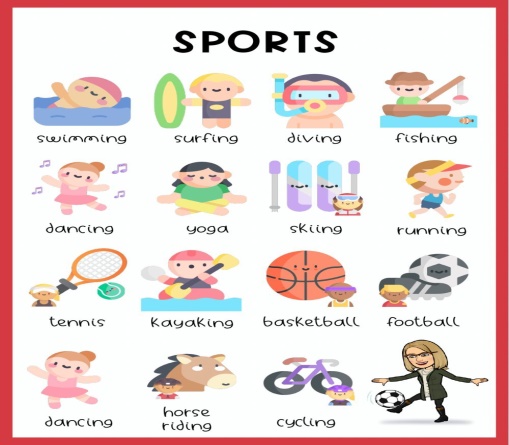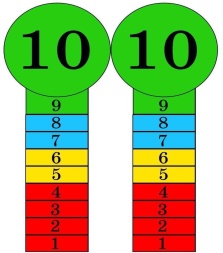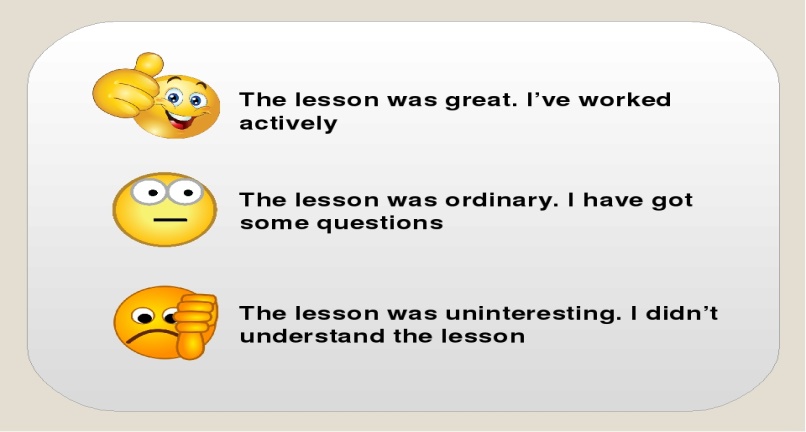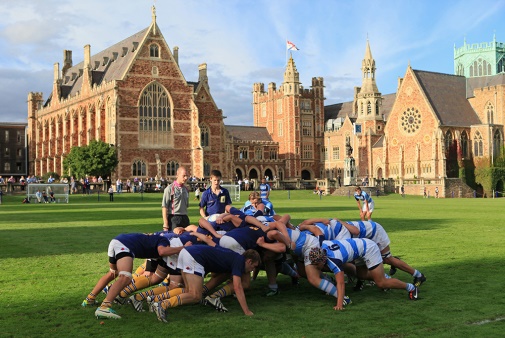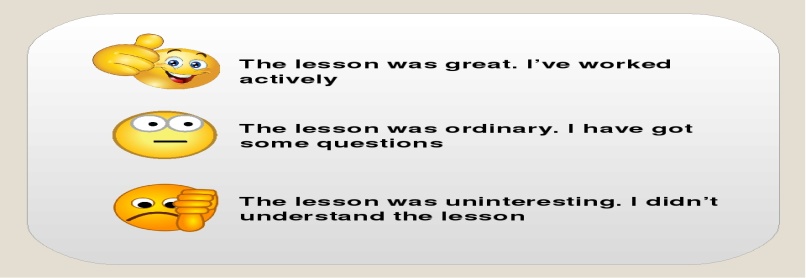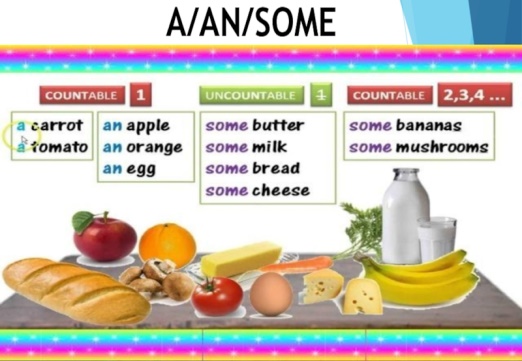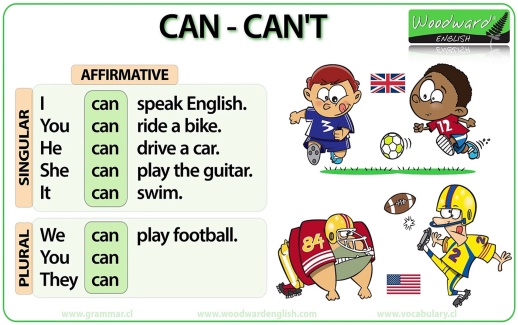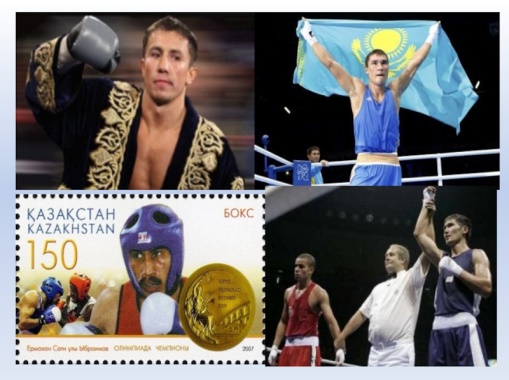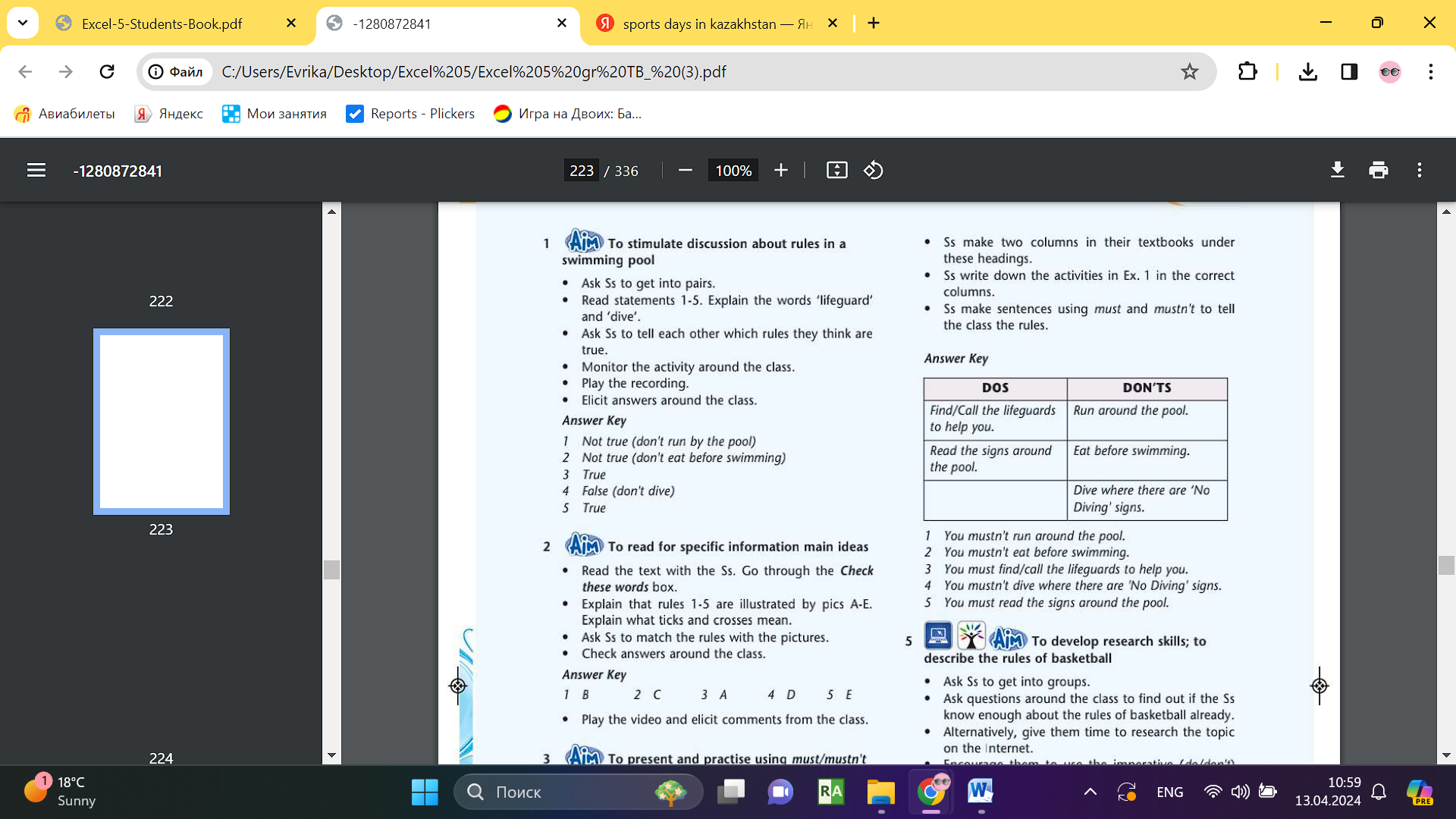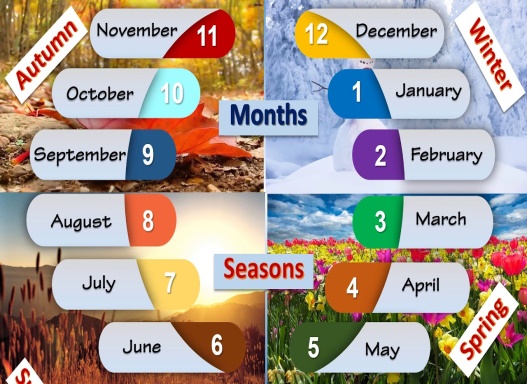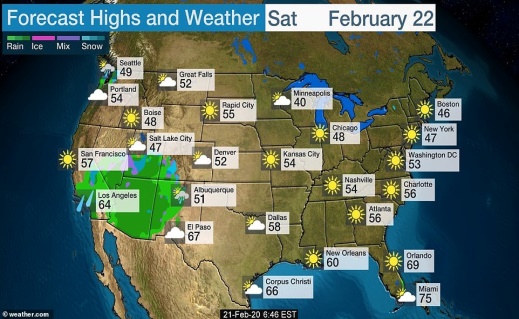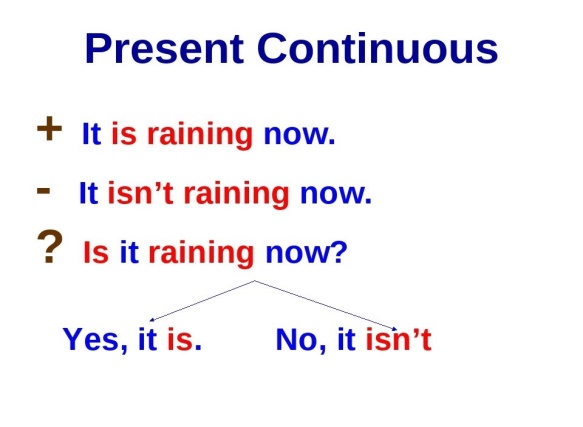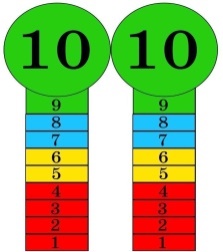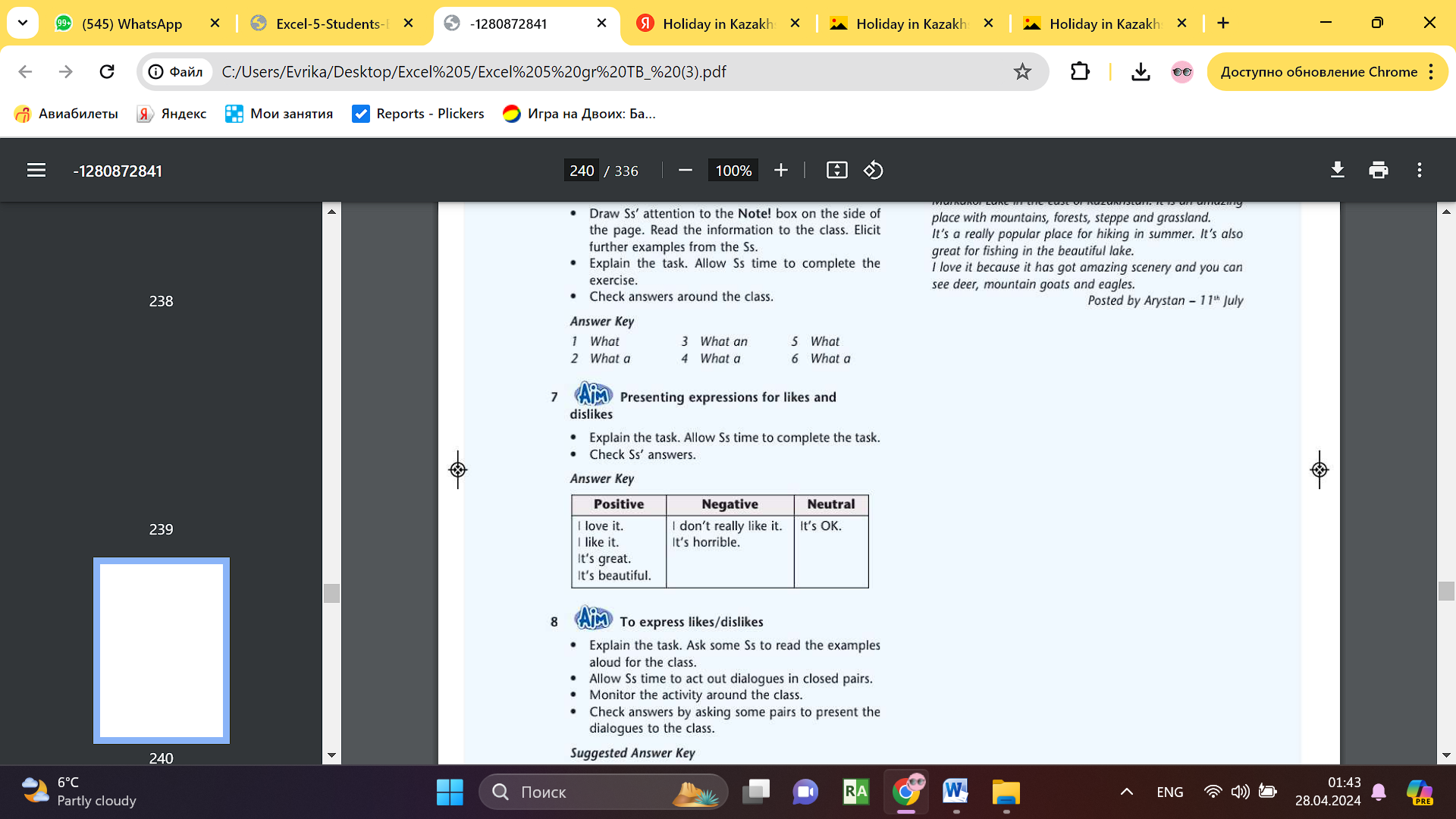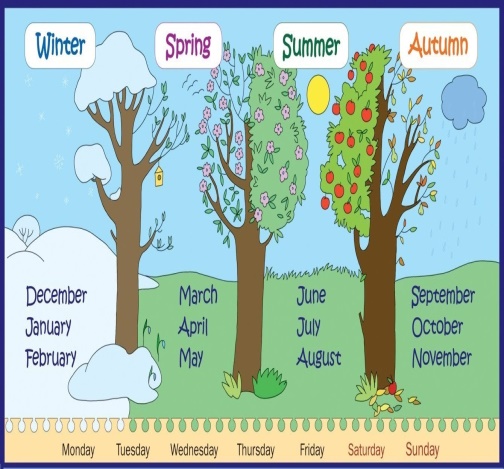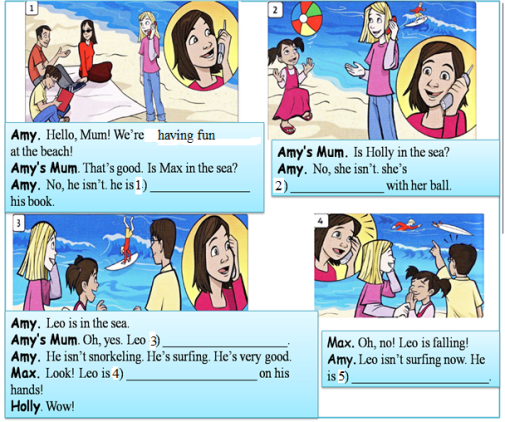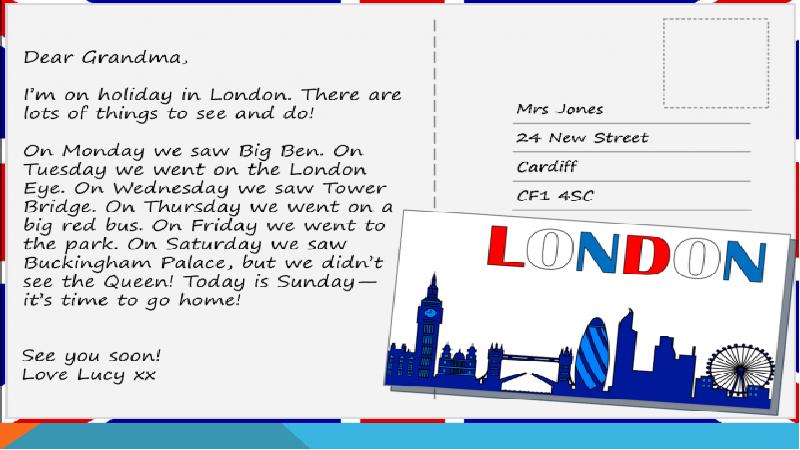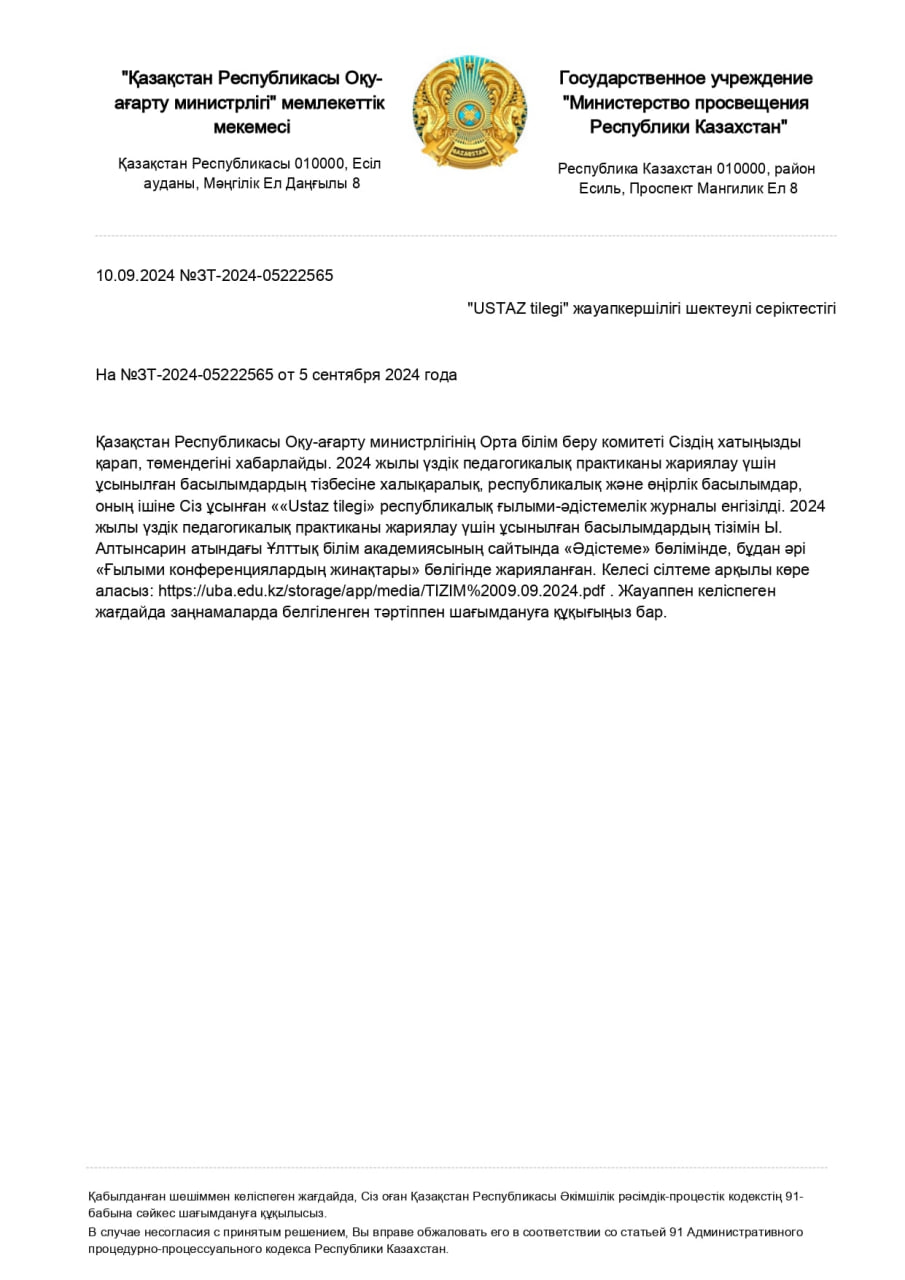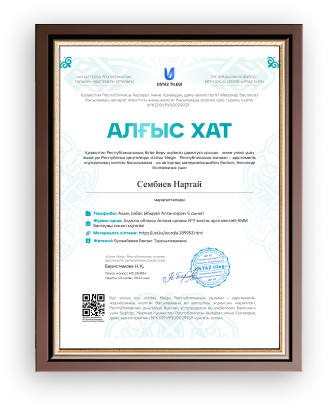
Short term plan: term 4
|
Unit 8: Sports |
Lesson 81 |
||
|
Teacher name: |
|
||
|
Date: |
|
||
|
Grade: 5 |
Number present: |
absent: |
|
|
Lesson title |
Sport activities |
||
|
Learning objectives |
5.2.2.1 understand an increasing range of unsupported basic questions which ask for personal information; 5.3.4.1 respond with limited flexibility at sentence level to unexpected comments on an increasing range of general and curricular topics; |
||
|
Lesson objectives |
Learners will be able to: - present vocabulary about sports - present adverbs of frequency |
||
|
Value links |
Hospitality: Traditionally a nomadic culture, hospitality has always been an important part of Kazakh culture. |
||
|
Plan |
|||
|
Stages / Time |
Teachers actions |
Students actions |
Assessment criteria |
Resources |
|
Beginning of the lesson Warming-up
3 min. Pre-learning «Brainstorming» method 7 min. |
Organization moment : 1.Greeting. Ask about the weather. The teacher sets the lesson objectives, letting students know what to anticipate from the lesson. Warming up Where are you from? How old are you? What color is it? How many students are there in class? What day of the week today? Lead – In
|
The aim: To develop pupils speaking skills and create friendly atmosphere Efficiency: By wishing each other they feel better and feel the support of others Students of the class are listed. Students' attention is drawn to the lesson. Students say different words from the picture •Learners remember previous lesson vocabulary •Learners answer the questions |
The teacher to assess learners for their ability. “Good job! Well done!” Formative Assessment
Good job! Assessment criteria make basic statements related to personal information, people and objects on familiar topics |
Pictures worksheet Picture |
|
Middle of the lesson Presentation part. 30 min |
Ex:1 P: 97 • Play the recording with pauses for Ss to repeat chorally and/or individually. Check Ss' pronunciation and intonation. Explain to students that with some sports we use play (I play tennis, you play football, etc.). With other sports we use go (I go swimming, you go cycling, etc). Students say the names of the sports in Kazakhstani and say if the words are similar to English. Ex: 2 P: 97 • Explain how the percentages on the graph represent how often a thing happens or is done. Read the example to the class. Explain that this means that around 25% of your sporting activity is football. Ask Ss to get into pairs and make similar statements. Monitor the activity. Elicit answers from around the class. Conclusion during the lesson some tasks differentiated by outcomes of the students and by their abilities. |
• Learners listen and repeat. Answer the question. ANSWERS Students’ own answer • Learners tell your partner. Use adverb of frequency. ANSWERS I never go swimming. I usually play cricket. I always go cycling. I often play basketball, etc |
Descriptor: - repeat chorally and/or individually - answer the question Total: 2 point
self assessment Differentiation: «Verbal support» method is used to help Ss use new words in the sentences. Descriptor: - read the example - use adverb of frequency Total: 3 point -Make CCQ questions Yes / No |
Card Worksheet Students book |
|
End of the lesson 5 min |
FEEDBACK Learners provide feedback on what they have learned at the lesson. Ex: P: Home task: Write the days |
|
Poster Success
|
|
Short term plan: term 4
|
Unit 8: Sports |
Lesson 82 |
||
|
Teacher name: |
|
||
|
Date: |
|
||
|
Grade: 5 |
Number present: |
absent: |
|
|
Lesson title |
Reading: Glasgow school of sport |
||
|
Learning objectives |
5.2.4.1 understand the main points of supported extended talk on a range of general and curricular topics 5.4.1.1 understand the main points in a limited range of short simple texts on general and curricular topics 5.3.2.1 ask simple questions to get information about a limited range of general topics |
||
|
Lesson objectives |
Learners will be able to: - present a school of sport; predicting the content of a text - read for specific information; comprehension - consolidate information learned from a text |
||
|
Value links |
Tradition: Kazakh traditions and culture have been passed on from one generation to another through oral histories told by traditional Kazakh tribal leaders and elders. |
||
|
Plan |
|||
|
Stages / Time |
Teachers actions |
Students actions |
Assessment criteria |
Resources |
|
Beginning of the lesson Warming-up
3 min. Pre-learning «Brainstorming» method 7 min. |
Organization moment : 1.Greeting. Ask about the weather. The teacher sets the lesson objectives, letting students know what to anticipate from the lesson. Warming up Where are you from? How old are you? What color is it? How many students are there in class? What day of the week today? Lead – In
|
The aim: To develop pupils speaking skills and create friendly atmosphere Efficiency: By wishing each other they feel better and feel the support of others Students of the class are listed. Students' attention is drawn to the lesson. Students say different words from the picture •Learners remember previous lesson vocabulary •Learners answer the questions |
The teacher to assess learners for their ability. “Good job! Well done!” Formative Assessment
Good job! Assessment criteria make basic statements related to personal information, people and objects on familiar topics |
Pictures worksheet Picture |
|
Middle of the lesson Presentation part. 30 min |
Ex:1 P: 98 • Read the Study Skills box to the class. Ask Ss to read the title and the subheadings. Direct their attention to the picture. Elicit suggestions as to the content of the text. Play the recording and read the text. Ex: 2a P: 98 • Ask Ss to read the questions. Ss read the text again to find the answers. Give Ss time to complete the exercise. • Elicit answers from around the class. Ex: 2b P: 98 • Ask Ss to identify sports and subjects within the text. Refer them to the answers to Ex 2a. Check answers around the class. Differentiation: «Verbal support» method is used to help Ss use new words in the sentences. Ex: 3 P: 98 •Explain the task to the Ss. Give Ss time to complete the exercise. Check answers around the class. Ex: 4 P: 98 • Read out the questions to the Ss. Elicit answers from around the class. Conclusion during the lesson some tasks differentiated by outcomes of the students and by their abilities. |
• Learners read the title and the subheading, and look at the picture. Answer the question. ANSWERS I think the text is about a school where pupils play a lot of sports. One of the sports is swimming. • Learners read again and answer the question. ANSWERS 1 The Glasgow School of Sport is in Glasgow, Scotland. 2 The subjects are Maths, English, Science and Geography. 3 The sports students can do are badminton, hockey,swimming, athletics and gymnastics. 4 There are 1,100 students in the school. 5 The students win competitions for their school and for Scotland. 6 They become athletes. 7 They take part in the Commonwealth Games, the Youth Olympics, and the Olympics. 8 Michael Jamieson • Learners find four school subjects and five sports in the text. Answer the question. ANSWERS four school subjects: Maths, English, Science and Geography five sports: badminton, hockey, swimming, athletics and gymnastics. I can see swimming in the picture. • Learners write three things you remember about the Glasgow School of sport. ANSWERS The Glasgow School of Sport has normal school subjects. The students also do many sports, including badminton. One student won a silver medal at the 2012 Olympics in London. • Learners answer the question. ANSWERS 1 Yes, there are a lot. They're in Shymkent. 2 My favourite sport is swimming. 3 My favourite school subjects are Maths and Science. |
Descriptor: - read the title - answer the question Total: 2 point
self assessment Descriptor: - read the again - answer the question Total: 2 point Descriptor: - find four school subjects - five sports in the text - answer the question Total: 3 point Descriptor: - write three things - to complete the exercise. Total: 2 point Descriptor: - answer the question. Total: 2 point -Make CCQ questions Yes / No |
Card Worksheet Students book |
|
End of the lesson 5 min |
FEEDBACK Learners provide feedback on what they have learned at the lesson. |
|
Poster Success
|
|
Short term plan: term 4
|
Unit 8: Sports |
Lesson 83 |
||
|
Teacher name: |
|
||
|
Date: |
|
||
|
Grade: 5 |
Number present: |
absent: |
|
|
Lesson title |
Vocabulary: sports and equipment |
||
|
Learning objectives |
5.4.1.1 understand the main points in a limited range of short simple texts on general and curricular topics 5.5.1.1 plan, write, edit and proofread work at text level with support on a limited range of general and curricular topics |
||
|
Lesson objectives |
Learners will be able to: - personalise the topic; to think about a school of sport - introduce use of go, play and do with sports - present adjectives; to express likes and dislikes |
||
|
Value links |
Freedom: Freedom is the major value of the civil society being formed in Kazakhstan. This must provide everyone with the possibility of creative self-realization. |
||
|
Plan |
|||
|
Stages / Time |
Teachers actions |
Students actions |
Assessment criteria |
Resources |
|
Beginning of the lesson Warming-up
3 min. Pre-learning «Brainstorming» method 7 min. |
Organization moment : 1.Greeting. Ask about the weather. The teacher sets the lesson objectives, letting students know what to anticipate from the lesson. Warming up Where are you from? How old are you? What color is it? How many students are there in class? What day of the week today? Lead – In
|
The aim: To develop pupils speaking skills and create friendly atmosphere Efficiency: By wishing each other they feel better and feel the support of others Students of the class are listed. Students' attention is drawn to the lesson. Students say different words from the picture •Learners remember previous lesson vocabulary •Learners answer the questions |
The teacher to assess learners for their ability. “Good job! Well done!” Formative Assessment
Good job! Assessment criteria make basic statements related to personal information, people and objects on familiar topics |
Pictures worksheet Picture |
|
Middle of the lesson Presentation part. 30 min |
Ex:5 P: 99 • Ask Ss to think about the idea of going to a school of sport. Are they sporty? Or are there other things they would rather do? Ss get into pairs and discuss with each other. Monitor the activity. Elicit answers from around the class. Ex: 6 P: 99 •Remind Ss of the first page of the module, that some sports take the word play and others go. Explain that some also take do. Read the box aloud. Remind Ss that the rules are true for most sports but not all. Ask Ss to get into pairs. Give Ss time to complete the exercise. Check answers around the class. Ex: 7 P: 99 • Ask Ss to get into pairs. • Read out the adjectives, and then the example. Ss tell each other the sports they like and don't like, giving reasons using the adjectives in the box. • Monitor the activity. Differentiation: «Verbal support» method is used to help Ss use new words in the sentences. Ex: 8 P: 99 • Ask Ss to get into pairs. Direct their attention to the pictures. Ask a S to read out the example. Ss tell their partners what equipment is needed for each sport. Monitor the activity and elicit answers from around the class. Conclusion during the lesson some tasks differentiated by outcomes of the students and by their abilities. |
• Learners tell your partner. Answer the question. ANSWERS Yes, I would like to attend this school. I love swimming and I would like to compete in international competitions / No, I would not like to attend the Glasgow School of Sport. I don't like sport and don't want to have to do it, etc • Learners read the theory box, then in pairs complete the gaps. Do, play or go? ANSWERS 1 do 2 play 3 go 4 play 5 do 6 go • Learners in pairs discuss which of the sports in ex 6 you like/ don’t like. Use these adjectives. ANSWERS A: I think playing golf is boring. I like playing baseball. It's exciting. B: Yes, it is. I like it too. What about doing karate? I like it because it's fast and fun. A: I don't agree. I think doing karate is dangerous. I prefer doing wrestling. B: I don't think so. It's difficult. I like going bowling. It's relaxing. • Learners look at the pictures. Answer the question. ANSWERS B: To go skiing, we need skis, poles and goggles. A: We need a racquet (and a ball) to play tennis. B: To play basketball we need a hoop (and a ball). A: To play cricket we need a helmet and a bat (and a ball) . |
Descriptor: - tell your partner - answer the question Total: 2 point
self assessment Descriptor: - read the theory box - complete the gaps Total: 2 point Descriptor: - work in pairs - discuss which of the sports you like/ don’t like - use these adjectives. Total: 3 point Descriptor: - look at the pictures. - answer the question. Total: 2 point -Make CCQ questions Yes / No |
Card Worksheet Students book |
|
End of the lesson 5 min |
FEEDBACK Learners provide feedback on what they have learned at the lesson. |
|
Poster Success
|
|
Short term plan: term 4
|
Unit 8: Sports |
Lesson 84 |
||
|
Teacher name: |
|
||
|
Date: |
|
||
|
Grade: 5 |
Number present: |
absent: |
|
|
Lesson title |
Use of English: a /an – some / any |
||
|
Learning objectives |
5.4.1.1 understand the main points in a limited range of short simple texts on general and curricular topics5.5.1.1 plan , write, edit and proofread work at text level with support on a limited range of general 5.6.8.1 use a verb to be to talk about favourite things on a limited range of familiar general and curricular topics |
||
|
Lesson objectives |
Learners will be able to: - present the indefinite article a/an and some/any - present and practise (how) much/(how) many a lot of - complete sentences with (how) much or (how) many |
||
|
Value links |
Patriotism: The formation of civil society institutions is impossible without the development of a patriotism shared by the entire Kazakhstan, and with deep roots in the culture, psychology, and historical past of the Kazakhs. |
||
|
Plan |
|||
|
Stages / Time |
Teachers actions |
Students actions |
Assessment criteria |
Resources |
|
Beginning of the lesson Warming-up
3 min. Pre-learning «Brainstorming» method 7 min. |
Organization moment : 1.Greeting. Ask about the weather. The teacher sets the lesson objectives, letting students know what to anticipate from the lesson. Warming up Where are you from? How old are you? What color is it? How many students are there in class? What day of the week today? Lead – In
|
The aim: To develop pupils speaking skills and create friendly atmosphere Efficiency: By wishing each other they feel better and feel the support of others Students of the class are listed. Students' attention is drawn to the lesson. Students say different words from the picture •Learners remember previous lesson vocabulary •Learners answer the questions |
The teacher to assess learners for their ability. “Good job! Well done!” Formative Assessment
Good job! Assessment criteria make basic statements related to personal information, people and objects on familiar topics |
Pictures worksheet Picture |
|
Middle of the lesson Presentation part. 30 min |
Ex:1 P: 100 • Read the theory box. Remind Ss of the difference between countable and uncountable nouns. Ensure Ss understand that any is only used in interrogative and negative contexts. • Ask them to say the examples in their language Ex: 2 P: 100 • Explain the task. Allow Ss time to complete the task. Check answers. Ex: 3 P: 100 • Explain the task. Give Ss time to complete the task. Check answers around the class. Differentiation: «Verbal support» method is used to help Ss use new words in the sentences. Ex: 4 P: 100 • Read the examples to the Ss. Explain that they have to work out the theory from the examples. Give Ss time to complete the task. Check answers around the class. Ss say the examples in Kazakhstani. Ex: 5 P: 100 • Explain the task to the Ss. Give Ss time to complete the task. Check answers around the class. Conclusion during the lesson some tasks differentiated by outcomes of the students and by their abilities. |
• Learners read the theory. Say the examples in your language. ANSWERS Student’s own answer.
• Learners fill in a or an ANSWERS 1a 2 an 3 a 4 an 5 a • Learners fill some or any. ANSWERS 1 some 2 any. 3 any 4 some 5 some 6 any • Learners read the examples and complete the rules. Use how much, how many, a lot of. Say the examples in your language. ANSWERS 1 How many 2 How much 3. A lot of • Learners complete the sentences with (how) much or (how) many ANSWERS 2 How many, many 3 How many, many 4 How many, many 5 How much, much |
Descriptor: - read the theory - identify difference between countable and uncountable nouns Total: 2 point
self assessment Descriptor: - fill in a or an - complete the task Total: 2 point Descriptor: - fill some or any - complete the task Total: 3 point Descriptor: - read the examples - complete the rules Total: 2 point Descriptor: - complete the sentences with Total: 2 point -Make CCQ questions Yes / No |
Card Worksheet Students book |
|
End of the lesson 5 min |
FEEDBACK Learners provide feedback on what they have learned at the lesson. |
|
Poster Success
|
|
Short term plan: term 4
|
Unit 8: Sports |
Lesson 85 |
||
|
Teacher name: |
|
||
|
Date: |
|
||
|
Grade: 5 |
Number present: |
absent: |
|
|
Lesson title |
Use of English: can (ability) |
||
|
Learning objectives |
5.4.1.1 understand the main points in a limited range of short simple texts on general and curricular topics5.5.1.1 plan , write, edit and proofread work at text level with support on a limited range of general 5.6.8.1 use a verb to be to talk about favourite things on a limited range of familiar general and curricular topics |
||
|
Lesson objectives |
Learners will be able to: - practise the -ing form - present the definite article the and zero article, practise a, an, the and zero article - present can (ability), practise using can (ability) |
||
|
Value links |
Respect: Respect of elders and of the spiritual freedom of other nations are principal values. It is important to develop a productive dialogue between confessions and to acknowledge religion as an element of civil society. |
||
|
Plan |
|||
|
Stages / Time |
Teachers actions |
Students actions |
Assessment criteria |
Resources |
|
Beginning of the lesson Warming-up
3 min. Pre-learning «Brainstorming» method 7 min. |
Organization moment : 1.Greeting. Ask about the weather. The teacher sets the lesson objectives, letting students know what to anticipate from the lesson. Warming up Where are you from? How old are you? What color is it? How many students are there in class? What day of the week today? Lead – In
|
The aim: To develop pupils speaking skills and create friendly atmosphere Efficiency: By wishing each other they feel better and feel the support of others Students of the class are listed. Students' attention is drawn to the lesson. Students say different words from the picture •Learners remember previous lesson vocabulary •Learners answer the questions |
The teacher to assess learners for their ability. “Good job! Well done!” Formative Assessment
Good job! Assessment criteria make basic statements related to personal information, people and objects on familiar topics |
Pictures worksheet Picture |
|
Middle of the lesson Presentation part. 30 min |
Ex:7 P: 101 • Explain the task to the Ss. Suggest they find if there is a subject in the sentence (I, you, a name). If there is not, the verb is probably in the -ing form, and is itself the noun/subject of the sentence. Give Ss time to complete the task. • Check answers around the class. Ex: 8 P: 101 • Read the theory box with the Ss. • Ask Ss if it is the same in their language. Ex: 9 P: 101 • Explain the task. • Give Ss time to complete the task. • Check answers around the class. Ask Ss to justify their answers. Differentiation: «Verbal support» method is used to help Ss use new words in the sentences. Ex: 10 P: 101 • Read the grammar box with Ss. Explain that ability can mean you know how to do something or that you are physically able to do it immediately Ex: 11 P: 101 • Ask Ss to get into pairs. Have Ss read the phrases in the pictures and explain any unknown words. • Explain the task and read the example. Ss ask and answer each other questions, based on the pictures. Monitor the activity around the class. Conclusion during the lesson some tasks differentiated by outcomes of the students and by their abilities. |
• Learners choose the correct item ANSWERS 1 Swimming 2 dance 3 Diving 4 Climbing 5 sail 6 play • Learners read the theory box. ANSWERS Student’e own answer
• Learners fill a, an, the or zero article. ANSWERS 1 an, - 2- 3 the,, 4 a, the, an • Learners read the grammar box. ANSWERS Student’e own answer • Learners ask and answer as in the example ANSWERS A: can you drive a car? B: No, I can't. Can you jump? A: Yes, I can. Can you play the guitar? B: No, I can't. Can you ski? A: Yes, I can. Can you run fast? B: Yes, I can. Can you fly a plane? A: No, I can't. Can you dive? B: No, I can't. Can you swim? A: Yes, I can. Can you balance on a ball? B: No, I can't. Can you spin a ball? A: No, I can't. Can you climb a mountain? B: Yes, I can. |
Descriptor: - find if there is a subject in the sentence - choose the correct item Total: 2 point
self assessment Descriptor: - read the theory box. Total: 1 point Descriptor: - fill the gaps - complete the task Total: 2 point Descriptor: - read the grammar box Total: 1 point Descriptor: - read the example. - ask and answer each other questions Total: 2 point -Make CCQ questions Yes / No |
Card Worksheet Students book |
|
End of the lesson 5 min |
FEEDBACK Learners provide feedback on what they have learned at the lesson. |
|
Poster Success
|
|
Short term plan: term 4
|
Unit 8: Sports |
Lesson 86 |
||
|
Teacher name: |
|
||
|
Date: |
|
||
|
Grade: 5 |
Number present: |
absent: |
|
|
Lesson title |
Reading: Sports in Kazakhstan |
||
|
Learning objectives |
5.4.1.1 understand the main points in a limited range of short simple texts on general and curricular topics 5.5.1.1 plan, write, edit and proofread work at text level with support on a limited range of general and curricular topics |
||
|
Lesson objectives |
Learners will be able to: - personalise the topic; to elicit various sports - identify sports; to personalise the topic - read for specific information; comprehension |
||
|
Value links |
Respect - treating people with respect, value and courtesy. Especially apologising to them where the situation calls for it. |
||
|
Plan |
|||
|
Stages / Time |
Teachers actions |
Students actions |
Assessment criteria |
Resources |
|
Beginning of the lesson Warming-up
3 min. Pre-learning «Brainstorming» method 7 min. |
Organization moment : 1.Greeting. Ask about the weather. The teacher sets the lesson objectives, letting students know what to anticipate from the lesson. Warming up Where are you from? How old are you? What color is it? How many students are there in class? What day of the week today? Lead – In
|
The aim: To develop pupils speaking skills and create friendly atmosphere Efficiency: By wishing each other they feel better and feel the support of others Students of the class are listed. Students' attention is drawn to the lesson. Students say different words from the picture •Learners remember previous lesson vocabulary •Learners answer the questions |
The teacher to assess learners for their ability. “Good job! Well done!” Formative Assessment
Good job! Assessment criteria make basic statements related to personal information, people and objects on familiar topics |
Pictures worksheet Picture |
|
Middle of the lesson Presentation part. 30 min |
Ex:1 P: 102 • Read out the questions to the Ss. • Elicit answers from around the class. Ex: 2 P: 102 • Ask Ss to get into pairs. Ss look at the pictures. Ss discuss what sports are represented and if they play/do them. • Monitor the activity around the class. Ex: 3 P: 102 • Explain how a sport can make a nation famous (people from that country winning Olympic medals, international championships, etc.) Play the recording. Ss listen and read the text. Elicit answers from Ss. Differentiation: «Verbal support» method is used to help Ss use new words in the sentences. Ex: 4 P: 102 • Explain the task to the Ss. Ask Ss to read the text again and write answers. Give Ss time to complete the task. Check their answers. Conclusion during the lesson some tasks differentiated by outcomes of the students and by their abilities. |
• Learners answer the question. ANSWERS Yes, I play sport. Basketball is my favourite. / No, I don't play much sport, etc. • Learners look at the pictures in the text. Answer the question ANSWERS The pictures show cycling (a bike and a helmet), boxing (a pair of boxing gloves) and football (a ball). I play football and go cycling.
• Learners listen to and read the text to find out. ANSWERS The sport that makes Kazakhstan world famous is boxing. • Learners read the text and complete the sentences. ANSWERS 1 Petropavi, Kazakhstan. 2 a wolf 3 Bauyrzhan Islamkhan 4 They are the colours of the flag of Kazakhstan. 5 Because he is a great boxer and never loses a fight. |
Descriptor: - read out the questions - answer the question. Total: 2 point
self assessment Descriptor: - look at the pictures - answer the question. Total: 1 point Descriptor: - listen to and read the text - complete the task Total: 2 point Descriptor: - read the text - complete the sentences Total: 1 point -Make CCQ questions Yes / No |
Card Worksheet Students book |
|
End of the lesson 5 min |
FEEDBACK Learners provide feedback on what they have learned at the lesson. |
|
Poster Success
|
|
Short term plan: term 4
|
Unit 8: Sports |
Lesson 87 |
||
|
Teacher name: |
|
||
|
Date: |
|
||
|
Grade: 5 |
Number present: |
absent: |
|
|
Lesson title |
Listening: World series boxing final |
||
|
Learning objectives |
5.2.3.1 understand an increasing range of unsupported basic questions on general and curricular topics 5.5.1.1 plan, write, edit and proofread work at text level with support on a limited range of general and curricular topics |
||
|
Lesson objectives |
Learners will be able to: - consolidate information learned THI from a text - identify missing information |
||
|
Value links |
Respect - treating people with respect, value and courtesy. Especially apologising to them where the situation calls for it. |
||
|
Plan |
|||
|
Stages / Time |
Teachers actions |
Students actions |
Assessment criteria |
Resources |
|
Beginning of the lesson Warming-up
3 min. Pre-learning «Brainstorming» method 7 min. |
Organization moment : 1.Greeting. Ask about the weather. The teacher sets the lesson objectives, letting students know what to anticipate from the lesson. Warming up Where are you from? How old are you? What color is it? How many students are there in class? What day of the week today? Lead – In
|
The aim: To develop pupils speaking skills and create friendly atmosphere Efficiency: By wishing each other they feel better and feel the support of others Students of the class are listed. Students' attention is drawn to the lesson. Students say different words from the picture •Learners remember previous lesson vocabulary •Learners answer the questions |
The teacher to assess learners for their ability. “Good job! Well done!” Formative Assessment
Good job! Assessment criteria make basic statements related to personal information, people and objects on familiar topics |
Pictures worksheet Picture |
|
Middle of the lesson Presentation part. 30 min |
Ex:5 P: 103 •Ask Ss to brainstorm what it means to 'make Kazakhstan proud' (winning, setting a good example on the world stage, etc) Ask Ss to look through the text again. Give Ss time to complete the task. Check answers around the class. Differentiation: «Verbal support» method is used to help Ss use new words in the sentences. Ex: 6a P: 103 • Explain to Ss that information is missing from the advert. Explain that if they can identify what to listen for, the exercise will be easier. Clues to look for are dates, places (addresses), times (am/pm), names (often with another name) etc. For each space, Ss identify the gap as missing a name, noun or number. Ss check with a partner. Elicit answers around the class. Ex: 7 P: 103 • Explain the task. Ss copy the table into notebooks. Give Ss time to write answers. Ask Ss to get into pairs. Ss ask and answer questions with their partner, as in the example. Monitor the activity. Conclusion during the lesson some tasks differentiated by outcomes of the students and by their abilities. |
• Learners answer the question. Tell the class. ANSWERS Oleg Zemlyakov makes Kazakhstan proud of him by winning the 2016 Le Tour de Filipinas. Gennady Golovkin makes Kazakhstan proud of him by being a great boxer and never losing a fight. Bauyrzhan Islamkhan makes Kazakhstan proud of him by playing football very well and being the captain of Kairat. Also because his team plays in the Kazakhstan Premier League. • Learners look at the gaps in the advert. Answer the question. ANSWERS 1 name (of a team) 2 name (of a place) 3 noun (month) 4 number (time) 5 noun (other communications) • Learners are going to listen to a radio advertisement. Look at the advert. ANSWERS B: I sometimes play football. How often do you play football? A: I often play football. How often do you go cycling? B: I never go cycling. How often do you go cycling? A: I sometimes go cycling. How often do you play tennis? B: I play tennis every day. How often do you play tennis? A: I often play tennis. How often do you do gymnastics? B: I never do gymnastics. How often do you do gymnastics? A: I sometimes do gymnastics. How often do you play volleyball? B: I often play volleyball. How often do you play volleyball? A: I never play volleyball. How often do you do boxing? B: I sometimes do boxing. How often do boxing? A: I never do boxing. How often do you play badminton? B: I often play badminton. How often do you play badminton? A: I play badminton every day |
Descriptor: - answer the question. - complete the task Total: 2 point
self assessment Descriptor: - look at the gaps in the advert. - answer the question. Total: 1 point Descriptor: - listen to a radio advertisement - complete the task Total: 2 point Descriptor: - read the text - complete the sentences Total: 1 point -Make CCQ questions Yes / No |
Card Worksheet Students book |
|
End of the lesson 5 min |
FEEDBACK Learners provide feedback on what they have learned at the lesson. |
|
Poster Success
|
|
Short term plan: term 4
|
Unit 8: Sports |
Lesson 88 |
||
|
Teacher name: |
|
||
|
Date: |
|
||
|
Grade: 5 |
Number present: |
absent: |
|
|
Lesson title |
Everyday English: Making arrangement |
||
|
Learning objectives |
5.4.1.1 understand the main points in a limited range of short simple texts on general and curricular topics 5.5.1.1 plan, write, edit and proofread work at text level with support on a limited range of general and curricular topics |
||
|
Lesson objectives |
Learners will be able to: - predict the content of a dialogue (making arrangements) -identify stressed all ables and practise intonation - read for specific information |
||
|
Value links |
Respect - treating people with respect, value and courtesy. Especially apologising to them where the situation calls for it. |
||
|
Plan |
|||
|
Stages / Time |
Teachers actions |
Students actions |
Assessment criteria |
Resources |
|
Beginning of the lesson Warming-up
3 min. Pre-learning «Brainstorming» method 7 min. |
Organization moment : 1.Greeting. Ask about the weather. The teacher sets the lesson objectives, letting students know what to anticipate from the lesson. Warming up Where are you from? How old are you? What color is it? How many students are there in class? What day of the week today? Lead – In
|
The aim: To develop pupils speaking skills and create friendly atmosphere Efficiency: By wishing each other they feel better and feel the support of others Students of the class are listed. Students' attention is drawn to the lesson. Students say different words from the picture •Learners remember previous lesson vocabulary •Learners answer the questions |
The teacher to assess learners for their ability. “Good job! Well done!” Formative Assessment
Good job! Assessment criteria make basic statements related to personal information, people and objects on familiar topics |
Pictures worksheet Picture |
|
Middle of the lesson Presentation part. 30 min |
Ex:1 P: 104 • Draw Ss attention to the fact that they are questions, and also references to times. Elicit answers from around the class. Differentiation: «Verbal support» method is used to help Ss use new words in the sentences. Ex: 2 P: 104 • Intonation: To identify stressed all ables and practise intonation Play the recording. Ss listen and identify the stressed syllables. Ex: 3 P: 104 • Read the questions in the rubric. Explain that the Ss should listen for the name of a sport and its venue and a time. Read the dialogue with the class. As the information is discovered, write it up on the board. Conclusion during the lesson some tasks differentiated by outcomes of the students and by their abilities. |
• Learners answer the question. Tell the class. ANSWERS Oleg Zemlyakov makes Kazakhstan proud of him by winning the 2016 Le Tour de Filipinas. Gennady Golovkin makes Kazakhstan proud of him by being a great boxer and never losing a fight. Bauyrzhan Islamkhan makes Kazakhstan proud of him by playing football very well and being the captain of Kairat. Also because his team plays in the Kazakhstan Premier League. • Learners look at the gaps in the advert. Answer the question. ANSWERS 1 name (of a team) 2 name (of a place) 3 noun (month) 4 number (time) 5 noun (other communications) • Learners are going to listen to a radio advertisement. Look at the advert. ANSWERS B: I sometimes play football. How often do you play football? A: I often play football. How often do you go cycling? B: I never go cycling. How often do you go cycling? A: I sometimes go cycling. How often do you play tennis? B: I play tennis every day. How often do you play tennis? A: I often play tennis. How often do you do gymnastics? B: I never do gymnastics. How often do you do gymnastics? A: I sometimes do gymnastics. How often do you play volleyball? B: I often play volleyball. How often do you play volleyball? A: I never play volleyball. How often do you do boxing? B: I sometimes do boxing. How often do boxing? A: I never do boxing. How often do you play badminton? B: I often play badminton. How often do you play badminton? A: I play badminton every day |
Descriptor: - answer the question. - tell the class. Total: 2 point
self assessment Descriptor: - look at the gaps - answer the question Total: 1 point Descriptor: - listen to a radio advertisement - complete the task Total: 2 point Descriptor: - read the text - complete the sentences Total: 1 point -Make CCQ questions Yes / No |
Card Worksheet Students book |
|
End of the lesson 5 min |
FEEDBACK Learners provide feedback on what they have learned at the lesson. |
|
Poster Success
|
|
Short term plan: term 4
|
Unit 8: Sports |
Lesson 88 |
||
|
Teacher name: |
|
||
|
Date: |
|
||
|
Grade: 5 |
Number present: |
absent: |
|
|
Lesson title |
Across culture: Sports day |
||
|
Learning objectives |
5.3.6.1 communicate meaning clearly at sentence level during, pair, group and whole class exchanges 5.2.2.1 understand an increasing range of unsupported basic questions which ask for personal information 5.4.2.1 understand with little support specific information and detail in short, simple texts on a limited range of general and curricular topics. |
||
|
Lesson objectives |
Learners will be able to: - learn about sports events in the UK and Kazakhstan; - predict the content of a text - read for specific information/ comprehension |
||
|
Value links |
Respect - treating people with respect, value and courtesy. Especially apologising to them where the situation calls for it. |
||
|
Plan |
|||
|
Stages / Time |
Teachers actions |
Students actions |
Assessment criteria |
Resources |
|
Beginning of the lesson Warming-up
3 min. Pre-learning «Brainstorming» method 7 min. |
Organization moment : 1.Greeting. Ask about the weather. The teacher sets the lesson objectives, letting students know what to anticipate from the lesson. Warming up Where are you from? How old are you? What color is it? How many students are there in class? What day of the week today? Lead – In
|
The aim: To develop pupils speaking skills and create friendly atmosphere Efficiency: By wishing each other they feel better and feel the support of others Students of the class are listed. Students' attention is drawn to the lesson. Students say different words from the picture •Learners remember previous lesson vocabulary •Learners answer the questions |
The teacher to assess learners for their ability. “Good job! Well done!” Formative Assessment
Good job! Assessment criteria make basic statements related to personal information, people and objects on familiar topics |
Pictures worksheet Picture |
|
Middle of the lesson Presentation part. 30 min |
Ex:1 P: 105 • Direct Ss' attention to the pictures, the titles and the subheadings. Ask Ss what they know about the events. Ss think of questions they have about Wimbledon and the President's Cup. Play the recording and read the texts with the class. Elicit answers around the class. Differentiation: «Verbal support» method is used to help Ss use new words in the sentences. Ex: 2 P: 105 • Explain the task to the Ss. Ask Ss to read the text again to find answers to the questions. Give them time to complete the exercise, then check their answers. Ex: 3 P: 105 • Ask Ss to think of a sports event in Kazakhstan. Ss make notes, answering the four questions. Choose Ss to come to the front of the class and present the sports event. Ex: 4 P: 105 • To practise pronunciation Explain the difference between the sounds. Play the recording to the class. Practise saying the words around the class Conclusion during the lesson some tasks differentiated by outcomes of the students and by their abilities. |
• Learners look at the pictures and read the title and the headings. Answer the question. Think of three questions. ANSWERS I know that Wimbledon is a tennis competition in the UK. I know that the Kazakhstan President Cup is for young players. I would like to know where Wimbledon is, how old you have to be to play in the Kazakhstan President Cup, and where players come from. (Wimbledon is in London. You have to be under 17 years old to play in the Kazakhstan President Cup. Players in the Kazakhstan President Cup come from all over the world.) • Learners read again and answer the questions. ANSWERS 1 Wimbledon is in London, UK. 2 Very famous players play on Centre Court. 3 You can buy food and drink from coffee shops and restaurants. 4 It takes place every year in June. 5 They are all under 17 years old. • Learners think of a sports event in your country. ANSWERS When is it? Every winter; speed skating championship (November-January) Where is it? At the Alau Ice Palace in Astana Who takes part? Racers from all over Kazakhstan, Asia and the world Why is it fun? Very fast and exciting races; also, you can use the ice yourself after the competition! • Learners listen and repeat. ANSWERS Student’s own answer |
Descriptor: - look at the pictures - read the title and the headings - answer the question Total: 2 point
self assessment Descriptor: - read the text again - answer the question Total: 1 point Descriptor: - think of a sports event - make notes, answering the four questions Total: 2 point Descriptor: - practise pronunciation - listen and repeat. Total: 1 point -Make CCQ questions Yes / No |
Card Worksheet Students book |
|
End of the lesson 5 min |
FEEDBACK Learners provide feedback on what they have learned at the lesson. |
|
Poster Success
|
|
Short term plan: term 4
|
Unit 8: Sports |
Lesson 89 |
||
|
Teacher name: |
|
||
|
Date: |
|
||
|
Grade: 5 |
Number present: |
absent: |
|
|
Lesson title |
Across curriculum: PSHE |
||
|
Learning objectives |
5.2.2.1 understand an increasing range of unsupported basic questions which ask for personal information; 5.3.4.1 respond with limited flexibility at sentence level to unexpected comments on an increasing range of general and curricular topics; 5.4.4.1 read with some support a limited range of short fiction and non-fiction texts |
||
|
Lesson objectives |
Learners will be able to: - stimulate discussion about rules in a swimming pool - read for specific information main ideas - present and practise using must/mustn't |
||
|
Value links |
Respect - treating people with respect, value and courtesy. Especially apologising to them where the situation calls for it. |
||
|
Plan |
|||
|
Stages / Time |
Teachers actions |
Students actions |
Assessment criteria |
Resources |
|
Beginning of the lesson Warming-up
3 min. Pre-learning «Brainstorming» method 7 min. |
Organization moment : 1.Greeting. Ask about the weather. The teacher sets the lesson objectives, letting students know what to anticipate from the lesson. Warming up Where are you from? How old are you? What color is it? How many students are there in class? What day of the week today? Lead – In
|
The aim: To develop pupils speaking skills and create friendly atmosphere Efficiency: By wishing each other they feel better and feel the support of others Students of the class are listed. Students' attention is drawn to the lesson. Students say different words from the picture •Learners remember previous lesson vocabulary •Learners answer the questions |
The teacher to assess learners for their ability. “Good job! Well done!” Formative Assessment
Good job! Assessment criteria make basic statements related to personal information, people and objects on familiar topics |
Pictures worksheet Picture |
|
Middle of the lesson Presentation part. 30 min |
Ex:1 P: 106 • Ask Ss to get into pairs. Read statements 1-5. Explain the words 'lifeguard' and 'dive'. Ask Ss to tell each other which rules they think are true. Monitor the activity around the class. Play the recording. Elicit answers around the class. Differentiation: «Verbal support» method is used to help Ss use new words in the sentences. Ex: 2 P: 106 • Read the text with the Ss. Go through the Check these words box. Explain that rules 1-5 are illustrated by pics A-E. Explain what ticks and crosses mean. Ask Ss to match the rules with the pictures. Check answers around the class. Ex: 3 P: 106 • Read the Note! box with the Ss. Use a tick to illustrate must and a cross to show mustn't. Explain Ss must arrange the sentence and add a must or mustn't. Remind them this normally comes after the subject and is followed by an infinitive without to. Give them time to complete the task. Ex: 4 P: 106 • Explain to the Ss that do = you must and don't = you mustn't. This is the imperative, which we use when giving orders or warnings. Ss make two columns in their textbooks under these headings. Ss write down the activities in Ex. 1 in the correct columns. Ss make sentences using must and mustn't to tell the class the rules. Conclusion during the lesson some tasks differentiated by outcomes of the students and by their abilities. |
• Learners answer the question. Decide in pairs. ANSWERS 1 Not true (don't run by the pool) 2 Not true (don't eat before swimming) 3 True 4 False (don't dive) 5 True • Learners read the text. Match the instructions to the pictures. ANSWERS 1 B 2 C 3 A 4 D 5 E • Learners use the words and must/mustn’t to write complete the sentences. ANSWERS 2 You mustn't use your hands when playing football. 3 Each team must have eleven players. 4 The ball must go into the opponent's goal to score. 5 The players mustn't fight with other players • Learners list the information in the text under the headings. Dos-Don’ts ANSWERS
1 You mustn't run around the pool. 2 You mustn't eat before swimming. 3 You must find/call the lifeguards to help you. 4 You mustn't dive where there are 'No Diving' signs. 5 You must read the signs around the pool |
Descriptor: - answer the question - decide in pairs. Total: 2 point
self assessment Descriptor: - Decide in pairs. - match the instructions Total: 1 point Descriptor: - think of a sports event - make notes, answering the four questions Total: 2 point Descriptor: - practise pronunciation - listen and repeat. Total: 1 point -Make CCQ questions Yes / No |
Card Worksheet Students book |
|
End of the lesson 5 min |
FEEDBACK Learners provide feedback on what they have learned at the lesson. |
|
Poster Success
|
|
Short term plan: term 4
|
Unit 8: Sports |
Lesson 90 |
||
|
Teacher name: |
|
||
|
Date: |
|
||
|
Grade: 5 |
Number present: |
absent: |
|
|
Lesson title |
Writing: An article about your favourite sport Summative assessment for the unit “Sports” |
||
|
Learning objectives |
5.2.3.1 understand an increasing range of unsupported basic questions on general and curricular topics 5.5.1.1 plan, write, edit and proofread work at text level with support on a limited range of general and curricular topics |
||
|
Lesson objectives |
Learners will be able to: - predict the content of a text - read for gist - present and practise linkers |
||
|
Value links |
Respect - treating people with respect, value and courtesy. Especially apologising to them where the situation calls for it. |
||
|
Plan |
|||
|
Stages / Time |
Teachers actions |
Students actions |
Assessment criteria |
Resources |
|
Beginning of the lesson Warming-up
3 min. Pre-learning «Brainstorming» method 7 min. |
Organization moment : 1.Greeting. Ask about the weather. The teacher sets the lesson objectives, letting students know what to anticipate from the lesson. Warming up Where are you from? How old are you? What color is it? How many students are there in class? What day of the week today? Lead – In
|
The aim: To develop pupils speaking skills and create friendly atmosphere Efficiency: By wishing each other they feel better and feel the support of others Students of the class are listed. Students' attention is drawn to the lesson. Students say different words from the picture •Learners remember previous lesson vocabulary •Learners answer the questions |
The teacher to assess learners for their ability. “Good job! Well done!” Formative Assessment
Good job! Assessment criteria make basic statements related to personal information, people and objects on familiar topics |
Pictures worksheet Picture |
|
Middle of the lesson Presentation part. 30 min |
Ex:1 P: 107 • Read the words with Ss. Elicit suggestions from Ss as to the subject of the text. Differentiation: «Verbal support» method is used to help Ss use new words in the sentences. Ex: 2 P: 107 • Direct Ss' attention to the picture. Ask them to guess the sport. Read the text with Ss. Ex: 3 P: 107 • Ask Ss to look at the Study Skills box. Read it with Ss. Ensure Ss understand the differences between similar, opposing and alternative. Ss fill in the correct linker in the sentences 1-6. Check answers round the class. Ex: 4 P: 107 • Explain the task to Ss. Give them time to complete the exercise. Check answers around the class. Summative assessment for the unit “Sports” Conclusion during the lesson some tasks differentiated by outcomes of the students and by their abilities. |
• Learners read the words. Answer the question. ANSWERS I think the text will be about lessons in a winter sport, perhaps skiing or snowboarding. • Learners read the article to find out. Answer the question. ANSWERS I think Raisa's favourite sport is skiing. (Rosa's favourite sport is skiing.) • Learners join the sentences. Use the linkers. ANSWERS 1 and 2 but 3 or 4 but 5 or 6 and • Learners answer the questions. ANSWERS 1 My favourite sport is cycling. 2 I go to the Saryarka Velodrome every week. 3I cycle fast around the track. 4 I need a bicycle, a helmet and a cycling suit. 5 I love it because it's very exciting and keeps me fit. |
Descriptor: - read the words - answer the question Total: 2 point
self assessment Descriptor: - read the words - answer the question Total: 1 point Descriptor: - join the sentences. - use the linkers. Total: 2 point Descriptor: - use the linkers. Total: 1 point -Make CCQ questions Yes / No |
Card Worksheet Students book |
|
End of the lesson 5 min |
FEEDBACK Learners provide feedback on what they have learned at the lesson. |
|
Poster Success
|
|
Short term plan: term 4
|
Unit 8: Sports |
Lesson 91 |
||
|
Teacher name: |
|
||
|
Date: |
|
||
|
Grade: 5 |
Number present: |
absent: |
|
|
Lesson title |
Edutainment: What do sports teach us |
||
|
Learning objectives |
5.2.3.1 Give an opinion at sentence level on a limited range of general and curricular topics; 5.3.7.1 use appropriate subject-specific vocabulary and syntax to talk about a limited range of general topics; 5.4.4.1 read with some support a limited range of short fiction and non-fiction texts. |
||
|
Lesson objectives |
Learners will be able to: - personalise the topic - consolidate knowledge from the module |
||
|
Value links |
Respect - treating people with respect, value and courtesy. Especially apologising to them where the situation calls for it. |
||
|
Plan |
|||
|
Stages / Time |
Teachers actions |
Students actions |
Assessment criteria |
Resources |
|
Beginning of the lesson Warming-up
3 min. Pre-learning «Brainstorming» method 7 min. |
Organization moment : 1.Greeting. Ask about the weather. The teacher sets the lesson objectives, letting students know what to anticipate from the lesson. Warming up Where are you from? How old are you? What color is it? How many students are there in class? What day of the week today? Lead – In
|
The aim: To develop pupils speaking skills and create friendly atmosphere Efficiency: By wishing each other they feel better and feel the support of others Students of the class are listed. Students' attention is drawn to the lesson. Students say different words from the picture •Learners remember previous lesson vocabulary •Learners answer the questions |
The teacher to assess learners for their ability. “Good job! Well done!” Formative Assessment
Good job! Assessment criteria make basic statements related to personal information, people and objects on familiar topics |
Pictures worksheet Picture |
|
Middle of the lesson Presentation part. 30 min |
Ex:1 P: 108 • Read out statements to the class. Ask Ss to get into pairs. Ask them to debate the sentences. Monitor the activity around the class Differentiation: «Verbal support» method is used to help Ss use new words in the sentences. Ex: 2 P: 108 • Ask Ss why they love sports. Remind them they can use the quotations if they want, or use their own ideas. If Ss do not enjoy sport, they can explain why they like watching it, etc. Check answers around the class. Ex: 3 P: 108 • Explain the task to the Ss. Give them time to complete it. Check answers around the class. Ex: 4 P: 108 • Ask Ss to get into pairs. Ss time to look back through the module and create a quiz. Ex: 5 P: 108 • Ask Ss to think of as many sports as they can. Write them on the board. Play the recording. Listen to the song and tick off the sports that you hear. Conclusion during the lesson some tasks differentiated by outcomes of the students and by their abilities. |
• Learners read what various people say. Answer the question. ANSWERS A: So, some people say that sports are good for our health, body and mind. B: That's certainly true. Though sometimes people are injured while playing sport. But I suppose it's part of the risk. There's no success without hard work, as they say. A: Yes. And sports can teach us to keep going, even when things are difficult. As one of the people says: "Doing sports I learnt not to give up hope." B: However, I don't agree with the person who says that "we need to try hard to succeed". I think that's true in sports, but not so much in life! Some people are born to rich parents and their success comes without having to earn it for themselves. Meanwhile, others try hard in life and get nowhere. • Learners do the quiz. Mark the sentences. Correct the false sentences. ANSWERS I love sports because they give me a sense of purpose, keep me healthy and allow me to meet new friends • Learners look at the module 8 and write a T/F quiz of your own. ANSWERS 1 F (for swimming) 2 T 3 T 4 F (he is a great boxer) 5T 6 F (it takes place in June • Learners name six sports. Answer the question. ANSWERS Football, tennis, cycling, boxing, cricket, rugby. (In the song, we hear tennis, golf, basketball, football, snooker, archery.) |
Descriptor: - read what various people - answer the question Total: 2 point
self assessment Descriptor: - do the quiz - mark the sentences Total: 1 point Descriptor: - Mark the sentences - write a T/F quiz of your own Total: 2 point Descriptor: - write a T/F quiz of your own - answer the question. Total: 1 point -Make CCQ questions Yes / No |
Card Worksheet Students book |
|
End of the lesson 5 min |
FEEDBACK Learners provide feedback on what they have learned at the lesson. |
|
Poster Success
|
|
Short term plan: term 4
|
Unit 9: Holidays |
Lesson 92 |
||
|
Teacher name: |
|
||
|
Date: |
|
||
|
Grade: 5 |
Number present: |
absent: |
|
|
Lesson title |
Vocabulary: Seasons and months |
||
|
Learning objectives |
5.4.1.1 understand the main points in a limited range of short simple texts (a poem) on general and curricular topics 5.2.2.1 understand an increasing range of unsupported basic questions which ask for personal information on the poem |
||
|
Lesson objectives |
Learners will be able to: - present the seasons and months - present types of weather - relate the topic to the real world |
||
|
Value links |
Respect - treating people with respect, value and courtesy. Especially apologising to them where the situation calls for it. |
||
|
Plan |
|||
|
Stages / Time |
Teachers actions |
Students actions |
Assessment criteria |
Resources |
|
Beginning of the lesson Warming-up
3 min. Pre-learning «Brainstorming» method 7 min. |
Organization moment : 1.Greeting. Ask about the weather. The teacher sets the lesson objectives, letting students know what to anticipate from the lesson. Warming up Where are you from? How old are you? What color is it? How many students are there in class? What day of the week today? Lead – In
|
The aim: To develop pupils speaking skills and create friendly atmosphere Efficiency: By wishing each other they feel better and feel the support of others Students of the class are listed. Students' attention is drawn to the lesson. Students say different words from the picture •Learners remember previous lesson vocabulary •Learners answer the questions |
The teacher to assess learners for their ability. “Good job! Well done!” Formative Assessment
Good job! Assessment criteria make basic statements related to personal information, people and objects on familiar topics |
Pictures worksheet Picture |
|
Middle of the lesson Presentation part. 30 min |
Ex:1 P: 109 •Play the recording. Ss listen and repeat chorally or individually. Elicit the L1 equivalents from Ss around the class and then ask various Ss to say which month their birthday is in. Differentiation: «Verbal support» method is used to help Ss use new words in the sentences. Ex: 2 P: 109 • Direct Ss' attention to the drawings and then ask Ss to read the phrases 1-10. Ss do the task. Play the recording. Ss listen and check their answers. Ex: 3 P: 109 • Talk about the weather in your country with the class by asking questions (e.g., What is the weather like outside? Is it usually like this in spring/summer, etc?) and then ask various Ss around the class to complete the sentences. . Ex: 4 P: 109 • To relate the topic to the real world Elicit today's weather. Conclusion during the lesson some tasks differentiated by outcomes of the students and by their abilities. |
• Learners listen and repeat. Answer the question. ANSWERS Ss' own answers • Learners match the sentences to the drawings. ANSWERS 1d 2 i 3 c 4 a 5 f 6 j 7 9 8 h 9 e 10 b • Learners complete the sentences. ANSWERS 2 warm and sunny 3 hot 4 cloudy • Learners answer the question. ANSWERS It's warm and sunny today |
Descriptor: - listen and repeat chorally or individually - answer the question Total: 2 point
self assessment Descriptor: - read the phrases - match the sentences Total: 1 point Descriptor: - complete the sentences. Total: 2 point -Make CCQ questions Yes / No |
Card Worksheet Students book |
|
End of the lesson 5 min |
FEEDBACK Learners provide feedback on what they have learned at the lesson. |
|
Poster Success
|
|
Short term plan: term 4
|
Unit 9: Holidays |
Lesson 93 |
||
|
Teacher name: |
|
||
|
Date: |
|
||
|
Grade: 5 |
Number present: |
absent: |
|
|
Lesson title |
Reading in all weather |
||
|
Learning objectives |
5.3.1.1 provide basic information about themselves and others at sentence level on an increasing range of general topics 5.3.6.1 communicate meaning clearly at sentence level during, pair, group and whole class exchanges 5.2.2.1 understand an increasing range of unsupported basic questions which ask for personal information; |
||
|
Lesson objectives |
Learners will be able to: - introduce the topic and predict the content of the text - read for specific information |
||
|
Value links |
Respect - treating people with respect, value and courtesy. Especially apologising to them where the situation calls for it. |
||
|
Plan |
|||
|
Stages / Time |
Teachers actions |
Students actions |
Assessment criteria |
Resources |
|
Beginning of the lesson Warming-up
3 min. Pre-learning «Brainstorming» method 7 min. |
Organization moment : 1.Greeting. Ask about the weather. The teacher sets the lesson objectives, letting students know what to anticipate from the lesson. Warming up Where are you from? How old are you? What color is it? How many students are there in class? What day of the week today? Lead – In
|
The aim: To develop pupils speaking skills and create friendly atmosphere Efficiency: By wishing each other they feel better and feel the support of others Students of the class are listed. Students' attention is drawn to the lesson. Students say different words from the picture •Learners remember previous lesson vocabulary •Learners answer the questions |
The teacher to assess learners for their ability. “Good job! Well done!” Formative Assessment
Good job! Assessment criteria make basic statements related to personal information, people and objects on familiar topics |
Pictures worksheet Picture |
|
Middle of the lesson Presentation part. 30 min |
Ex:1 P: 110 • Draw Ss' attention to the texts and ask three Ss to read the first sentence in each one aloud. Elicit the text type and then ask Ss to read the first sentence in each text and say where each person is. Differentiation: «Verbal support» method is used to help Ss use new words in the sentences. Ex: 2 P: 110 • Ask Ss to skim through each text again and elicit which text matches which postcard and then ask Ss to say the sentence from each text which best describes each picture. Ex: 3 P: 110 • Allow Ss some time to read the texts and answer the questions. Direct Ss to the Word List to look up the meanings of the words in the Check these words box. Check Ss' answers.
Conclusion during the lesson some tasks differentiated by outcomes of the students and by their abilities. |
• Learners look at the texts. Read the first sentence in each text. Where is each person. ANSWERS They are postcards. Lena is in Australia, Berik is in Kazakhstan and Ruslan is in Thailand. • Learners listen, read and match the pictures to the postcards. ANSWERS 1 B Assel and Sanzhar are skiing at the moment. 2 C Saule and Nurlan are visiting the floating market. 3 A Dad and Meruert are windsurfing • Learners read the texts again and answer the questions. ANSWERS 1 Lena is in Australia, 2 Meruert is windsurfing. 3 Lena is sunbathing. 4 Berik is in Shymbulak. 5 It's freezing cold, but the sky is blue and the sun is shining. 6 It's strange; sometimes it's warm and sunny, but it's often cloudy and rainy. 7 Assel and Sanzhar are skiing. 8 Yes, he is. |
Descriptor: - look at the texts. - read the first sentence in each text Total: 2 point
self assessment Descriptor: - listen and read - match the pictures to the postcards Total: 1 point Descriptor: - read the texts again - answer the questions. Total: 2 point -Make CCQ questions Yes / No |
Card Worksheet Students book |
|
End of the lesson 5 min |
FEEDBACK Learners provide feedback on what they have learned at the lesson. |
|
Poster Success
|
|
Short term plan: term 4
|
Unit 9: Holidays |
Lesson 94 |
||
|
Teacher name: |
|
||
|
Date: |
|
||
|
Grade: 5 |
Number present: |
absent: |
|
|
Lesson title |
Listening and speaking: Making suggestions |
||
|
Learning objectives |
5.5.3.1 write with support factual descriptions at text level which describe people, places and objects; 5.6.9.1 use simple present and imperatives to describe holiday activities; 5.4.1.1 understand the main points in a limited range of short simple texts on general and curricular topics. |
||
|
Lesson objectives |
Learners will be able to: - take notes and use them to talk about - learn the vocabulary for seasonal activities |
||
|
Value links |
Respect - treating people with respect, value and courtesy. Especially apologising to them where the situation calls for it. |
||
|
Plan |
|||
|
Stages / Time |
Teachers actions |
Students actions |
Assessment criteria |
Resources |
|
Beginning of the lesson Warming-up
3 min. Pre-learning «Brainstorming» method 7 min. |
Organization moment : 1.Greeting. Ask about the weather. The teacher sets the lesson objectives, letting students know what to anticipate from the lesson. Warming up Where are you from? How old are you? What color is it? How many students are there in class? What day of the week today? Lead – In
|
The aim: To develop pupils speaking skills and create friendly atmosphere Efficiency: By wishing each other they feel better and feel the support of others Students of the class are listed. Students' attention is drawn to the lesson. Students say different words from the picture •Learners remember previous lesson vocabulary •Learners answer the questions |
The teacher to assess learners for their ability. “Good job! Well done!” Formative Assessment
Good job! Assessment criteria make basic statements related to personal information, people and objects on familiar topics |
Pictures worksheet Picture |
|
Middle of the lesson Presentation part. 30 min |
Ex:4 P: 111 • Explain the task and go through the example. Ss copy the table into their notebooks, read the texts again and complete the table. Choose various Ss to talk about each person using their notes as in the example. Differentiation: «Verbal support» method is used to help Ss use new words in the sentences. Ex: 5 P: 111 • Elicit the names of these activities in L1. Then explain the task. Allow Ss some time to complete the task in closed pairs. Check Ss' answers by asking various Ss to read their answers aloud. Ex:6 P: 111 • Explain the task and ask two pairs of Ss to read the example exchanges in the box aloud. Explain the situation and then Ss ask and answer in closed pairs. Monitor the activity around the class and then ask some pairs to act out their exchanges for the class Ex:7 P: 111 Draw Ss' attention to the chart. Explain the symbols and ask two Ss to read the example exchange aloud. Ask Ss to look up the various temperatures on the thermometer to see the weather conditions. Explain the example exchange (e.g., 25° means it is warm according to the thermometer and the symbol means it is sunny so we know it is warm and sunny in Athens.) Ss complete the task in open pairs. Conclusion during the lesson some tasks differentiated by outcomes of the students and by their abilities. |
• Learners copy and complete the table. Talk about each person to the class. ANSWERS Lena is in Australia. It is hot and sunny. She's sunbathing now. Berik is in Shymbulak in Kazakhstan. It's freezing cold but there is a blue sky and the sun is shining. He's having a hot chocolate. • Learners ask and answer the questions. ANSWERS go play computer games go camping go kitesurfing go bowling do gymnastics go swimming make a snowman play basketball go windsurfing I sometimes go bowling in the winter. I usually go swimming in the summer. I never go camping in winter. I go kitesurfing/windsurfing in summer. I go swimming in summer and autumn. I go camping in spring. I play basketball/computer games all year round. etc • Learners look at the international weather. Listen and complete. ANSWERS A: Let's go camping. A: Let's go kitesurfing. B: I'm sorry, I can't. B: Great! A: Shall we play basketball? A: Shall we go windsurfing? B: That's a good idea. B: I'm afraid I can't. et |
Descriptor: - copy and complete the table Total: 2 point
self assessment Descriptor: - ask and answer the questions Total: 1 point Descriptor: - read the example - answer in closed pairs Total: 2 point -Make CCQ questions Yes / No Descriptor: - look at the international weather - listen and complete Total: 2 point |
Card Worksheet Students book |
|
End of the lesson 5 min |
FEEDBACK Learners provide feedback on what they have learned at the lesson. |
|
Poster Success
|
|
Short term plan: term 4
|
Unit 9: Holidays |
Lesson 95 |
||
|
Teacher name: |
|
||
|
Date: |
|
||
|
Grade: 5 |
Number present: |
absent: |
|
|
Lesson title |
Use of English: Present continuous |
||
|
Learning objectives |
5.2.3.1 understand an increasing range of unsupported basic questions on general and curricular topics; 5.4.1.1 understand the main points in a limited range of short simple texts on general and curricular topics; |
||
|
Lesson objectives |
Learners will be able to: -present the present continuous - present the present continuous negative - practise the present continuous negative and affirmative |
||
|
Value links |
Respect - treating people with respect, value and courtesy. Especially apologising to them where the situation calls for it. |
||
|
Plan |
|||
|
Stages / Time |
Teachers actions |
Students actions |
Assessment criteria |
Resources |
|
Beginning of the lesson Warming-up
3 min. Pre-learning «Brainstorming» method 7 min. |
Organization moment : 1.Greeting. Ask about the weather. The teacher sets the lesson objectives, letting students know what to anticipate from the lesson. Warming up Where are you from? How old are you? What color is it? How many students are there in class? What day of the week today? Lead – In
|
The aim: To develop pupils speaking skills and create friendly atmosphere Efficiency: By wishing each other they feel better and feel the support of others Students of the class are listed. Students' attention is drawn to the lesson. Students say different words from the picture •Learners remember previous lesson vocabulary •Learners answer the questions |
The teacher to assess learners for their ability. “Good job! Well done!” Formative Assessment
Good job! Assessment criteria make basic statements related to personal information, people and objects on familiar topics |
Pictures worksheet Picture |
|
Middle of the lesson Presentation part. 30 min |
Ex:1 P: 112 • Ss close their books. Say: I am reading now. Write it on the board. Underline I am reading. Explain that this is the present continuous tense. Explain that we use the verb to be and the main verb + ing to form the affirmative. Explain that we use this tense to talk about actions which are happening now. Ss open their books. Ask Ss to read the table and say how we form the present continuous. Draw Ss' attention to the spelling rules and elicit further examples. Ex: 2 P: 112 • Explain the task and read the example aloud. Allow Ss time to complete the task and then check Ss' answers. Elicit which season the sentences best describe (summer). Ex:3 P: 112 •Ss close their books. Say, then write on the board: I am not sleeping now. Explain that this is the negative form of the present continuous. Give examples for all persons and explain that we form the negative form of the present continuous with subject pronoun/noun + am/is/are + not + main verb + -ing. Ss open their books. Ask them to read the table and then elicit the L1 equivalents for the examples. Ex:4 P: 112 Explain the task and read the example aloud. Ss complete the task. Check Ss' answers around the class. Ex:5 P: 112 Explain the task and elicit answers from Ss around the class. Conclusion during the lesson some tasks differentiated by outcomes of the students and by their abilities. |
• Learners read the table. How do we form the present continuous? ANSWERS We form the present continuous with: subject pronoun/ noun + am/is/are + main verb + -ing • Learners form complete sentences. Use the present continuous. ANSWERS 2 They're sunbathing. 3 Erbol's reading a book. 4 Nurgul's taking photographs. 5 Mum's eating an ice cream. 6 Aida and Azat are playing football. 7 Nurlan's shopping for souvenirs. 8 I'm making a sandcastle • Learners read the table. Say the examples in your language. ANSWERS Student’s own answer • Learners write sentences, as in the example ANSWERS 2 Nurgazy isn't eating. He's sunbathing. 3 Kanat and Saule aren't sleeping. They're swimming. 4 Mum isn't watching TV. She's making a cake. 5 Dad isn't reading his newspaper. He's cooking. • Learners look at the picture. Write as in the example. Use the present continuous affirmative/negative. ANSWERS 2 isn't running. She's reading. 3 aren't swimming. They're making sandcastles. 4 isn't reading a book. He's sleeping/sunbathing. 5 aren't making a sandcastle. They're eating sandwiches |
Descriptor: - read the table -answer the question. Total: 2 point Descriptor: - complete sentences - use the present continuous Total: 1 poin
Descriptor: - read the table - say the examples in your language Total: 2 point Descriptor: - write sentences, - complete the task Total: 2 point -Make CCQ questions Yes / No Descriptor: - look at the picture. - write as in the example Total: 2 point |
Card Worksheet Students book |
|
End of the lesson 5 min |
FEEDBACK Learners provide feedback on what they have learned at the lesson. |
|
Poster Success
|
|
Short term plan: term 4
|
Unit 9: Holidays |
Lesson 96 |
||
|
Teacher name: |
|
||
|
Date: |
|
||
|
Grade: 5 |
Number present: |
absent: |
|
|
Lesson title |
Use of English: Present simple or present continuous |
||
|
Learning objectives |
5.5.4.1 write with support a sequence of extended sentences in a paragraph to give basic personal information; 5.1.8.1 develop intercultural awareness through reading and discussion; 5.6.9.1 use simple present and present continuous simple to describe routines, habits and states on a limited range of familiar general and curricular topics. |
||
|
Lesson objectives |
Learners will be able to: -present the present continuous interrogative -practise asking and answering questions using the present continuous -compare the present simple and the present continuous |
||
|
Value links |
Respect - treating people with respect, value and courtesy. Especially apologising to them where the situation calls for it. |
||
|
Plan |
|||
|
Stages / Time |
Teachers actions |
Students actions |
Assessment criteria |
Resources |
|
Beginning of the lesson Warming-up
3 min. Pre-learning «Brainstorming» method 7 min. |
Organization moment : 1.Greeting. Ask about the weather. The teacher sets the lesson objectives, letting students know what to anticipate from the lesson. Warming up Where are you from? How old are you? What color is it? How many students are there in class? What day of the week today? Lead – In
|
The aim: To develop pupils speaking skills and create friendly atmosphere Efficiency: By wishing each other they feel better and feel the support of others Students of the class are listed. Students' attention is drawn to the lesson. Students say different words from the picture •Learners remember previous lesson vocabulary •Learners answer the questions |
The teacher to assess learners for their ability. “Good job! Well done!” Formative Assessment
Good job! Assessment criteria make basic statements related to personal information, people and objects on familiar topics |
Pictures worksheet Picture |
|
Middle of the lesson Presentation part. 30 min |
Ex:7 P: 113 • Ss close their books. Say then write on the board: Am I sleeping now? Explain that this is the interrogative form of the present continuous. Tell Ss that we answer in short form with Yes/No, I am/am not. Ss open their books. Go through the table with Ss and elicit how we form the present continuous interrogative. Ex: 8 P: 113 • Draw Ss' attention to the picture and read the example sentence aloud. Ss complete the task. Check Ss' answers. Ex:9 P: 113 • Explain the task and read the example aloud. Ss complete the task. Check Ss' answers. Ex:10 P: 113 Ss close their books. Write on the board: I watch TV in the evening. I am watching TV now. Elicit the tense of each sentence (watch: present simple, am watching: present continuous) and which sentence describes a habit or routine (first) and which one describes an action happening now (second). Ss open their books. Ask them to read the theory and give the L1 equivalents for the example sentences. Ex:11 P: 113 Explain the task and allow Ss some time to complete the postcard. Check Ss' answers. Conclusion during the lesson some tasks differentiated by outcomes of the students and by their abilities. |
• Learners read the table. How do we form the interrogative form of the present continuous? ANSWERS We form the interrogative form of the present continuous with: Am/Is/Are + subject pronoun/noun + main verb + -ing? • Learners look at the picture. Write questions, then answer them. ANSWERS 2 Are Bill and Tom making a snowman? Yes, they are. 3 Is Mr Jones playing in the snow? No, he isn't. 4 Is Mrs Jones talking to Bill? No, she isn't. 5 Are Bill and Tom eating sandwiches? No, they aren't. 6 Is Molly taking photographs? No, she isn't. 7 Is Tim eating a sandwich? Yes, he is. • Learners write the questions. Use the present continuous. Answer them about yourself ANSWERS 2 Is your teacher talking right now? Yes, he is. 3 Are your parents working now? Yes, they are. 4 Are you having an English lesson now? Yes, I am./Yes, we are. 5 Are your friends playing football now? No, they aren't. 6 Are you wearing shorts now? No, I'm not. • Learners read the theory. Say the examples in your language ANSWERS Student’s own answer. • Learners put the verbs in brackets into the present simple or the present continuous ANSWERS 1 are having 2 celebrate 3 lasts 4 is 5 wear 6 dance 7 go 8 is raining 9 are sitting 10 are waiting 11 is singing 12 is playing 13 is |
Descriptor: - read the table -answer the question. Total: 2 point Descriptor: - look at the picture. - write questions Total: 1 point
Descriptor: - write the questions - use the present continuous Total: 2 point Descriptor: - read the theory - say in your language Total: 2 point -Make CCQ questions Yes / No Descriptor: - put the verbs in brackets - complete the postcard. Total: 2 point |
Card Worksheet Students book |
|
End of the lesson 5 min |
FEEDBACK Learners provide feedback on what they have learned at the lesson. |
|
Poster Success
|
|
Short term plan: term 4
|
Unit 9: Holidays |
Lesson 97 |
||
|
Teacher name: |
|
||
|
Date: |
|
||
|
Grade: 5 |
Number present: |
absent: |
|
|
Lesson title |
Reading: Holiday in Kazakhstan |
||
|
Learning objectives |
5.3.4.1 respond with limited flexibility at sentence level to unexpected comments on an increasing range of general and curricular topics; 5.4.2.1 understand with little support specific information and detail in short, simple texts on a limited range of general and curricular topics; |
||
|
Lesson objectives |
Learners will be able to: - present new vocabulary - check comprehension of a text |
||
|
Value links |
Respect - treating people with respect, value and courtesy. Especially apologising to them where the situation calls for it. |
||
|
Plan |
|||
|
Stages / Time |
Teachers actions |
Students actions |
Assessment criteria |
Resources |
|
Beginning of the lesson Warming-up
3 min. Pre-learning «Brainstorming» method 7 min. |
Organization moment : 1.Greeting. Ask about the weather. The teacher sets the lesson objectives, letting students know what to anticipate from the lesson. Warming up Where are you from? How old are you? What color is it? How many students are there in class? What day of the week today? Lead – In
|
The aim: To develop pupils speaking skills and create friendly atmosphere Efficiency: By wishing each other they feel better and feel the support of others Students of the class are listed. Students' attention is drawn to the lesson. Students say different words from the picture •Learners remember previous lesson vocabulary •Learners answer the questions |
The teacher to assess learners for their ability. “Good job! Well done!” Formative Assessment
Good job! Assessment criteria make basic statements related to personal information, people and objects on familiar topics |
Pictures worksheet Picture |
|
Middle of the lesson Presentation part. 30 min |
Ex:1 P: 114 • * Direct Ss' attention to the pictures. Play the recording. Ss listen and repeat chorally or individually. Elicit the L1 equivalents. Ex: 2 P: 114 • Explain the task. Play the recording. Ss listen and follow the text in their books. Elicit and check Ss' answers. Ex:3 P: 114 •Draw Ss' attention to the Check these words box. Elicit meaning of the words or allow Ss time to look them up. Explain the task. Ss go through the text again and answer the question. Check answers around the class. Ex:4 P: 114 • Burabai National Park is a beautiful place with amazing scenery and interesting wildlife. It is a treasure for the country, so people call it 'The Pearl of Kazakhstan'. Conclusion during the lesson some tasks differentiated by outcomes of the students and by their abilities. |
• Learners look at the pictures. Listen and repeat. What are the words in your language ANSWERS Student’s own answer
• Learners where in Kazakhstan can you see all these things? Listen and read to find out ANSWERS You can see all these things in Burabai National Park in Kazakhstan • Learners read Serik's blog post again and answer the questions. ANSWERS 1 It is in the north of Kazakhstan. 2 There are 14 large lakes. 3 The highest mountain is Mount Kokshetau. 4 He is setting up his tent on the shore of Lake Burabai tonight. 5 You can find deer, foxes, and wild boar. • Learners why do people call Burabai National Park 'The Pearl of Kazakhstan'? Tell the class. ANSWERS Burabai National Park is a beautiful place with amazing scenery and interesting wildlife. It is a treasure for the country, so people call it 'The Pearl of Kazakhstan'. |
Descriptor: - look at the pictures. - listen and repeat Total: 2 point Descriptor: - answer the question - listen and read Total: 1 point
Descriptor: - read Serik's blog post - answer the questions Total: 2 point Descriptor: - answer the question Total: 2 point -Make CCQ questions Yes / No |
Card Worksheet Students book |
|
End of the lesson 5 min |
FEEDBACK Learners provide feedback on what they have learned at the lesson. |
|
Poster Success
|
|
Short term plan: term 4
|
Unit 9: Holidays |
Lesson 98 |
||
|
Teacher name: |
|
||
|
Date: |
|
||
|
Grade: 5 |
Number present: |
absent: |
|
|
Lesson title |
Listening: Burabai National Park |
||
|
Learning objectives |
5.2.8.1 understand supported narratives, including some extended talk, on an increasing range of general and curricular topics; 5.3.6.1 communicate meaning clearly at sentence level during, pair, group and whole class exchanges; |
||
|
Lesson objectives |
Learners will be able to: - listen for specific information -present 'Exclamations' and practise using them -Presenting expressions for likes and dislikes |
||
|
Value links |
Respect - treating people with respect, value and courtesy. Especially apologising to them where the situation calls for it. |
||
|
Plan |
|||
|
Stages / Time |
Teachers actions |
Students actions |
Assessment criteria |
Resources |
|
Beginning of the lesson Warming-up
3 min. Pre-learning «Brainstorming» method 7 min. |
Organization moment : 1.Greeting. Ask about the weather. The teacher sets the lesson objectives, letting students know what to anticipate from the lesson. Warming up Where are you from? How old are you? What color is it? How many students are there in class? What day of the week today? Lead – In
|
The aim: To develop pupils speaking skills and create friendly atmosphere Efficiency: By wishing each other they feel better and feel the support of others Students of the class are listed. Students' attention is drawn to the lesson. Students say different words from the picture •Learners remember previous lesson vocabulary •Learners answer the questions |
The teacher to assess learners for their ability. “Good job! Well done!” Formative Assessment
Good job! Assessment criteria make basic statements related to personal information, people and objects on familiar topics |
Pictures worksheet Picture |
|
Middle of the lesson Presentation part. 30 min |
Ex:5 P: 115 • Explain the task. Play the recording Allow Ss time to fill in the missing information. Check answers around the class. Ex: 6 P: 115 • Draw Ss' attention to the Note! box on the side of the page. Read the information to the class. Elicit further examples from the Ss. Explain the task. Allow Ss time to complete the exercise. Check answers around the class. Ex:7 P: 115 • Explain the task. Allow Ss time to complete the task. Check Ss' answers Ex:8 P: 115 • Explain the task. Ask some Ss to read the examples aloud for the class. Allow Ss time to act out dialogues in closed pairs. Monitor the activity around the class. Check answers by asking some pairs to present the dialogues to the class. Conclusion during the lesson some tasks differentiated by outcomes of the students and by their abilities. |
• Learners Aruzhan and her friend Emily are visiting Burabai Park. National Listen to them and complete the sentences ANSWERS 1 hiking (through the forest) 2 really hot 3 Lake Burabai 4 deer
• Learners read the theory. Then, fill the gaps ANSWERS 1 What 2 What a 3 What an 4 What a 5 What 6 What a • Learners list the phrases under the headings ANSWERS • Learners you are on holiday in Burabai National Park. Use the phrases in Ex. 7 to act out dialogues, as in the example ANSWERS A: How do you like being out in the hills? B: I like it. I like the outdoors. A: What do you think of the hot weather today? B: I don't really like it. I prefer cooler weather. A: Do you enjoy hiking here in Burabai National Park? B: It's great. The scenery is amazing. A: Do you like swimming in the lake? B: It's OK. It's a bit cold. |
Descriptor: - listen Aruzhan and Emily’s visiting Burabay - listen and repeat Total: 2 point Descriptor: - read the theory. - fill the gaps Total: 1 point
Descriptor: - list the phrases under the headings - complete the task Total: 2 point Descriptor: - read the examples aloud - read the examples aloud Total: 2 point -Make CCQ questions Yes / No |
Card Worksheet Students book |
|
End of the lesson 5 min |
FEEDBACK Learners provide feedback on what they have learned at the lesson. |
|
Poster Success
|
|
Short term plan: term 4
|
Unit 9: Holidays |
Lesson 99 |
||
|
Teacher name: |
|
||
|
Date: |
|
||
|
Grade: 5 |
Number present: |
absent: |
|
|
Lesson title |
Everyday English: Buying souvenirs |
||
|
Learning objectives |
5.3.6.1 communicate meaning clearly at sentence level during, pair, group and whole class exchanges; 5.4.1.1 understand the main points in a limited range of short simple texts on general and curricular topics; 5.2.8.1 understand supported narratives, including some extended talk, on an increasing range of general and curricular topics; |
||
|
Lesson objectives |
Learners will be able to: - present the situational language of buying things - read for specific information - consolidate situational language through translation |
||
|
Value links |
Respect - treating people with respect, value and courtesy. Especially apologising to them where the situation calls for it. |
||
|
Plan |
|||
|
Stages / Time |
Teachers actions |
Students actions |
Assessment criteria |
Resources |
|
Beginning of the lesson Warming-up
3 min. Pre-learning «Brainstorming» method 7 min. |
Organization moment : 1.Greeting. Ask about the weather. The teacher sets the lesson objectives, letting students know what to anticipate from the lesson. Warming up Where are you from? How old are you? What color is it? How many students are there in class? What day of the week today? Lead – In
|
The aim: To develop pupils speaking skills and create friendly atmosphere Efficiency: By wishing each other they feel better and feel the support of others Students of the class are listed. Students' attention is drawn to the lesson. Students say different words from the picture •Learners remember previous lesson vocabulary •Learners answer the questions |
The teacher to assess learners for their ability. “Good job! Well done!” Formative Assessment
Good job! Assessment criteria make basic statements related to personal information, people and objects on familiar topics |
Pictures worksheet Picture |
|
Middle of the lesson Presentation part. 30 min |
Ex:1a P: 116 • Play the recording with pauses. Ss listen and repeat chorally or individually. Focus Ss' attention on the stressed words/syllables. Check Ss' pronunciation and intonation. Ex:1b P: 116 • Read the rubric aloud and elicit who says what. Play the recording. Ss listen and follow the dialogue in their books and check. Ex: 2 P: 116 • Allow Ss some time to read the dialogue again and find the answer. Check Ss' answers. Ex:3 P: 116 • Сonsolidate situational language through translation Elicit the L1 equivalents from various Ss around the class
Ex:4 P: 116 • Read out the phrases. Refer Ss back to the dialogue and elicit the synonymous ones from various Ss around the class. Conclusion during the lesson some tasks differentiated by outcomes of the students and by their abilities. |
• Learners listen and repeat. Which words are stressed ANSWERS What can I do for you? I want to buy a souvenir. What about this cop? How much is it? It's $15.00. Here you are
• Learners The sentences above are from a dialogue at a shop. Who says each sentence: the shop assistant? or the customer? Listen, read and check ANSWERS Shop assistant: What can I do for you? - What about this cap? - It's $15.00. Customer: I want to buy a souvenir. - How much is it? - Here you are • Learners read again. Answer the question. ANSWERS a cap • Learners say the sentences in Ex. 1a in your language. ANSWERS Student’s own answer. • Learners find phrases in the dialogue which mean: ANSWERS 1 How can I help you? - What can I do for you? 2 How much does it cost? - How much is it? 3 How about this cap? - What about this cap? 4 Of course. - Sure |
Descriptor: - listen and repeat. - check pronunciation and intonation Total: 2 point Descriptor: - read the rubric aloud - answer the question. Total: 1 point
Descriptor: - read the dialogue again - find the answer. Total: 2 point Descriptor: - find phrases in the dialogue Total: 2 point -Make CCQ questions Yes / No |
Card Worksheet Students book |
|
End of the lesson 5 min |
FEEDBACK Learners provide feedback on what they have learned at the lesson. |
|
Poster Success
|
|
Short term plan: term 4
|
Unit 9: Holidays |
Lesson 100 |
||
|
Teacher name: |
|
||
|
Date: |
|
||
|
Grade: 5 |
Number present: |
absent: |
|
|
Lesson title |
Across culture Summative assessment for the unit “Holidays” |
||
|
Learning objectives |
5.2.3.1 understand an increasing range of unsupported basic questions on general and curricular topics; 5.5.4.1 write with support a sequence of extended sentences in a paragraph to give basic personal information; 5.4.1.1 Understand the main points in a limited range of short simple texts on general and curricular topics |
||
|
Lesson objectives |
Learners will be able to: - listen and read for specific information - read for specific information - write sentences about the origin of things (i.e., nationality) |
||
|
Value links |
Respect - treating people with respect, value and courtesy. Especially apologising to them where the situation calls for it. |
||
|
Plan |
|||
|
Stages / Time |
Teachers actions |
Students actions |
Assessment criteria |
Resources |
|
Beginning of the lesson Warming-up
3 min. Pre-learning «Brainstorming» method 7 min. |
Organization moment : 1.Greeting. Ask about the weather. The teacher sets the lesson objectives, letting students know what to anticipate from the lesson. Warming up Where are you from? How old are you? What color is it? How many students are there in class? What day of the week today? Lead – In
|
The aim: To develop pupils speaking skills and create friendly atmosphere Efficiency: By wishing each other they feel better and feel the support of others Students of the class are listed. Students' attention is drawn to the lesson. Students say different words from the picture •Learners remember previous lesson vocabulary •Learners answer the questions |
The teacher to assess learners for their ability. “Good job! Well done!” Formative Assessment
Good job! Assessment criteria make basic statements related to personal information, people and objects on familiar topics |
Pictures worksheet Picture |
|
Middle of the lesson Presentation part. 30 min |
Ex:1 P: 117 • Direct Ss' attention to the pictures and read out the countries in the list. Play the recording. Ss listen and follow the text in their books and find out which souvenirs are from which countries. Ex: 2 P: 117 • Refer Ss to the Check these words box, and ask them to look up any unknown word. Elicit and check meanings. Allow Ss time to read the text again and answer the questions. Check Ss' answers. Ex:3 P: 117 • Explain the task and read the example aloud. Allow Ss time to complete the task, then check Ss' answers.
Summative assessment for the unit “Holidays” Conclusion during the lesson some tasks differentiated by outcomes of the students and by their abilities. |
• Learners look at the souvenirs in the pictures. Which of these countries are they from? ANSWERS hat - Mexico toy dolls - Russia stuffed toy - Scotland mug - the USA key ring - the UK yurt box - Kazakhstan
• Learners read the text and answer questions ANSWERS 1 You can see sombreros in Mexico. 2 Matryoshka dolls are a set of dolls one inside the other. 3 Tartan cloth is popular in Scotland. 4 The US flag has got stars and stripes on it. 5 Big Ben is in London. 6 You can buy a leather box like a yurt as a souvenir in Kazakhstan • Learners make sentences like these about the souvenirs. ANSWERS The stuffed toy is from Scotland. It's Scottish. The key ring is from the UK. It's British. The mug is from the USA. It's American. The toy dolls are from Russia. They're Russian. The leather boxes like yurts are from Kazakhstan. They are Kazakhstani. |
Descriptor: - look at the souvenirs in the pictures - find out which souvenirs are from which countries. Total: 2 point Descriptor: - read the text - answer the question. Total: 1 point
Descriptor: - make sentences like these - complete the task Total: 2 point -Make CCQ questions Yes / No |
Card Worksheet Students book |
|
End of the lesson 5 min |
FEEDBACK Learners provide feedback on what they have learned at the lesson. |
|
Poster Success
|
|
Short term plan: term 4
|
Unit 9: Holidays |
Lesson 101 |
||
|
Teacher name: |
|
||
|
Date: |
|
||
|
Grade: 5 |
Number present: |
absent: |
|
|
Lesson title |
Across curriculum: Literature |
||
|
Learning objectives |
5.2.3.1 understand an increasing range of unsupported basic questions on general and curricular topics; 5.1.8.1 develop intercultural awareness through reading and discussion; |
||
|
Lesson objectives |
Learners will be able to: - relate a piece of music to a mood - read for cohesion and coherence and listen for clarification |
||
|
Value links |
Respect - treating people with respect, value and courtesy. Especially apologising to them where the situation calls for it. |
||
|
Plan |
|||
|
Stages / Time |
Teachers actions |
Students actions |
Assessment criteria |
Resources |
|
Beginning of the lesson Warming-up
3 min. Pre-learning «Brainstorming» method 7 min. |
Organization moment : 1.Greeting. Ask about the weather. The teacher sets the lesson objectives, letting students know what to anticipate from the lesson. Warming up Where are you from? How old are you? What color is it? How many students are there in class? What day of the week today? Lead – In
|
The aim: To develop pupils speaking skills and create friendly atmosphere Efficiency: By wishing each other they feel better and feel the support of others Students of the class are listed. Students' attention is drawn to the lesson. Students say different words from the picture •Learners remember previous lesson vocabulary •Learners answer the questions |
The teacher to assess learners for their ability. “Good job! Well done!” Formative Assessment
Good job! Assessment criteria make basic statements related to personal information, people and objects on familiar topics |
Pictures worksheet Picture |
|
Middle of the lesson Presentation part. 30 min |
Ex:1 P: 118 • Explain the task and explain/elicit the meanings of the adjectives next to the faces. Play the recording. Ss listen and answer the questions in the rubric. Ex: 2a P: 118 • Read the words aloud. Ask Ss to read through the poem quickly and elicit what the poem is about. Ex: 2b P: 118 • Explain the task and allow Ss some time to read the poem carefully and choose the correct word to fill each gap. Play the recording for Ss to listen and check their answers. Direct Ss to the Word List to look up the meanings of the words in the Check these words box. Ex:3 P: 118 • Explain the task. Write the words here and clear on the board. Elicit that two words rhyme as some part of them is pronounced the same way even though they are spelt differently and have a completely different meaning. Point out that usually rhyming words are placed at the end of a line in a poem. Allow some time for Ss to complete the task and then check Ss' answers. Conclusion during the lesson some tasks differentiated by outcomes of the students and by their abilities. |
• Learners listen to the music extract. What images come to mind? What is the weather like? How does it make you feel ANSWERS It is winter. Children are making snowmen. There is snow everywhere. It's freezing cold. I feel happy.
• Learners the words in the pictures are from the poem. What poem about? Read quickly to find out. is the ANSWERS The poem is about the four seasons and what happens during each season • Learners use the words in the pictures to complete the gaps in the poem. ANSWERS 1 sky 2 insects 3 leaves 4 wind 5 snow • Learners find the words in the poem that rhyme. ANSWERS here/clear, rain/again, comes/hum, now/brown, around/ground, hooray/play |
Descriptor: - listen to the music extract - answer the questions in the rubric Total: 2 point Descriptor: - read the words aloud - answer the question. Total: 1 point
Descriptor: - use the words in the pictures - complete the task Total: 2 point Descriptor: - find the words - complete the task and then check Total: 2 point -Make CCQ questions Yes / No |
Card Worksheet Students book |
|
End of the lesson 5 min |
FEEDBACK Learners provide feedback on what they have learned at the lesson. |
|
Poster Success
|
|
Short term plan: term 4
|
Unit: 7 Holidays |
Lesson 101 |
||
|
Teacher’s name: |
|
||
|
Date: 24.05.23 |
|
||
|
Grade: 5 |
Number present: |
absent: |
|
|
Lesson title |
Summative control work for the 4th term |
||
|
Learning objectives |
5.2.8.1 Understand supported narratives, including some extended talk, on an increasing range of general and curricular topics. 5.4.3.1 Understand the detail of an argument on a limited range of familiar general and curricular topics 5.5.4.1 Write with support a sequence of extended sentences in a paragraph to give basic personal information. 5.3.2.1 Ask simple questions to get information about a limited range of general topics |
||
|
Lesson objectives |
Learners will be able to: -recognize and interpret the narrative by timeline, by drawing, by retelling, summarizing of events - formulate closed and some open questions - identify supporting details in a paragraph or text |
||
|
Plan |
|||
Short term plan: term 4
|
Unit 9: Holidays |
Lesson 102 |
||
|
Teacher name: |
|
||
|
Date: |
|
||
|
Grade: 5 |
Number present: |
absent: |
|
|
Lesson title |
Writing: A postcard |
||
|
Learning objectives |
5.3.6.1 communicate meaning clearly at sentence level during, pair, group and whole class exchanges; 5.4.1.1 understand the main points in a limited range of short simple texts on general and curricular topics. 5.5.3.1 write with support factual descriptions at text level which describe job and future arrangements; |
||
|
Lesson objectives |
Learners will be able to: - identify the author/recipient and location of each in a postcard - read for specific information - practise the writing style of postcards |
||
|
Value links |
Respect - treating people with respect, value and courtesy. Especially apologising to them where the situation calls for it. |
||
|
Plan |
|||
|
Stages / Time |
Teachers actions |
Students actions |
Assessment criteria |
Resources |
|
Beginning of the lesson Warming-up
3 min. Pre-learning «Brainstorming» method 7 min. |
Organization moment : 1.Greeting. Ask about the weather. The teacher sets the lesson objectives, letting students know what to anticipate from the lesson. Warming up Where are you from? How old are you? What color is it? How many students are there in class? What day of the week today? Lead – In
|
The aim: To develop pupils speaking skills and create friendly atmosphere Efficiency: By wishing each other they feel better and feel the support of others Students of the class are listed. Students' attention is drawn to the lesson. Students say different words from the picture •Learners remember previous lesson vocabulary •Learners answer the questions |
The teacher to assess learners for their ability. “Good job! Well done!” Formative Assessment
Good job! Assessment criteria make basic statements related to personal information, people and objects on familiar topics |
Pictures worksheet Picture |
|
Middle of the lesson Presentation part. 30 min |
Ex:1 P: 119 • Direct Ss' attention to the postcard and read the first sentence aloud. Elicit answers to the questions and then play the recording for Ss to check their answers. Ex: 2 P: 119 • Draw Ss' attention to the Notel box at the side of the text. Read the text in the box. Remind Ss of future use of present continuous. Elicit further examples around the class. Explain the task. Allow Ss some time to read the text and answer the questions. Check Ss' answers. Ex:3 P: 119 •Draw Ss' attention to the Notel box at the side of the text. Read the text in the box. Remind Ss of future use of present continuous. Elicit further examples around the class. Explain the task. Allow Ss some time to read the text and answer the questions. Check Ss' answers. Conclusion during the lesson some tasks differentiated by outcomes of the students and by their abilities. |
• Learners look at the postcard and read the first sentence in ANSWERS 1 Fred 2 His auntie May and his uncle Joe 3 Fred is in Capri, in Italy. His aunt and uncle are in Brighton, England.
• Learners read the postcard and answer the questions. Then list all the present continuous forms. Which one has a future meaning? ANSWERS 1 It's warm and the sun is shining. 2 They are staying at a hotel near the sea. 3 His mum, dad, Alex and Connie. 4 He's sunbathing with Alex and Fred. 5 She is shopping for souvenirs with Connie. 6 He's having a fantastic time there • Learners rewrite the sentences. Put the verbs in their short forms or omit subject pronouns. ANSWERS 1 We're staying on the first floor. 2 We don't like it here. 3 The weather's lovely. 4 Mum's swimming now. 5 Back in a week. 6 Miss you. |
Descriptor: - look at the postcard - read the first sentence in Total: 2 point Descriptor: - answer the questions. Th - answer the question. Total: 1 point
Descriptor: - rewrite the sentences. - put the verbs in their short forms Total: 2 point -Make CCQ questions Yes / No |
Card Worksheet Students book |
|
End of the lesson 5 min |
FEEDBACK Learners provide feedback on what they have learned at the lesson. |
|
Poster Success
|
|
Short term plan: term 4
|
Unit 9: Holidays |
Lesson 102 |
||
|
Teacher name: |
|
||
|
Date: |
|
||
|
Grade: 5 |
Number present: |
absent: |
|
|
Lesson title |
Edutainment |
||
|
Learning objectives |
5.1.8.1 develop intercultural awareness through reading and discussion; 5.4.3.1 understand the detail of an argument on a limited range of familiar general and curricular topics |
||
|
Lesson objectives |
Learners will be able to: - revise vocabulary taught in this module - practise vocabulary/grammar taught in this module - read for cohesion and coherence |
||
|
Value links |
Respect - treating people with respect, value and courtesy. Especially apologising to them where the situation calls for it. |
||
|
Plan |
|||
|
Stages / Time |
Teachers actions |
Students actions |
Assessment criteria |
Resources |
|
Beginning of the lesson Warming-up
3 min. Pre-learning «Brainstorming» method 7 min. |
Organization moment : 1.Greeting. Ask about the weather. The teacher sets the lesson objectives, letting students know what to anticipate from the lesson. Warming up Where are you from? How old are you? What color is it? How many students are there in class? What day of the week today? Lead – In
|
The aim: To develop pupils speaking skills and create friendly atmosphere Efficiency: By wishing each other they feel better and feel the support of others Students of the class are listed. Students' attention is drawn to the lesson. Students say different words from the picture •Learners remember previous lesson vocabulary •Learners answer the questions • Learners answer the question. Discuss the ideas below with your partner. Can you think of more reasons Travel is great because it helps us to relax and have fun. It makes it easy for us to do our daily jobs, because we have a break and forget about our problems for a while. It's great to see new places and to learn about other cultures. I love trying food from different places around the world. I have some great memories of my trip to Paris. It was a once-in-a-lifetime tr • Learners do the quiz. Answer the questions. |
The teacher to assess learners for their ability. “Good job! Well done!” Formative Assessment
Good job! Assessment criteria make basic statements related to personal information, people and objects on familiar topics |
Pictures worksheet Picture |
|
Middle of the lesson Presentation part. 30 min |
Ex:1 P: 120 • Explain the task. In pairs Ss discuss travel and think of further reasons for travel. Monitor the activity around the class and ask some Ss to present their ideas.
Ex: 3 P: 120 • Explain the task. Allow Ss some time to read the questions and think of the correct information to answer the questions. Alternatively, you may allow Ss to review the module and find the relevant information to answer the questions. Check Ss' answers.
Ex:4 P: 120 • Explain the task and allow Ss time to look through Module 9 and think of quiz questions in pairs * ell Ss they can use the quiz in Ex. 3 as a model. Offer an example (e.g. What months are in spring?). Ss swap their quizzes with another pair and do it and then report back to the class.
Ex:5 P: 120 • Go through the song and explain any unknown words. Play the recording for Ss to check their answers. Ss then label the pictures Ex:46 P: 120 • Elicit which season is presented in each picture. Ss do the task. Check Ss' answers. Conclusion during the lesson some tasks differentiated by outcomes of the students and by their abilities. |
ANSWERS 1 Four-winter, spring, summer and autumn 2 January/February, March/April/May, June/July/August, September/October/November/ December 3 It's hot and sunny. 4 It is in the Zaili Alatau Mountains in Kazakhstan. 5 It's 947 metres high. 6 You can see foxes, deer and wild boar • Learners look at Module 9 and write a quiz of your own. ANSWERS 1 What is 'The Pearl of Kazakhstan? Burabai National Park 2 What souvenir can you get in Mexico? A Mexican hat (a sombrero) 3 What months are in autumn? September, October, No 4 In which season do insects hum? Summer 5 Where is Capri? Italy 6 What are Matryoshka? • Learners Song: Read and complete with these words. Listen and check. ANSWERS 1 showers 2 sky 3 bright 4 ground S breeze 6 bare • Learners label the pictures with phrases from the song. ANSWERS A The pretty little flowers B When the leaves fall on the autumn ground C All the world is white / In winter it is cold / Trees are bare / Snow is everywhere D I love to see the sun shine in the summer sky |
Descriptor: - answer the question. - work in pairs Total: 2 point
Descriptor: - do the quiz - answer the question. Total: 1 point Descriptor: - do the quiz - write a quiz of your own Total: 2 point -Make CCQ questions Yes / No Descriptor: - read the songs - complete with these words. Total: 2 point Descriptor: - label the pictures with phrases Total: 2 point |
Card Worksheet Students book |
|
End of the lesson 5 min |
FEEDBACK Learners provide feedback on what they have learned at the lesson. |
|
Poster Success |
|
жүктеу мүмкіндігіне ие боласыз
Бұл материал сайт қолданушысы жариялаған. Материалдың ішінде жазылған барлық ақпаратқа жауапкершілікті жариялаған қолданушы жауап береді. Ұстаз тілегі тек ақпаратты таратуға қолдау көрсетеді. Егер материал сіздің авторлық құқығыңызды бұзған болса немесе басқа да себептермен сайттан өшіру керек деп ойласаңыз осында жазыңыз
ҚМЖ Excel 5 term 4-тоқсан/24 сабақ/
ҚМЖ Excel 5 term 4-тоқсан/24 сабақ/
Short term plan: term 4
|
Unit 8: Sports |
Lesson 81 |
||
|
Teacher name: |
|
||
|
Date: |
|
||
|
Grade: 5 |
Number present: |
absent: |
|
|
Lesson title |
Sport activities |
||
|
Learning objectives |
5.2.2.1 understand an increasing range of unsupported basic questions which ask for personal information; 5.3.4.1 respond with limited flexibility at sentence level to unexpected comments on an increasing range of general and curricular topics; |
||
|
Lesson objectives |
Learners will be able to: - present vocabulary about sports - present adverbs of frequency |
||
|
Value links |
Hospitality: Traditionally a nomadic culture, hospitality has always been an important part of Kazakh culture. |
||
|
Plan |
|||
|
Stages / Time |
Teachers actions |
Students actions |
Assessment criteria |
Resources |
|
Beginning of the lesson Warming-up
3 min. Pre-learning «Brainstorming» method 7 min. |
Organization moment : 1.Greeting. Ask about the weather. The teacher sets the lesson objectives, letting students know what to anticipate from the lesson. Warming up Where are you from? How old are you? What color is it? How many students are there in class? What day of the week today? Lead – In
|
The aim: To develop pupils speaking skills and create friendly atmosphere Efficiency: By wishing each other they feel better and feel the support of others Students of the class are listed. Students' attention is drawn to the lesson. Students say different words from the picture •Learners remember previous lesson vocabulary •Learners answer the questions |
The teacher to assess learners for their ability. “Good job! Well done!” Formative Assessment
Good job! Assessment criteria make basic statements related to personal information, people and objects on familiar topics |
Pictures worksheet Picture |
|
Middle of the lesson Presentation part. 30 min |
Ex:1 P: 97 • Play the recording with pauses for Ss to repeat chorally and/or individually. Check Ss' pronunciation and intonation. Explain to students that with some sports we use play (I play tennis, you play football, etc.). With other sports we use go (I go swimming, you go cycling, etc). Students say the names of the sports in Kazakhstani and say if the words are similar to English. Ex: 2 P: 97 • Explain how the percentages on the graph represent how often a thing happens or is done. Read the example to the class. Explain that this means that around 25% of your sporting activity is football. Ask Ss to get into pairs and make similar statements. Monitor the activity. Elicit answers from around the class. Conclusion during the lesson some tasks differentiated by outcomes of the students and by their abilities. |
• Learners listen and repeat. Answer the question. ANSWERS Students’ own answer • Learners tell your partner. Use adverb of frequency. ANSWERS I never go swimming. I usually play cricket. I always go cycling. I often play basketball, etc |
Descriptor: - repeat chorally and/or individually - answer the question Total: 2 point
self assessment Differentiation: «Verbal support» method is used to help Ss use new words in the sentences. Descriptor: - read the example - use adverb of frequency Total: 3 point -Make CCQ questions Yes / No |
Card Worksheet Students book |
|
End of the lesson 5 min |
FEEDBACK Learners provide feedback on what they have learned at the lesson. Ex: P: Home task: Write the days |
|
Poster Success
|
|
Short term plan: term 4
|
Unit 8: Sports |
Lesson 82 |
||
|
Teacher name: |
|
||
|
Date: |
|
||
|
Grade: 5 |
Number present: |
absent: |
|
|
Lesson title |
Reading: Glasgow school of sport |
||
|
Learning objectives |
5.2.4.1 understand the main points of supported extended talk on a range of general and curricular topics 5.4.1.1 understand the main points in a limited range of short simple texts on general and curricular topics 5.3.2.1 ask simple questions to get information about a limited range of general topics |
||
|
Lesson objectives |
Learners will be able to: - present a school of sport; predicting the content of a text - read for specific information; comprehension - consolidate information learned from a text |
||
|
Value links |
Tradition: Kazakh traditions and culture have been passed on from one generation to another through oral histories told by traditional Kazakh tribal leaders and elders. |
||
|
Plan |
|||
|
Stages / Time |
Teachers actions |
Students actions |
Assessment criteria |
Resources |
|
Beginning of the lesson Warming-up
3 min. Pre-learning «Brainstorming» method 7 min. |
Organization moment : 1.Greeting. Ask about the weather. The teacher sets the lesson objectives, letting students know what to anticipate from the lesson. Warming up Where are you from? How old are you? What color is it? How many students are there in class? What day of the week today? Lead – In
|
The aim: To develop pupils speaking skills and create friendly atmosphere Efficiency: By wishing each other they feel better and feel the support of others Students of the class are listed. Students' attention is drawn to the lesson. Students say different words from the picture •Learners remember previous lesson vocabulary •Learners answer the questions |
The teacher to assess learners for their ability. “Good job! Well done!” Formative Assessment
Good job! Assessment criteria make basic statements related to personal information, people and objects on familiar topics |
Pictures worksheet Picture |
|
Middle of the lesson Presentation part. 30 min |
Ex:1 P: 98 • Read the Study Skills box to the class. Ask Ss to read the title and the subheadings. Direct their attention to the picture. Elicit suggestions as to the content of the text. Play the recording and read the text. Ex: 2a P: 98 • Ask Ss to read the questions. Ss read the text again to find the answers. Give Ss time to complete the exercise. • Elicit answers from around the class. Ex: 2b P: 98 • Ask Ss to identify sports and subjects within the text. Refer them to the answers to Ex 2a. Check answers around the class. Differentiation: «Verbal support» method is used to help Ss use new words in the sentences. Ex: 3 P: 98 •Explain the task to the Ss. Give Ss time to complete the exercise. Check answers around the class. Ex: 4 P: 98 • Read out the questions to the Ss. Elicit answers from around the class. Conclusion during the lesson some tasks differentiated by outcomes of the students and by their abilities. |
• Learners read the title and the subheading, and look at the picture. Answer the question. ANSWERS I think the text is about a school where pupils play a lot of sports. One of the sports is swimming. • Learners read again and answer the question. ANSWERS 1 The Glasgow School of Sport is in Glasgow, Scotland. 2 The subjects are Maths, English, Science and Geography. 3 The sports students can do are badminton, hockey,swimming, athletics and gymnastics. 4 There are 1,100 students in the school. 5 The students win competitions for their school and for Scotland. 6 They become athletes. 7 They take part in the Commonwealth Games, the Youth Olympics, and the Olympics. 8 Michael Jamieson • Learners find four school subjects and five sports in the text. Answer the question. ANSWERS four school subjects: Maths, English, Science and Geography five sports: badminton, hockey, swimming, athletics and gymnastics. I can see swimming in the picture. • Learners write three things you remember about the Glasgow School of sport. ANSWERS The Glasgow School of Sport has normal school subjects. The students also do many sports, including badminton. One student won a silver medal at the 2012 Olympics in London. • Learners answer the question. ANSWERS 1 Yes, there are a lot. They're in Shymkent. 2 My favourite sport is swimming. 3 My favourite school subjects are Maths and Science. |
Descriptor: - read the title - answer the question Total: 2 point
self assessment Descriptor: - read the again - answer the question Total: 2 point Descriptor: - find four school subjects - five sports in the text - answer the question Total: 3 point Descriptor: - write three things - to complete the exercise. Total: 2 point Descriptor: - answer the question. Total: 2 point -Make CCQ questions Yes / No |
Card Worksheet Students book |
|
End of the lesson 5 min |
FEEDBACK Learners provide feedback on what they have learned at the lesson. |
|
Poster Success
|
|
Short term plan: term 4
|
Unit 8: Sports |
Lesson 83 |
||
|
Teacher name: |
|
||
|
Date: |
|
||
|
Grade: 5 |
Number present: |
absent: |
|
|
Lesson title |
Vocabulary: sports and equipment |
||
|
Learning objectives |
5.4.1.1 understand the main points in a limited range of short simple texts on general and curricular topics 5.5.1.1 plan, write, edit and proofread work at text level with support on a limited range of general and curricular topics |
||
|
Lesson objectives |
Learners will be able to: - personalise the topic; to think about a school of sport - introduce use of go, play and do with sports - present adjectives; to express likes and dislikes |
||
|
Value links |
Freedom: Freedom is the major value of the civil society being formed in Kazakhstan. This must provide everyone with the possibility of creative self-realization. |
||
|
Plan |
|||
|
Stages / Time |
Teachers actions |
Students actions |
Assessment criteria |
Resources |
|
Beginning of the lesson Warming-up
3 min. Pre-learning «Brainstorming» method 7 min. |
Organization moment : 1.Greeting. Ask about the weather. The teacher sets the lesson objectives, letting students know what to anticipate from the lesson. Warming up Where are you from? How old are you? What color is it? How many students are there in class? What day of the week today? Lead – In
|
The aim: To develop pupils speaking skills and create friendly atmosphere Efficiency: By wishing each other they feel better and feel the support of others Students of the class are listed. Students' attention is drawn to the lesson. Students say different words from the picture •Learners remember previous lesson vocabulary •Learners answer the questions |
The teacher to assess learners for their ability. “Good job! Well done!” Formative Assessment
Good job! Assessment criteria make basic statements related to personal information, people and objects on familiar topics |
Pictures worksheet Picture |
|
Middle of the lesson Presentation part. 30 min |
Ex:5 P: 99 • Ask Ss to think about the idea of going to a school of sport. Are they sporty? Or are there other things they would rather do? Ss get into pairs and discuss with each other. Monitor the activity. Elicit answers from around the class. Ex: 6 P: 99 •Remind Ss of the first page of the module, that some sports take the word play and others go. Explain that some also take do. Read the box aloud. Remind Ss that the rules are true for most sports but not all. Ask Ss to get into pairs. Give Ss time to complete the exercise. Check answers around the class. Ex: 7 P: 99 • Ask Ss to get into pairs. • Read out the adjectives, and then the example. Ss tell each other the sports they like and don't like, giving reasons using the adjectives in the box. • Monitor the activity. Differentiation: «Verbal support» method is used to help Ss use new words in the sentences. Ex: 8 P: 99 • Ask Ss to get into pairs. Direct their attention to the pictures. Ask a S to read out the example. Ss tell their partners what equipment is needed for each sport. Monitor the activity and elicit answers from around the class. Conclusion during the lesson some tasks differentiated by outcomes of the students and by their abilities. |
• Learners tell your partner. Answer the question. ANSWERS Yes, I would like to attend this school. I love swimming and I would like to compete in international competitions / No, I would not like to attend the Glasgow School of Sport. I don't like sport and don't want to have to do it, etc • Learners read the theory box, then in pairs complete the gaps. Do, play or go? ANSWERS 1 do 2 play 3 go 4 play 5 do 6 go • Learners in pairs discuss which of the sports in ex 6 you like/ don’t like. Use these adjectives. ANSWERS A: I think playing golf is boring. I like playing baseball. It's exciting. B: Yes, it is. I like it too. What about doing karate? I like it because it's fast and fun. A: I don't agree. I think doing karate is dangerous. I prefer doing wrestling. B: I don't think so. It's difficult. I like going bowling. It's relaxing. • Learners look at the pictures. Answer the question. ANSWERS B: To go skiing, we need skis, poles and goggles. A: We need a racquet (and a ball) to play tennis. B: To play basketball we need a hoop (and a ball). A: To play cricket we need a helmet and a bat (and a ball) . |
Descriptor: - tell your partner - answer the question Total: 2 point
self assessment Descriptor: - read the theory box - complete the gaps Total: 2 point Descriptor: - work in pairs - discuss which of the sports you like/ don’t like - use these adjectives. Total: 3 point Descriptor: - look at the pictures. - answer the question. Total: 2 point -Make CCQ questions Yes / No |
Card Worksheet Students book |
|
End of the lesson 5 min |
FEEDBACK Learners provide feedback on what they have learned at the lesson. |
|
Poster Success
|
|
Short term plan: term 4
|
Unit 8: Sports |
Lesson 84 |
||
|
Teacher name: |
|
||
|
Date: |
|
||
|
Grade: 5 |
Number present: |
absent: |
|
|
Lesson title |
Use of English: a /an – some / any |
||
|
Learning objectives |
5.4.1.1 understand the main points in a limited range of short simple texts on general and curricular topics5.5.1.1 plan , write, edit and proofread work at text level with support on a limited range of general 5.6.8.1 use a verb to be to talk about favourite things on a limited range of familiar general and curricular topics |
||
|
Lesson objectives |
Learners will be able to: - present the indefinite article a/an and some/any - present and practise (how) much/(how) many a lot of - complete sentences with (how) much or (how) many |
||
|
Value links |
Patriotism: The formation of civil society institutions is impossible without the development of a patriotism shared by the entire Kazakhstan, and with deep roots in the culture, psychology, and historical past of the Kazakhs. |
||
|
Plan |
|||
|
Stages / Time |
Teachers actions |
Students actions |
Assessment criteria |
Resources |
|
Beginning of the lesson Warming-up
3 min. Pre-learning «Brainstorming» method 7 min. |
Organization moment : 1.Greeting. Ask about the weather. The teacher sets the lesson objectives, letting students know what to anticipate from the lesson. Warming up Where are you from? How old are you? What color is it? How many students are there in class? What day of the week today? Lead – In
|
The aim: To develop pupils speaking skills and create friendly atmosphere Efficiency: By wishing each other they feel better and feel the support of others Students of the class are listed. Students' attention is drawn to the lesson. Students say different words from the picture •Learners remember previous lesson vocabulary •Learners answer the questions |
The teacher to assess learners for their ability. “Good job! Well done!” Formative Assessment
Good job! Assessment criteria make basic statements related to personal information, people and objects on familiar topics |
Pictures worksheet Picture |
|
Middle of the lesson Presentation part. 30 min |
Ex:1 P: 100 • Read the theory box. Remind Ss of the difference between countable and uncountable nouns. Ensure Ss understand that any is only used in interrogative and negative contexts. • Ask them to say the examples in their language Ex: 2 P: 100 • Explain the task. Allow Ss time to complete the task. Check answers. Ex: 3 P: 100 • Explain the task. Give Ss time to complete the task. Check answers around the class. Differentiation: «Verbal support» method is used to help Ss use new words in the sentences. Ex: 4 P: 100 • Read the examples to the Ss. Explain that they have to work out the theory from the examples. Give Ss time to complete the task. Check answers around the class. Ss say the examples in Kazakhstani. Ex: 5 P: 100 • Explain the task to the Ss. Give Ss time to complete the task. Check answers around the class. Conclusion during the lesson some tasks differentiated by outcomes of the students and by their abilities. |
• Learners read the theory. Say the examples in your language. ANSWERS Student’s own answer.
• Learners fill in a or an ANSWERS 1a 2 an 3 a 4 an 5 a • Learners fill some or any. ANSWERS 1 some 2 any. 3 any 4 some 5 some 6 any • Learners read the examples and complete the rules. Use how much, how many, a lot of. Say the examples in your language. ANSWERS 1 How many 2 How much 3. A lot of • Learners complete the sentences with (how) much or (how) many ANSWERS 2 How many, many 3 How many, many 4 How many, many 5 How much, much |
Descriptor: - read the theory - identify difference between countable and uncountable nouns Total: 2 point
self assessment Descriptor: - fill in a or an - complete the task Total: 2 point Descriptor: - fill some or any - complete the task Total: 3 point Descriptor: - read the examples - complete the rules Total: 2 point Descriptor: - complete the sentences with Total: 2 point -Make CCQ questions Yes / No |
Card Worksheet Students book |
|
End of the lesson 5 min |
FEEDBACK Learners provide feedback on what they have learned at the lesson. |
|
Poster Success
|
|
Short term plan: term 4
|
Unit 8: Sports |
Lesson 85 |
||
|
Teacher name: |
|
||
|
Date: |
|
||
|
Grade: 5 |
Number present: |
absent: |
|
|
Lesson title |
Use of English: can (ability) |
||
|
Learning objectives |
5.4.1.1 understand the main points in a limited range of short simple texts on general and curricular topics5.5.1.1 plan , write, edit and proofread work at text level with support on a limited range of general 5.6.8.1 use a verb to be to talk about favourite things on a limited range of familiar general and curricular topics |
||
|
Lesson objectives |
Learners will be able to: - practise the -ing form - present the definite article the and zero article, practise a, an, the and zero article - present can (ability), practise using can (ability) |
||
|
Value links |
Respect: Respect of elders and of the spiritual freedom of other nations are principal values. It is important to develop a productive dialogue between confessions and to acknowledge religion as an element of civil society. |
||
|
Plan |
|||
|
Stages / Time |
Teachers actions |
Students actions |
Assessment criteria |
Resources |
|
Beginning of the lesson Warming-up
3 min. Pre-learning «Brainstorming» method 7 min. |
Organization moment : 1.Greeting. Ask about the weather. The teacher sets the lesson objectives, letting students know what to anticipate from the lesson. Warming up Where are you from? How old are you? What color is it? How many students are there in class? What day of the week today? Lead – In
|
The aim: To develop pupils speaking skills and create friendly atmosphere Efficiency: By wishing each other they feel better and feel the support of others Students of the class are listed. Students' attention is drawn to the lesson. Students say different words from the picture •Learners remember previous lesson vocabulary •Learners answer the questions |
The teacher to assess learners for their ability. “Good job! Well done!” Formative Assessment
Good job! Assessment criteria make basic statements related to personal information, people and objects on familiar topics |
Pictures worksheet Picture |
|
Middle of the lesson Presentation part. 30 min |
Ex:7 P: 101 • Explain the task to the Ss. Suggest they find if there is a subject in the sentence (I, you, a name). If there is not, the verb is probably in the -ing form, and is itself the noun/subject of the sentence. Give Ss time to complete the task. • Check answers around the class. Ex: 8 P: 101 • Read the theory box with the Ss. • Ask Ss if it is the same in their language. Ex: 9 P: 101 • Explain the task. • Give Ss time to complete the task. • Check answers around the class. Ask Ss to justify their answers. Differentiation: «Verbal support» method is used to help Ss use new words in the sentences. Ex: 10 P: 101 • Read the grammar box with Ss. Explain that ability can mean you know how to do something or that you are physically able to do it immediately Ex: 11 P: 101 • Ask Ss to get into pairs. Have Ss read the phrases in the pictures and explain any unknown words. • Explain the task and read the example. Ss ask and answer each other questions, based on the pictures. Monitor the activity around the class. Conclusion during the lesson some tasks differentiated by outcomes of the students and by their abilities. |
• Learners choose the correct item ANSWERS 1 Swimming 2 dance 3 Diving 4 Climbing 5 sail 6 play • Learners read the theory box. ANSWERS Student’e own answer
• Learners fill a, an, the or zero article. ANSWERS 1 an, - 2- 3 the,, 4 a, the, an • Learners read the grammar box. ANSWERS Student’e own answer • Learners ask and answer as in the example ANSWERS A: can you drive a car? B: No, I can't. Can you jump? A: Yes, I can. Can you play the guitar? B: No, I can't. Can you ski? A: Yes, I can. Can you run fast? B: Yes, I can. Can you fly a plane? A: No, I can't. Can you dive? B: No, I can't. Can you swim? A: Yes, I can. Can you balance on a ball? B: No, I can't. Can you spin a ball? A: No, I can't. Can you climb a mountain? B: Yes, I can. |
Descriptor: - find if there is a subject in the sentence - choose the correct item Total: 2 point
self assessment Descriptor: - read the theory box. Total: 1 point Descriptor: - fill the gaps - complete the task Total: 2 point Descriptor: - read the grammar box Total: 1 point Descriptor: - read the example. - ask and answer each other questions Total: 2 point -Make CCQ questions Yes / No |
Card Worksheet Students book |
|
End of the lesson 5 min |
FEEDBACK Learners provide feedback on what they have learned at the lesson. |
|
Poster Success
|
|
Short term plan: term 4
|
Unit 8: Sports |
Lesson 86 |
||
|
Teacher name: |
|
||
|
Date: |
|
||
|
Grade: 5 |
Number present: |
absent: |
|
|
Lesson title |
Reading: Sports in Kazakhstan |
||
|
Learning objectives |
5.4.1.1 understand the main points in a limited range of short simple texts on general and curricular topics 5.5.1.1 plan, write, edit and proofread work at text level with support on a limited range of general and curricular topics |
||
|
Lesson objectives |
Learners will be able to: - personalise the topic; to elicit various sports - identify sports; to personalise the topic - read for specific information; comprehension |
||
|
Value links |
Respect - treating people with respect, value and courtesy. Especially apologising to them where the situation calls for it. |
||
|
Plan |
|||
|
Stages / Time |
Teachers actions |
Students actions |
Assessment criteria |
Resources |
|
Beginning of the lesson Warming-up
3 min. Pre-learning «Brainstorming» method 7 min. |
Organization moment : 1.Greeting. Ask about the weather. The teacher sets the lesson objectives, letting students know what to anticipate from the lesson. Warming up Where are you from? How old are you? What color is it? How many students are there in class? What day of the week today? Lead – In
|
The aim: To develop pupils speaking skills and create friendly atmosphere Efficiency: By wishing each other they feel better and feel the support of others Students of the class are listed. Students' attention is drawn to the lesson. Students say different words from the picture •Learners remember previous lesson vocabulary •Learners answer the questions |
The teacher to assess learners for their ability. “Good job! Well done!” Formative Assessment
Good job! Assessment criteria make basic statements related to personal information, people and objects on familiar topics |
Pictures worksheet Picture |
|
Middle of the lesson Presentation part. 30 min |
Ex:1 P: 102 • Read out the questions to the Ss. • Elicit answers from around the class. Ex: 2 P: 102 • Ask Ss to get into pairs. Ss look at the pictures. Ss discuss what sports are represented and if they play/do them. • Monitor the activity around the class. Ex: 3 P: 102 • Explain how a sport can make a nation famous (people from that country winning Olympic medals, international championships, etc.) Play the recording. Ss listen and read the text. Elicit answers from Ss. Differentiation: «Verbal support» method is used to help Ss use new words in the sentences. Ex: 4 P: 102 • Explain the task to the Ss. Ask Ss to read the text again and write answers. Give Ss time to complete the task. Check their answers. Conclusion during the lesson some tasks differentiated by outcomes of the students and by their abilities. |
• Learners answer the question. ANSWERS Yes, I play sport. Basketball is my favourite. / No, I don't play much sport, etc. • Learners look at the pictures in the text. Answer the question ANSWERS The pictures show cycling (a bike and a helmet), boxing (a pair of boxing gloves) and football (a ball). I play football and go cycling.
• Learners listen to and read the text to find out. ANSWERS The sport that makes Kazakhstan world famous is boxing. • Learners read the text and complete the sentences. ANSWERS 1 Petropavi, Kazakhstan. 2 a wolf 3 Bauyrzhan Islamkhan 4 They are the colours of the flag of Kazakhstan. 5 Because he is a great boxer and never loses a fight. |
Descriptor: - read out the questions - answer the question. Total: 2 point
self assessment Descriptor: - look at the pictures - answer the question. Total: 1 point Descriptor: - listen to and read the text - complete the task Total: 2 point Descriptor: - read the text - complete the sentences Total: 1 point -Make CCQ questions Yes / No |
Card Worksheet Students book |
|
End of the lesson 5 min |
FEEDBACK Learners provide feedback on what they have learned at the lesson. |
|
Poster Success
|
|
Short term plan: term 4
|
Unit 8: Sports |
Lesson 87 |
||
|
Teacher name: |
|
||
|
Date: |
|
||
|
Grade: 5 |
Number present: |
absent: |
|
|
Lesson title |
Listening: World series boxing final |
||
|
Learning objectives |
5.2.3.1 understand an increasing range of unsupported basic questions on general and curricular topics 5.5.1.1 plan, write, edit and proofread work at text level with support on a limited range of general and curricular topics |
||
|
Lesson objectives |
Learners will be able to: - consolidate information learned THI from a text - identify missing information |
||
|
Value links |
Respect - treating people with respect, value and courtesy. Especially apologising to them where the situation calls for it. |
||
|
Plan |
|||
|
Stages / Time |
Teachers actions |
Students actions |
Assessment criteria |
Resources |
|
Beginning of the lesson Warming-up
3 min. Pre-learning «Brainstorming» method 7 min. |
Organization moment : 1.Greeting. Ask about the weather. The teacher sets the lesson objectives, letting students know what to anticipate from the lesson. Warming up Where are you from? How old are you? What color is it? How many students are there in class? What day of the week today? Lead – In
|
The aim: To develop pupils speaking skills and create friendly atmosphere Efficiency: By wishing each other they feel better and feel the support of others Students of the class are listed. Students' attention is drawn to the lesson. Students say different words from the picture •Learners remember previous lesson vocabulary •Learners answer the questions |
The teacher to assess learners for their ability. “Good job! Well done!” Formative Assessment
Good job! Assessment criteria make basic statements related to personal information, people and objects on familiar topics |
Pictures worksheet Picture |
|
Middle of the lesson Presentation part. 30 min |
Ex:5 P: 103 •Ask Ss to brainstorm what it means to 'make Kazakhstan proud' (winning, setting a good example on the world stage, etc) Ask Ss to look through the text again. Give Ss time to complete the task. Check answers around the class. Differentiation: «Verbal support» method is used to help Ss use new words in the sentences. Ex: 6a P: 103 • Explain to Ss that information is missing from the advert. Explain that if they can identify what to listen for, the exercise will be easier. Clues to look for are dates, places (addresses), times (am/pm), names (often with another name) etc. For each space, Ss identify the gap as missing a name, noun or number. Ss check with a partner. Elicit answers around the class. Ex: 7 P: 103 • Explain the task. Ss copy the table into notebooks. Give Ss time to write answers. Ask Ss to get into pairs. Ss ask and answer questions with their partner, as in the example. Monitor the activity. Conclusion during the lesson some tasks differentiated by outcomes of the students and by their abilities. |
• Learners answer the question. Tell the class. ANSWERS Oleg Zemlyakov makes Kazakhstan proud of him by winning the 2016 Le Tour de Filipinas. Gennady Golovkin makes Kazakhstan proud of him by being a great boxer and never losing a fight. Bauyrzhan Islamkhan makes Kazakhstan proud of him by playing football very well and being the captain of Kairat. Also because his team plays in the Kazakhstan Premier League. • Learners look at the gaps in the advert. Answer the question. ANSWERS 1 name (of a team) 2 name (of a place) 3 noun (month) 4 number (time) 5 noun (other communications) • Learners are going to listen to a radio advertisement. Look at the advert. ANSWERS B: I sometimes play football. How often do you play football? A: I often play football. How often do you go cycling? B: I never go cycling. How often do you go cycling? A: I sometimes go cycling. How often do you play tennis? B: I play tennis every day. How often do you play tennis? A: I often play tennis. How often do you do gymnastics? B: I never do gymnastics. How often do you do gymnastics? A: I sometimes do gymnastics. How often do you play volleyball? B: I often play volleyball. How often do you play volleyball? A: I never play volleyball. How often do you do boxing? B: I sometimes do boxing. How often do boxing? A: I never do boxing. How often do you play badminton? B: I often play badminton. How often do you play badminton? A: I play badminton every day |
Descriptor: - answer the question. - complete the task Total: 2 point
self assessment Descriptor: - look at the gaps in the advert. - answer the question. Total: 1 point Descriptor: - listen to a radio advertisement - complete the task Total: 2 point Descriptor: - read the text - complete the sentences Total: 1 point -Make CCQ questions Yes / No |
Card Worksheet Students book |
|
End of the lesson 5 min |
FEEDBACK Learners provide feedback on what they have learned at the lesson. |
|
Poster Success
|
|
Short term plan: term 4
|
Unit 8: Sports |
Lesson 88 |
||
|
Teacher name: |
|
||
|
Date: |
|
||
|
Grade: 5 |
Number present: |
absent: |
|
|
Lesson title |
Everyday English: Making arrangement |
||
|
Learning objectives |
5.4.1.1 understand the main points in a limited range of short simple texts on general and curricular topics 5.5.1.1 plan, write, edit and proofread work at text level with support on a limited range of general and curricular topics |
||
|
Lesson objectives |
Learners will be able to: - predict the content of a dialogue (making arrangements) -identify stressed all ables and practise intonation - read for specific information |
||
|
Value links |
Respect - treating people with respect, value and courtesy. Especially apologising to them where the situation calls for it. |
||
|
Plan |
|||
|
Stages / Time |
Teachers actions |
Students actions |
Assessment criteria |
Resources |
|
Beginning of the lesson Warming-up
3 min. Pre-learning «Brainstorming» method 7 min. |
Organization moment : 1.Greeting. Ask about the weather. The teacher sets the lesson objectives, letting students know what to anticipate from the lesson. Warming up Where are you from? How old are you? What color is it? How many students are there in class? What day of the week today? Lead – In
|
The aim: To develop pupils speaking skills and create friendly atmosphere Efficiency: By wishing each other they feel better and feel the support of others Students of the class are listed. Students' attention is drawn to the lesson. Students say different words from the picture •Learners remember previous lesson vocabulary •Learners answer the questions |
The teacher to assess learners for their ability. “Good job! Well done!” Formative Assessment
Good job! Assessment criteria make basic statements related to personal information, people and objects on familiar topics |
Pictures worksheet Picture |
|
Middle of the lesson Presentation part. 30 min |
Ex:1 P: 104 • Draw Ss attention to the fact that they are questions, and also references to times. Elicit answers from around the class. Differentiation: «Verbal support» method is used to help Ss use new words in the sentences. Ex: 2 P: 104 • Intonation: To identify stressed all ables and practise intonation Play the recording. Ss listen and identify the stressed syllables. Ex: 3 P: 104 • Read the questions in the rubric. Explain that the Ss should listen for the name of a sport and its venue and a time. Read the dialogue with the class. As the information is discovered, write it up on the board. Conclusion during the lesson some tasks differentiated by outcomes of the students and by their abilities. |
• Learners answer the question. Tell the class. ANSWERS Oleg Zemlyakov makes Kazakhstan proud of him by winning the 2016 Le Tour de Filipinas. Gennady Golovkin makes Kazakhstan proud of him by being a great boxer and never losing a fight. Bauyrzhan Islamkhan makes Kazakhstan proud of him by playing football very well and being the captain of Kairat. Also because his team plays in the Kazakhstan Premier League. • Learners look at the gaps in the advert. Answer the question. ANSWERS 1 name (of a team) 2 name (of a place) 3 noun (month) 4 number (time) 5 noun (other communications) • Learners are going to listen to a radio advertisement. Look at the advert. ANSWERS B: I sometimes play football. How often do you play football? A: I often play football. How often do you go cycling? B: I never go cycling. How often do you go cycling? A: I sometimes go cycling. How often do you play tennis? B: I play tennis every day. How often do you play tennis? A: I often play tennis. How often do you do gymnastics? B: I never do gymnastics. How often do you do gymnastics? A: I sometimes do gymnastics. How often do you play volleyball? B: I often play volleyball. How often do you play volleyball? A: I never play volleyball. How often do you do boxing? B: I sometimes do boxing. How often do boxing? A: I never do boxing. How often do you play badminton? B: I often play badminton. How often do you play badminton? A: I play badminton every day |
Descriptor: - answer the question. - tell the class. Total: 2 point
self assessment Descriptor: - look at the gaps - answer the question Total: 1 point Descriptor: - listen to a radio advertisement - complete the task Total: 2 point Descriptor: - read the text - complete the sentences Total: 1 point -Make CCQ questions Yes / No |
Card Worksheet Students book |
|
End of the lesson 5 min |
FEEDBACK Learners provide feedback on what they have learned at the lesson. |
|
Poster Success
|
|
Short term plan: term 4
|
Unit 8: Sports |
Lesson 88 |
||
|
Teacher name: |
|
||
|
Date: |
|
||
|
Grade: 5 |
Number present: |
absent: |
|
|
Lesson title |
Across culture: Sports day |
||
|
Learning objectives |
5.3.6.1 communicate meaning clearly at sentence level during, pair, group and whole class exchanges 5.2.2.1 understand an increasing range of unsupported basic questions which ask for personal information 5.4.2.1 understand with little support specific information and detail in short, simple texts on a limited range of general and curricular topics. |
||
|
Lesson objectives |
Learners will be able to: - learn about sports events in the UK and Kazakhstan; - predict the content of a text - read for specific information/ comprehension |
||
|
Value links |
Respect - treating people with respect, value and courtesy. Especially apologising to them where the situation calls for it. |
||
|
Plan |
|||
|
Stages / Time |
Teachers actions |
Students actions |
Assessment criteria |
Resources |
|
Beginning of the lesson Warming-up
3 min. Pre-learning «Brainstorming» method 7 min. |
Organization moment : 1.Greeting. Ask about the weather. The teacher sets the lesson objectives, letting students know what to anticipate from the lesson. Warming up Where are you from? How old are you? What color is it? How many students are there in class? What day of the week today? Lead – In
|
The aim: To develop pupils speaking skills and create friendly atmosphere Efficiency: By wishing each other they feel better and feel the support of others Students of the class are listed. Students' attention is drawn to the lesson. Students say different words from the picture •Learners remember previous lesson vocabulary •Learners answer the questions |
The teacher to assess learners for their ability. “Good job! Well done!” Formative Assessment
Good job! Assessment criteria make basic statements related to personal information, people and objects on familiar topics |
Pictures worksheet Picture |
|
Middle of the lesson Presentation part. 30 min |
Ex:1 P: 105 • Direct Ss' attention to the pictures, the titles and the subheadings. Ask Ss what they know about the events. Ss think of questions they have about Wimbledon and the President's Cup. Play the recording and read the texts with the class. Elicit answers around the class. Differentiation: «Verbal support» method is used to help Ss use new words in the sentences. Ex: 2 P: 105 • Explain the task to the Ss. Ask Ss to read the text again to find answers to the questions. Give them time to complete the exercise, then check their answers. Ex: 3 P: 105 • Ask Ss to think of a sports event in Kazakhstan. Ss make notes, answering the four questions. Choose Ss to come to the front of the class and present the sports event. Ex: 4 P: 105 • To practise pronunciation Explain the difference between the sounds. Play the recording to the class. Practise saying the words around the class Conclusion during the lesson some tasks differentiated by outcomes of the students and by their abilities. |
• Learners look at the pictures and read the title and the headings. Answer the question. Think of three questions. ANSWERS I know that Wimbledon is a tennis competition in the UK. I know that the Kazakhstan President Cup is for young players. I would like to know where Wimbledon is, how old you have to be to play in the Kazakhstan President Cup, and where players come from. (Wimbledon is in London. You have to be under 17 years old to play in the Kazakhstan President Cup. Players in the Kazakhstan President Cup come from all over the world.) • Learners read again and answer the questions. ANSWERS 1 Wimbledon is in London, UK. 2 Very famous players play on Centre Court. 3 You can buy food and drink from coffee shops and restaurants. 4 It takes place every year in June. 5 They are all under 17 years old. • Learners think of a sports event in your country. ANSWERS When is it? Every winter; speed skating championship (November-January) Where is it? At the Alau Ice Palace in Astana Who takes part? Racers from all over Kazakhstan, Asia and the world Why is it fun? Very fast and exciting races; also, you can use the ice yourself after the competition! • Learners listen and repeat. ANSWERS Student’s own answer |
Descriptor: - look at the pictures - read the title and the headings - answer the question Total: 2 point
self assessment Descriptor: - read the text again - answer the question Total: 1 point Descriptor: - think of a sports event - make notes, answering the four questions Total: 2 point Descriptor: - practise pronunciation - listen and repeat. Total: 1 point -Make CCQ questions Yes / No |
Card Worksheet Students book |
|
End of the lesson 5 min |
FEEDBACK Learners provide feedback on what they have learned at the lesson. |
|
Poster Success
|
|
Short term plan: term 4
|
Unit 8: Sports |
Lesson 89 |
||
|
Teacher name: |
|
||
|
Date: |
|
||
|
Grade: 5 |
Number present: |
absent: |
|
|
Lesson title |
Across curriculum: PSHE |
||
|
Learning objectives |
5.2.2.1 understand an increasing range of unsupported basic questions which ask for personal information; 5.3.4.1 respond with limited flexibility at sentence level to unexpected comments on an increasing range of general and curricular topics; 5.4.4.1 read with some support a limited range of short fiction and non-fiction texts |
||
|
Lesson objectives |
Learners will be able to: - stimulate discussion about rules in a swimming pool - read for specific information main ideas - present and practise using must/mustn't |
||
|
Value links |
Respect - treating people with respect, value and courtesy. Especially apologising to them where the situation calls for it. |
||
|
Plan |
|||
|
Stages / Time |
Teachers actions |
Students actions |
Assessment criteria |
Resources |
|
Beginning of the lesson Warming-up
3 min. Pre-learning «Brainstorming» method 7 min. |
Organization moment : 1.Greeting. Ask about the weather. The teacher sets the lesson objectives, letting students know what to anticipate from the lesson. Warming up Where are you from? How old are you? What color is it? How many students are there in class? What day of the week today? Lead – In
|
The aim: To develop pupils speaking skills and create friendly atmosphere Efficiency: By wishing each other they feel better and feel the support of others Students of the class are listed. Students' attention is drawn to the lesson. Students say different words from the picture •Learners remember previous lesson vocabulary •Learners answer the questions |
The teacher to assess learners for their ability. “Good job! Well done!” Formative Assessment
Good job! Assessment criteria make basic statements related to personal information, people and objects on familiar topics |
Pictures worksheet Picture |
|
Middle of the lesson Presentation part. 30 min |
Ex:1 P: 106 • Ask Ss to get into pairs. Read statements 1-5. Explain the words 'lifeguard' and 'dive'. Ask Ss to tell each other which rules they think are true. Monitor the activity around the class. Play the recording. Elicit answers around the class. Differentiation: «Verbal support» method is used to help Ss use new words in the sentences. Ex: 2 P: 106 • Read the text with the Ss. Go through the Check these words box. Explain that rules 1-5 are illustrated by pics A-E. Explain what ticks and crosses mean. Ask Ss to match the rules with the pictures. Check answers around the class. Ex: 3 P: 106 • Read the Note! box with the Ss. Use a tick to illustrate must and a cross to show mustn't. Explain Ss must arrange the sentence and add a must or mustn't. Remind them this normally comes after the subject and is followed by an infinitive without to. Give them time to complete the task. Ex: 4 P: 106 • Explain to the Ss that do = you must and don't = you mustn't. This is the imperative, which we use when giving orders or warnings. Ss make two columns in their textbooks under these headings. Ss write down the activities in Ex. 1 in the correct columns. Ss make sentences using must and mustn't to tell the class the rules. Conclusion during the lesson some tasks differentiated by outcomes of the students and by their abilities. |
• Learners answer the question. Decide in pairs. ANSWERS 1 Not true (don't run by the pool) 2 Not true (don't eat before swimming) 3 True 4 False (don't dive) 5 True • Learners read the text. Match the instructions to the pictures. ANSWERS 1 B 2 C 3 A 4 D 5 E • Learners use the words and must/mustn’t to write complete the sentences. ANSWERS 2 You mustn't use your hands when playing football. 3 Each team must have eleven players. 4 The ball must go into the opponent's goal to score. 5 The players mustn't fight with other players • Learners list the information in the text under the headings. Dos-Don’ts ANSWERS
1 You mustn't run around the pool. 2 You mustn't eat before swimming. 3 You must find/call the lifeguards to help you. 4 You mustn't dive where there are 'No Diving' signs. 5 You must read the signs around the pool |
Descriptor: - answer the question - decide in pairs. Total: 2 point
self assessment Descriptor: - Decide in pairs. - match the instructions Total: 1 point Descriptor: - think of a sports event - make notes, answering the four questions Total: 2 point Descriptor: - practise pronunciation - listen and repeat. Total: 1 point -Make CCQ questions Yes / No |
Card Worksheet Students book |
|
End of the lesson 5 min |
FEEDBACK Learners provide feedback on what they have learned at the lesson. |
|
Poster Success
|
|
Short term plan: term 4
|
Unit 8: Sports |
Lesson 90 |
||
|
Teacher name: |
|
||
|
Date: |
|
||
|
Grade: 5 |
Number present: |
absent: |
|
|
Lesson title |
Writing: An article about your favourite sport Summative assessment for the unit “Sports” |
||
|
Learning objectives |
5.2.3.1 understand an increasing range of unsupported basic questions on general and curricular topics 5.5.1.1 plan, write, edit and proofread work at text level with support on a limited range of general and curricular topics |
||
|
Lesson objectives |
Learners will be able to: - predict the content of a text - read for gist - present and practise linkers |
||
|
Value links |
Respect - treating people with respect, value and courtesy. Especially apologising to them where the situation calls for it. |
||
|
Plan |
|||
|
Stages / Time |
Teachers actions |
Students actions |
Assessment criteria |
Resources |
|
Beginning of the lesson Warming-up
3 min. Pre-learning «Brainstorming» method 7 min. |
Organization moment : 1.Greeting. Ask about the weather. The teacher sets the lesson objectives, letting students know what to anticipate from the lesson. Warming up Where are you from? How old are you? What color is it? How many students are there in class? What day of the week today? Lead – In
|
The aim: To develop pupils speaking skills and create friendly atmosphere Efficiency: By wishing each other they feel better and feel the support of others Students of the class are listed. Students' attention is drawn to the lesson. Students say different words from the picture •Learners remember previous lesson vocabulary •Learners answer the questions |
The teacher to assess learners for their ability. “Good job! Well done!” Formative Assessment
Good job! Assessment criteria make basic statements related to personal information, people and objects on familiar topics |
Pictures worksheet Picture |
|
Middle of the lesson Presentation part. 30 min |
Ex:1 P: 107 • Read the words with Ss. Elicit suggestions from Ss as to the subject of the text. Differentiation: «Verbal support» method is used to help Ss use new words in the sentences. Ex: 2 P: 107 • Direct Ss' attention to the picture. Ask them to guess the sport. Read the text with Ss. Ex: 3 P: 107 • Ask Ss to look at the Study Skills box. Read it with Ss. Ensure Ss understand the differences between similar, opposing and alternative. Ss fill in the correct linker in the sentences 1-6. Check answers round the class. Ex: 4 P: 107 • Explain the task to Ss. Give them time to complete the exercise. Check answers around the class. Summative assessment for the unit “Sports” Conclusion during the lesson some tasks differentiated by outcomes of the students and by their abilities. |
• Learners read the words. Answer the question. ANSWERS I think the text will be about lessons in a winter sport, perhaps skiing or snowboarding. • Learners read the article to find out. Answer the question. ANSWERS I think Raisa's favourite sport is skiing. (Rosa's favourite sport is skiing.) • Learners join the sentences. Use the linkers. ANSWERS 1 and 2 but 3 or 4 but 5 or 6 and • Learners answer the questions. ANSWERS 1 My favourite sport is cycling. 2 I go to the Saryarka Velodrome every week. 3I cycle fast around the track. 4 I need a bicycle, a helmet and a cycling suit. 5 I love it because it's very exciting and keeps me fit. |
Descriptor: - read the words - answer the question Total: 2 point
self assessment Descriptor: - read the words - answer the question Total: 1 point Descriptor: - join the sentences. - use the linkers. Total: 2 point Descriptor: - use the linkers. Total: 1 point -Make CCQ questions Yes / No |
Card Worksheet Students book |
|
End of the lesson 5 min |
FEEDBACK Learners provide feedback on what they have learned at the lesson. |
|
Poster Success
|
|
Short term plan: term 4
|
Unit 8: Sports |
Lesson 91 |
||
|
Teacher name: |
|
||
|
Date: |
|
||
|
Grade: 5 |
Number present: |
absent: |
|
|
Lesson title |
Edutainment: What do sports teach us |
||
|
Learning objectives |
5.2.3.1 Give an opinion at sentence level on a limited range of general and curricular topics; 5.3.7.1 use appropriate subject-specific vocabulary and syntax to talk about a limited range of general topics; 5.4.4.1 read with some support a limited range of short fiction and non-fiction texts. |
||
|
Lesson objectives |
Learners will be able to: - personalise the topic - consolidate knowledge from the module |
||
|
Value links |
Respect - treating people with respect, value and courtesy. Especially apologising to them where the situation calls for it. |
||
|
Plan |
|||
|
Stages / Time |
Teachers actions |
Students actions |
Assessment criteria |
Resources |
|
Beginning of the lesson Warming-up
3 min. Pre-learning «Brainstorming» method 7 min. |
Organization moment : 1.Greeting. Ask about the weather. The teacher sets the lesson objectives, letting students know what to anticipate from the lesson. Warming up Where are you from? How old are you? What color is it? How many students are there in class? What day of the week today? Lead – In
|
The aim: To develop pupils speaking skills and create friendly atmosphere Efficiency: By wishing each other they feel better and feel the support of others Students of the class are listed. Students' attention is drawn to the lesson. Students say different words from the picture •Learners remember previous lesson vocabulary •Learners answer the questions |
The teacher to assess learners for their ability. “Good job! Well done!” Formative Assessment
Good job! Assessment criteria make basic statements related to personal information, people and objects on familiar topics |
Pictures worksheet Picture |
|
Middle of the lesson Presentation part. 30 min |
Ex:1 P: 108 • Read out statements to the class. Ask Ss to get into pairs. Ask them to debate the sentences. Monitor the activity around the class Differentiation: «Verbal support» method is used to help Ss use new words in the sentences. Ex: 2 P: 108 • Ask Ss why they love sports. Remind them they can use the quotations if they want, or use their own ideas. If Ss do not enjoy sport, they can explain why they like watching it, etc. Check answers around the class. Ex: 3 P: 108 • Explain the task to the Ss. Give them time to complete it. Check answers around the class. Ex: 4 P: 108 • Ask Ss to get into pairs. Ss time to look back through the module and create a quiz. Ex: 5 P: 108 • Ask Ss to think of as many sports as they can. Write them on the board. Play the recording. Listen to the song and tick off the sports that you hear. Conclusion during the lesson some tasks differentiated by outcomes of the students and by their abilities. |
• Learners read what various people say. Answer the question. ANSWERS A: So, some people say that sports are good for our health, body and mind. B: That's certainly true. Though sometimes people are injured while playing sport. But I suppose it's part of the risk. There's no success without hard work, as they say. A: Yes. And sports can teach us to keep going, even when things are difficult. As one of the people says: "Doing sports I learnt not to give up hope." B: However, I don't agree with the person who says that "we need to try hard to succeed". I think that's true in sports, but not so much in life! Some people are born to rich parents and their success comes without having to earn it for themselves. Meanwhile, others try hard in life and get nowhere. • Learners do the quiz. Mark the sentences. Correct the false sentences. ANSWERS I love sports because they give me a sense of purpose, keep me healthy and allow me to meet new friends • Learners look at the module 8 and write a T/F quiz of your own. ANSWERS 1 F (for swimming) 2 T 3 T 4 F (he is a great boxer) 5T 6 F (it takes place in June • Learners name six sports. Answer the question. ANSWERS Football, tennis, cycling, boxing, cricket, rugby. (In the song, we hear tennis, golf, basketball, football, snooker, archery.) |
Descriptor: - read what various people - answer the question Total: 2 point
self assessment Descriptor: - do the quiz - mark the sentences Total: 1 point Descriptor: - Mark the sentences - write a T/F quiz of your own Total: 2 point Descriptor: - write a T/F quiz of your own - answer the question. Total: 1 point -Make CCQ questions Yes / No |
Card Worksheet Students book |
|
End of the lesson 5 min |
FEEDBACK Learners provide feedback on what they have learned at the lesson. |
|
Poster Success
|
|
Short term plan: term 4
|
Unit 9: Holidays |
Lesson 92 |
||
|
Teacher name: |
|
||
|
Date: |
|
||
|
Grade: 5 |
Number present: |
absent: |
|
|
Lesson title |
Vocabulary: Seasons and months |
||
|
Learning objectives |
5.4.1.1 understand the main points in a limited range of short simple texts (a poem) on general and curricular topics 5.2.2.1 understand an increasing range of unsupported basic questions which ask for personal information on the poem |
||
|
Lesson objectives |
Learners will be able to: - present the seasons and months - present types of weather - relate the topic to the real world |
||
|
Value links |
Respect - treating people with respect, value and courtesy. Especially apologising to them where the situation calls for it. |
||
|
Plan |
|||
|
Stages / Time |
Teachers actions |
Students actions |
Assessment criteria |
Resources |
|
Beginning of the lesson Warming-up
3 min. Pre-learning «Brainstorming» method 7 min. |
Organization moment : 1.Greeting. Ask about the weather. The teacher sets the lesson objectives, letting students know what to anticipate from the lesson. Warming up Where are you from? How old are you? What color is it? How many students are there in class? What day of the week today? Lead – In
|
The aim: To develop pupils speaking skills and create friendly atmosphere Efficiency: By wishing each other they feel better and feel the support of others Students of the class are listed. Students' attention is drawn to the lesson. Students say different words from the picture •Learners remember previous lesson vocabulary •Learners answer the questions |
The teacher to assess learners for their ability. “Good job! Well done!” Formative Assessment
Good job! Assessment criteria make basic statements related to personal information, people and objects on familiar topics |
Pictures worksheet Picture |
|
Middle of the lesson Presentation part. 30 min |
Ex:1 P: 109 •Play the recording. Ss listen and repeat chorally or individually. Elicit the L1 equivalents from Ss around the class and then ask various Ss to say which month their birthday is in. Differentiation: «Verbal support» method is used to help Ss use new words in the sentences. Ex: 2 P: 109 • Direct Ss' attention to the drawings and then ask Ss to read the phrases 1-10. Ss do the task. Play the recording. Ss listen and check their answers. Ex: 3 P: 109 • Talk about the weather in your country with the class by asking questions (e.g., What is the weather like outside? Is it usually like this in spring/summer, etc?) and then ask various Ss around the class to complete the sentences. . Ex: 4 P: 109 • To relate the topic to the real world Elicit today's weather. Conclusion during the lesson some tasks differentiated by outcomes of the students and by their abilities. |
• Learners listen and repeat. Answer the question. ANSWERS Ss' own answers • Learners match the sentences to the drawings. ANSWERS 1d 2 i 3 c 4 a 5 f 6 j 7 9 8 h 9 e 10 b • Learners complete the sentences. ANSWERS 2 warm and sunny 3 hot 4 cloudy • Learners answer the question. ANSWERS It's warm and sunny today |
Descriptor: - listen and repeat chorally or individually - answer the question Total: 2 point
self assessment Descriptor: - read the phrases - match the sentences Total: 1 point Descriptor: - complete the sentences. Total: 2 point -Make CCQ questions Yes / No |
Card Worksheet Students book |
|
End of the lesson 5 min |
FEEDBACK Learners provide feedback on what they have learned at the lesson. |
|
Poster Success
|
|
Short term plan: term 4
|
Unit 9: Holidays |
Lesson 93 |
||
|
Teacher name: |
|
||
|
Date: |
|
||
|
Grade: 5 |
Number present: |
absent: |
|
|
Lesson title |
Reading in all weather |
||
|
Learning objectives |
5.3.1.1 provide basic information about themselves and others at sentence level on an increasing range of general topics 5.3.6.1 communicate meaning clearly at sentence level during, pair, group and whole class exchanges 5.2.2.1 understand an increasing range of unsupported basic questions which ask for personal information; |
||
|
Lesson objectives |
Learners will be able to: - introduce the topic and predict the content of the text - read for specific information |
||
|
Value links |
Respect - treating people with respect, value and courtesy. Especially apologising to them where the situation calls for it. |
||
|
Plan |
|||
|
Stages / Time |
Teachers actions |
Students actions |
Assessment criteria |
Resources |
|
Beginning of the lesson Warming-up
3 min. Pre-learning «Brainstorming» method 7 min. |
Organization moment : 1.Greeting. Ask about the weather. The teacher sets the lesson objectives, letting students know what to anticipate from the lesson. Warming up Where are you from? How old are you? What color is it? How many students are there in class? What day of the week today? Lead – In
|
The aim: To develop pupils speaking skills and create friendly atmosphere Efficiency: By wishing each other they feel better and feel the support of others Students of the class are listed. Students' attention is drawn to the lesson. Students say different words from the picture •Learners remember previous lesson vocabulary •Learners answer the questions |
The teacher to assess learners for their ability. “Good job! Well done!” Formative Assessment
Good job! Assessment criteria make basic statements related to personal information, people and objects on familiar topics |
Pictures worksheet Picture |
|
Middle of the lesson Presentation part. 30 min |
Ex:1 P: 110 • Draw Ss' attention to the texts and ask three Ss to read the first sentence in each one aloud. Elicit the text type and then ask Ss to read the first sentence in each text and say where each person is. Differentiation: «Verbal support» method is used to help Ss use new words in the sentences. Ex: 2 P: 110 • Ask Ss to skim through each text again and elicit which text matches which postcard and then ask Ss to say the sentence from each text which best describes each picture. Ex: 3 P: 110 • Allow Ss some time to read the texts and answer the questions. Direct Ss to the Word List to look up the meanings of the words in the Check these words box. Check Ss' answers.
Conclusion during the lesson some tasks differentiated by outcomes of the students and by their abilities. |
• Learners look at the texts. Read the first sentence in each text. Where is each person. ANSWERS They are postcards. Lena is in Australia, Berik is in Kazakhstan and Ruslan is in Thailand. • Learners listen, read and match the pictures to the postcards. ANSWERS 1 B Assel and Sanzhar are skiing at the moment. 2 C Saule and Nurlan are visiting the floating market. 3 A Dad and Meruert are windsurfing • Learners read the texts again and answer the questions. ANSWERS 1 Lena is in Australia, 2 Meruert is windsurfing. 3 Lena is sunbathing. 4 Berik is in Shymbulak. 5 It's freezing cold, but the sky is blue and the sun is shining. 6 It's strange; sometimes it's warm and sunny, but it's often cloudy and rainy. 7 Assel and Sanzhar are skiing. 8 Yes, he is. |
Descriptor: - look at the texts. - read the first sentence in each text Total: 2 point
self assessment Descriptor: - listen and read - match the pictures to the postcards Total: 1 point Descriptor: - read the texts again - answer the questions. Total: 2 point -Make CCQ questions Yes / No |
Card Worksheet Students book |
|
End of the lesson 5 min |
FEEDBACK Learners provide feedback on what they have learned at the lesson. |
|
Poster Success
|
|
Short term plan: term 4
|
Unit 9: Holidays |
Lesson 94 |
||
|
Teacher name: |
|
||
|
Date: |
|
||
|
Grade: 5 |
Number present: |
absent: |
|
|
Lesson title |
Listening and speaking: Making suggestions |
||
|
Learning objectives |
5.5.3.1 write with support factual descriptions at text level which describe people, places and objects; 5.6.9.1 use simple present and imperatives to describe holiday activities; 5.4.1.1 understand the main points in a limited range of short simple texts on general and curricular topics. |
||
|
Lesson objectives |
Learners will be able to: - take notes and use them to talk about - learn the vocabulary for seasonal activities |
||
|
Value links |
Respect - treating people with respect, value and courtesy. Especially apologising to them where the situation calls for it. |
||
|
Plan |
|||
|
Stages / Time |
Teachers actions |
Students actions |
Assessment criteria |
Resources |
|
Beginning of the lesson Warming-up
3 min. Pre-learning «Brainstorming» method 7 min. |
Organization moment : 1.Greeting. Ask about the weather. The teacher sets the lesson objectives, letting students know what to anticipate from the lesson. Warming up Where are you from? How old are you? What color is it? How many students are there in class? What day of the week today? Lead – In
|
The aim: To develop pupils speaking skills and create friendly atmosphere Efficiency: By wishing each other they feel better and feel the support of others Students of the class are listed. Students' attention is drawn to the lesson. Students say different words from the picture •Learners remember previous lesson vocabulary •Learners answer the questions |
The teacher to assess learners for their ability. “Good job! Well done!” Formative Assessment
Good job! Assessment criteria make basic statements related to personal information, people and objects on familiar topics |
Pictures worksheet Picture |
|
Middle of the lesson Presentation part. 30 min |
Ex:4 P: 111 • Explain the task and go through the example. Ss copy the table into their notebooks, read the texts again and complete the table. Choose various Ss to talk about each person using their notes as in the example. Differentiation: «Verbal support» method is used to help Ss use new words in the sentences. Ex: 5 P: 111 • Elicit the names of these activities in L1. Then explain the task. Allow Ss some time to complete the task in closed pairs. Check Ss' answers by asking various Ss to read their answers aloud. Ex:6 P: 111 • Explain the task and ask two pairs of Ss to read the example exchanges in the box aloud. Explain the situation and then Ss ask and answer in closed pairs. Monitor the activity around the class and then ask some pairs to act out their exchanges for the class Ex:7 P: 111 Draw Ss' attention to the chart. Explain the symbols and ask two Ss to read the example exchange aloud. Ask Ss to look up the various temperatures on the thermometer to see the weather conditions. Explain the example exchange (e.g., 25° means it is warm according to the thermometer and the symbol means it is sunny so we know it is warm and sunny in Athens.) Ss complete the task in open pairs. Conclusion during the lesson some tasks differentiated by outcomes of the students and by their abilities. |
• Learners copy and complete the table. Talk about each person to the class. ANSWERS Lena is in Australia. It is hot and sunny. She's sunbathing now. Berik is in Shymbulak in Kazakhstan. It's freezing cold but there is a blue sky and the sun is shining. He's having a hot chocolate. • Learners ask and answer the questions. ANSWERS go play computer games go camping go kitesurfing go bowling do gymnastics go swimming make a snowman play basketball go windsurfing I sometimes go bowling in the winter. I usually go swimming in the summer. I never go camping in winter. I go kitesurfing/windsurfing in summer. I go swimming in summer and autumn. I go camping in spring. I play basketball/computer games all year round. etc • Learners look at the international weather. Listen and complete. ANSWERS A: Let's go camping. A: Let's go kitesurfing. B: I'm sorry, I can't. B: Great! A: Shall we play basketball? A: Shall we go windsurfing? B: That's a good idea. B: I'm afraid I can't. et |
Descriptor: - copy and complete the table Total: 2 point
self assessment Descriptor: - ask and answer the questions Total: 1 point Descriptor: - read the example - answer in closed pairs Total: 2 point -Make CCQ questions Yes / No Descriptor: - look at the international weather - listen and complete Total: 2 point |
Card Worksheet Students book |
|
End of the lesson 5 min |
FEEDBACK Learners provide feedback on what they have learned at the lesson. |
|
Poster Success
|
|
Short term plan: term 4
|
Unit 9: Holidays |
Lesson 95 |
||
|
Teacher name: |
|
||
|
Date: |
|
||
|
Grade: 5 |
Number present: |
absent: |
|
|
Lesson title |
Use of English: Present continuous |
||
|
Learning objectives |
5.2.3.1 understand an increasing range of unsupported basic questions on general and curricular topics; 5.4.1.1 understand the main points in a limited range of short simple texts on general and curricular topics; |
||
|
Lesson objectives |
Learners will be able to: -present the present continuous - present the present continuous negative - practise the present continuous negative and affirmative |
||
|
Value links |
Respect - treating people with respect, value and courtesy. Especially apologising to them where the situation calls for it. |
||
|
Plan |
|||
|
Stages / Time |
Teachers actions |
Students actions |
Assessment criteria |
Resources |
|
Beginning of the lesson Warming-up
3 min. Pre-learning «Brainstorming» method 7 min. |
Organization moment : 1.Greeting. Ask about the weather. The teacher sets the lesson objectives, letting students know what to anticipate from the lesson. Warming up Where are you from? How old are you? What color is it? How many students are there in class? What day of the week today? Lead – In
|
The aim: To develop pupils speaking skills and create friendly atmosphere Efficiency: By wishing each other they feel better and feel the support of others Students of the class are listed. Students' attention is drawn to the lesson. Students say different words from the picture •Learners remember previous lesson vocabulary •Learners answer the questions |
The teacher to assess learners for their ability. “Good job! Well done!” Formative Assessment
Good job! Assessment criteria make basic statements related to personal information, people and objects on familiar topics |
Pictures worksheet Picture |
|
Middle of the lesson Presentation part. 30 min |
Ex:1 P: 112 • Ss close their books. Say: I am reading now. Write it on the board. Underline I am reading. Explain that this is the present continuous tense. Explain that we use the verb to be and the main verb + ing to form the affirmative. Explain that we use this tense to talk about actions which are happening now. Ss open their books. Ask Ss to read the table and say how we form the present continuous. Draw Ss' attention to the spelling rules and elicit further examples. Ex: 2 P: 112 • Explain the task and read the example aloud. Allow Ss time to complete the task and then check Ss' answers. Elicit which season the sentences best describe (summer). Ex:3 P: 112 •Ss close their books. Say, then write on the board: I am not sleeping now. Explain that this is the negative form of the present continuous. Give examples for all persons and explain that we form the negative form of the present continuous with subject pronoun/noun + am/is/are + not + main verb + -ing. Ss open their books. Ask them to read the table and then elicit the L1 equivalents for the examples. Ex:4 P: 112 Explain the task and read the example aloud. Ss complete the task. Check Ss' answers around the class. Ex:5 P: 112 Explain the task and elicit answers from Ss around the class. Conclusion during the lesson some tasks differentiated by outcomes of the students and by their abilities. |
• Learners read the table. How do we form the present continuous? ANSWERS We form the present continuous with: subject pronoun/ noun + am/is/are + main verb + -ing • Learners form complete sentences. Use the present continuous. ANSWERS 2 They're sunbathing. 3 Erbol's reading a book. 4 Nurgul's taking photographs. 5 Mum's eating an ice cream. 6 Aida and Azat are playing football. 7 Nurlan's shopping for souvenirs. 8 I'm making a sandcastle • Learners read the table. Say the examples in your language. ANSWERS Student’s own answer • Learners write sentences, as in the example ANSWERS 2 Nurgazy isn't eating. He's sunbathing. 3 Kanat and Saule aren't sleeping. They're swimming. 4 Mum isn't watching TV. She's making a cake. 5 Dad isn't reading his newspaper. He's cooking. • Learners look at the picture. Write as in the example. Use the present continuous affirmative/negative. ANSWERS 2 isn't running. She's reading. 3 aren't swimming. They're making sandcastles. 4 isn't reading a book. He's sleeping/sunbathing. 5 aren't making a sandcastle. They're eating sandwiches |
Descriptor: - read the table -answer the question. Total: 2 point Descriptor: - complete sentences - use the present continuous Total: 1 poin
Descriptor: - read the table - say the examples in your language Total: 2 point Descriptor: - write sentences, - complete the task Total: 2 point -Make CCQ questions Yes / No Descriptor: - look at the picture. - write as in the example Total: 2 point |
Card Worksheet Students book |
|
End of the lesson 5 min |
FEEDBACK Learners provide feedback on what they have learned at the lesson. |
|
Poster Success
|
|
Short term plan: term 4
|
Unit 9: Holidays |
Lesson 96 |
||
|
Teacher name: |
|
||
|
Date: |
|
||
|
Grade: 5 |
Number present: |
absent: |
|
|
Lesson title |
Use of English: Present simple or present continuous |
||
|
Learning objectives |
5.5.4.1 write with support a sequence of extended sentences in a paragraph to give basic personal information; 5.1.8.1 develop intercultural awareness through reading and discussion; 5.6.9.1 use simple present and present continuous simple to describe routines, habits and states on a limited range of familiar general and curricular topics. |
||
|
Lesson objectives |
Learners will be able to: -present the present continuous interrogative -practise asking and answering questions using the present continuous -compare the present simple and the present continuous |
||
|
Value links |
Respect - treating people with respect, value and courtesy. Especially apologising to them where the situation calls for it. |
||
|
Plan |
|||
|
Stages / Time |
Teachers actions |
Students actions |
Assessment criteria |
Resources |
|
Beginning of the lesson Warming-up
3 min. Pre-learning «Brainstorming» method 7 min. |
Organization moment : 1.Greeting. Ask about the weather. The teacher sets the lesson objectives, letting students know what to anticipate from the lesson. Warming up Where are you from? How old are you? What color is it? How many students are there in class? What day of the week today? Lead – In
|
The aim: To develop pupils speaking skills and create friendly atmosphere Efficiency: By wishing each other they feel better and feel the support of others Students of the class are listed. Students' attention is drawn to the lesson. Students say different words from the picture •Learners remember previous lesson vocabulary •Learners answer the questions |
The teacher to assess learners for their ability. “Good job! Well done!” Formative Assessment
Good job! Assessment criteria make basic statements related to personal information, people and objects on familiar topics |
Pictures worksheet Picture |
|
Middle of the lesson Presentation part. 30 min |
Ex:7 P: 113 • Ss close their books. Say then write on the board: Am I sleeping now? Explain that this is the interrogative form of the present continuous. Tell Ss that we answer in short form with Yes/No, I am/am not. Ss open their books. Go through the table with Ss and elicit how we form the present continuous interrogative. Ex: 8 P: 113 • Draw Ss' attention to the picture and read the example sentence aloud. Ss complete the task. Check Ss' answers. Ex:9 P: 113 • Explain the task and read the example aloud. Ss complete the task. Check Ss' answers. Ex:10 P: 113 Ss close their books. Write on the board: I watch TV in the evening. I am watching TV now. Elicit the tense of each sentence (watch: present simple, am watching: present continuous) and which sentence describes a habit or routine (first) and which one describes an action happening now (second). Ss open their books. Ask them to read the theory and give the L1 equivalents for the example sentences. Ex:11 P: 113 Explain the task and allow Ss some time to complete the postcard. Check Ss' answers. Conclusion during the lesson some tasks differentiated by outcomes of the students and by their abilities. |
• Learners read the table. How do we form the interrogative form of the present continuous? ANSWERS We form the interrogative form of the present continuous with: Am/Is/Are + subject pronoun/noun + main verb + -ing? • Learners look at the picture. Write questions, then answer them. ANSWERS 2 Are Bill and Tom making a snowman? Yes, they are. 3 Is Mr Jones playing in the snow? No, he isn't. 4 Is Mrs Jones talking to Bill? No, she isn't. 5 Are Bill and Tom eating sandwiches? No, they aren't. 6 Is Molly taking photographs? No, she isn't. 7 Is Tim eating a sandwich? Yes, he is. • Learners write the questions. Use the present continuous. Answer them about yourself ANSWERS 2 Is your teacher talking right now? Yes, he is. 3 Are your parents working now? Yes, they are. 4 Are you having an English lesson now? Yes, I am./Yes, we are. 5 Are your friends playing football now? No, they aren't. 6 Are you wearing shorts now? No, I'm not. • Learners read the theory. Say the examples in your language ANSWERS Student’s own answer. • Learners put the verbs in brackets into the present simple or the present continuous ANSWERS 1 are having 2 celebrate 3 lasts 4 is 5 wear 6 dance 7 go 8 is raining 9 are sitting 10 are waiting 11 is singing 12 is playing 13 is |
Descriptor: - read the table -answer the question. Total: 2 point Descriptor: - look at the picture. - write questions Total: 1 point
Descriptor: - write the questions - use the present continuous Total: 2 point Descriptor: - read the theory - say in your language Total: 2 point -Make CCQ questions Yes / No Descriptor: - put the verbs in brackets - complete the postcard. Total: 2 point |
Card Worksheet Students book |
|
End of the lesson 5 min |
FEEDBACK Learners provide feedback on what they have learned at the lesson. |
|
Poster Success
|
|
Short term plan: term 4
|
Unit 9: Holidays |
Lesson 97 |
||
|
Teacher name: |
|
||
|
Date: |
|
||
|
Grade: 5 |
Number present: |
absent: |
|
|
Lesson title |
Reading: Holiday in Kazakhstan |
||
|
Learning objectives |
5.3.4.1 respond with limited flexibility at sentence level to unexpected comments on an increasing range of general and curricular topics; 5.4.2.1 understand with little support specific information and detail in short, simple texts on a limited range of general and curricular topics; |
||
|
Lesson objectives |
Learners will be able to: - present new vocabulary - check comprehension of a text |
||
|
Value links |
Respect - treating people with respect, value and courtesy. Especially apologising to them where the situation calls for it. |
||
|
Plan |
|||
|
Stages / Time |
Teachers actions |
Students actions |
Assessment criteria |
Resources |
|
Beginning of the lesson Warming-up
3 min. Pre-learning «Brainstorming» method 7 min. |
Organization moment : 1.Greeting. Ask about the weather. The teacher sets the lesson objectives, letting students know what to anticipate from the lesson. Warming up Where are you from? How old are you? What color is it? How many students are there in class? What day of the week today? Lead – In
|
The aim: To develop pupils speaking skills and create friendly atmosphere Efficiency: By wishing each other they feel better and feel the support of others Students of the class are listed. Students' attention is drawn to the lesson. Students say different words from the picture •Learners remember previous lesson vocabulary •Learners answer the questions |
The teacher to assess learners for their ability. “Good job! Well done!” Formative Assessment
Good job! Assessment criteria make basic statements related to personal information, people and objects on familiar topics |
Pictures worksheet Picture |
|
Middle of the lesson Presentation part. 30 min |
Ex:1 P: 114 • * Direct Ss' attention to the pictures. Play the recording. Ss listen and repeat chorally or individually. Elicit the L1 equivalents. Ex: 2 P: 114 • Explain the task. Play the recording. Ss listen and follow the text in their books. Elicit and check Ss' answers. Ex:3 P: 114 •Draw Ss' attention to the Check these words box. Elicit meaning of the words or allow Ss time to look them up. Explain the task. Ss go through the text again and answer the question. Check answers around the class. Ex:4 P: 114 • Burabai National Park is a beautiful place with amazing scenery and interesting wildlife. It is a treasure for the country, so people call it 'The Pearl of Kazakhstan'. Conclusion during the lesson some tasks differentiated by outcomes of the students and by their abilities. |
• Learners look at the pictures. Listen and repeat. What are the words in your language ANSWERS Student’s own answer
• Learners where in Kazakhstan can you see all these things? Listen and read to find out ANSWERS You can see all these things in Burabai National Park in Kazakhstan • Learners read Serik's blog post again and answer the questions. ANSWERS 1 It is in the north of Kazakhstan. 2 There are 14 large lakes. 3 The highest mountain is Mount Kokshetau. 4 He is setting up his tent on the shore of Lake Burabai tonight. 5 You can find deer, foxes, and wild boar. • Learners why do people call Burabai National Park 'The Pearl of Kazakhstan'? Tell the class. ANSWERS Burabai National Park is a beautiful place with amazing scenery and interesting wildlife. It is a treasure for the country, so people call it 'The Pearl of Kazakhstan'. |
Descriptor: - look at the pictures. - listen and repeat Total: 2 point Descriptor: - answer the question - listen and read Total: 1 point
Descriptor: - read Serik's blog post - answer the questions Total: 2 point Descriptor: - answer the question Total: 2 point -Make CCQ questions Yes / No |
Card Worksheet Students book |
|
End of the lesson 5 min |
FEEDBACK Learners provide feedback on what they have learned at the lesson. |
|
Poster Success
|
|
Short term plan: term 4
|
Unit 9: Holidays |
Lesson 98 |
||
|
Teacher name: |
|
||
|
Date: |
|
||
|
Grade: 5 |
Number present: |
absent: |
|
|
Lesson title |
Listening: Burabai National Park |
||
|
Learning objectives |
5.2.8.1 understand supported narratives, including some extended talk, on an increasing range of general and curricular topics; 5.3.6.1 communicate meaning clearly at sentence level during, pair, group and whole class exchanges; |
||
|
Lesson objectives |
Learners will be able to: - listen for specific information -present 'Exclamations' and practise using them -Presenting expressions for likes and dislikes |
||
|
Value links |
Respect - treating people with respect, value and courtesy. Especially apologising to them where the situation calls for it. |
||
|
Plan |
|||
|
Stages / Time |
Teachers actions |
Students actions |
Assessment criteria |
Resources |
|
Beginning of the lesson Warming-up
3 min. Pre-learning «Brainstorming» method 7 min. |
Organization moment : 1.Greeting. Ask about the weather. The teacher sets the lesson objectives, letting students know what to anticipate from the lesson. Warming up Where are you from? How old are you? What color is it? How many students are there in class? What day of the week today? Lead – In
|
The aim: To develop pupils speaking skills and create friendly atmosphere Efficiency: By wishing each other they feel better and feel the support of others Students of the class are listed. Students' attention is drawn to the lesson. Students say different words from the picture •Learners remember previous lesson vocabulary •Learners answer the questions |
The teacher to assess learners for their ability. “Good job! Well done!” Formative Assessment
Good job! Assessment criteria make basic statements related to personal information, people and objects on familiar topics |
Pictures worksheet Picture |
|
Middle of the lesson Presentation part. 30 min |
Ex:5 P: 115 • Explain the task. Play the recording Allow Ss time to fill in the missing information. Check answers around the class. Ex: 6 P: 115 • Draw Ss' attention to the Note! box on the side of the page. Read the information to the class. Elicit further examples from the Ss. Explain the task. Allow Ss time to complete the exercise. Check answers around the class. Ex:7 P: 115 • Explain the task. Allow Ss time to complete the task. Check Ss' answers Ex:8 P: 115 • Explain the task. Ask some Ss to read the examples aloud for the class. Allow Ss time to act out dialogues in closed pairs. Monitor the activity around the class. Check answers by asking some pairs to present the dialogues to the class. Conclusion during the lesson some tasks differentiated by outcomes of the students and by their abilities. |
• Learners Aruzhan and her friend Emily are visiting Burabai Park. National Listen to them and complete the sentences ANSWERS 1 hiking (through the forest) 2 really hot 3 Lake Burabai 4 deer
• Learners read the theory. Then, fill the gaps ANSWERS 1 What 2 What a 3 What an 4 What a 5 What 6 What a • Learners list the phrases under the headings ANSWERS • Learners you are on holiday in Burabai National Park. Use the phrases in Ex. 7 to act out dialogues, as in the example ANSWERS A: How do you like being out in the hills? B: I like it. I like the outdoors. A: What do you think of the hot weather today? B: I don't really like it. I prefer cooler weather. A: Do you enjoy hiking here in Burabai National Park? B: It's great. The scenery is amazing. A: Do you like swimming in the lake? B: It's OK. It's a bit cold. |
Descriptor: - listen Aruzhan and Emily’s visiting Burabay - listen and repeat Total: 2 point Descriptor: - read the theory. - fill the gaps Total: 1 point
Descriptor: - list the phrases under the headings - complete the task Total: 2 point Descriptor: - read the examples aloud - read the examples aloud Total: 2 point -Make CCQ questions Yes / No |
Card Worksheet Students book |
|
End of the lesson 5 min |
FEEDBACK Learners provide feedback on what they have learned at the lesson. |
|
Poster Success
|
|
Short term plan: term 4
|
Unit 9: Holidays |
Lesson 99 |
||
|
Teacher name: |
|
||
|
Date: |
|
||
|
Grade: 5 |
Number present: |
absent: |
|
|
Lesson title |
Everyday English: Buying souvenirs |
||
|
Learning objectives |
5.3.6.1 communicate meaning clearly at sentence level during, pair, group and whole class exchanges; 5.4.1.1 understand the main points in a limited range of short simple texts on general and curricular topics; 5.2.8.1 understand supported narratives, including some extended talk, on an increasing range of general and curricular topics; |
||
|
Lesson objectives |
Learners will be able to: - present the situational language of buying things - read for specific information - consolidate situational language through translation |
||
|
Value links |
Respect - treating people with respect, value and courtesy. Especially apologising to them where the situation calls for it. |
||
|
Plan |
|||
|
Stages / Time |
Teachers actions |
Students actions |
Assessment criteria |
Resources |
|
Beginning of the lesson Warming-up
3 min. Pre-learning «Brainstorming» method 7 min. |
Organization moment : 1.Greeting. Ask about the weather. The teacher sets the lesson objectives, letting students know what to anticipate from the lesson. Warming up Where are you from? How old are you? What color is it? How many students are there in class? What day of the week today? Lead – In
|
The aim: To develop pupils speaking skills and create friendly atmosphere Efficiency: By wishing each other they feel better and feel the support of others Students of the class are listed. Students' attention is drawn to the lesson. Students say different words from the picture •Learners remember previous lesson vocabulary •Learners answer the questions |
The teacher to assess learners for their ability. “Good job! Well done!” Formative Assessment
Good job! Assessment criteria make basic statements related to personal information, people and objects on familiar topics |
Pictures worksheet Picture |
|
Middle of the lesson Presentation part. 30 min |
Ex:1a P: 116 • Play the recording with pauses. Ss listen and repeat chorally or individually. Focus Ss' attention on the stressed words/syllables. Check Ss' pronunciation and intonation. Ex:1b P: 116 • Read the rubric aloud and elicit who says what. Play the recording. Ss listen and follow the dialogue in their books and check. Ex: 2 P: 116 • Allow Ss some time to read the dialogue again and find the answer. Check Ss' answers. Ex:3 P: 116 • Сonsolidate situational language through translation Elicit the L1 equivalents from various Ss around the class
Ex:4 P: 116 • Read out the phrases. Refer Ss back to the dialogue and elicit the synonymous ones from various Ss around the class. Conclusion during the lesson some tasks differentiated by outcomes of the students and by their abilities. |
• Learners listen and repeat. Which words are stressed ANSWERS What can I do for you? I want to buy a souvenir. What about this cop? How much is it? It's $15.00. Here you are
• Learners The sentences above are from a dialogue at a shop. Who says each sentence: the shop assistant? or the customer? Listen, read and check ANSWERS Shop assistant: What can I do for you? - What about this cap? - It's $15.00. Customer: I want to buy a souvenir. - How much is it? - Here you are • Learners read again. Answer the question. ANSWERS a cap • Learners say the sentences in Ex. 1a in your language. ANSWERS Student’s own answer. • Learners find phrases in the dialogue which mean: ANSWERS 1 How can I help you? - What can I do for you? 2 How much does it cost? - How much is it? 3 How about this cap? - What about this cap? 4 Of course. - Sure |
Descriptor: - listen and repeat. - check pronunciation and intonation Total: 2 point Descriptor: - read the rubric aloud - answer the question. Total: 1 point
Descriptor: - read the dialogue again - find the answer. Total: 2 point Descriptor: - find phrases in the dialogue Total: 2 point -Make CCQ questions Yes / No |
Card Worksheet Students book |
|
End of the lesson 5 min |
FEEDBACK Learners provide feedback on what they have learned at the lesson. |
|
Poster Success
|
|
Short term plan: term 4
|
Unit 9: Holidays |
Lesson 100 |
||
|
Teacher name: |
|
||
|
Date: |
|
||
|
Grade: 5 |
Number present: |
absent: |
|
|
Lesson title |
Across culture Summative assessment for the unit “Holidays” |
||
|
Learning objectives |
5.2.3.1 understand an increasing range of unsupported basic questions on general and curricular topics; 5.5.4.1 write with support a sequence of extended sentences in a paragraph to give basic personal information; 5.4.1.1 Understand the main points in a limited range of short simple texts on general and curricular topics |
||
|
Lesson objectives |
Learners will be able to: - listen and read for specific information - read for specific information - write sentences about the origin of things (i.e., nationality) |
||
|
Value links |
Respect - treating people with respect, value and courtesy. Especially apologising to them where the situation calls for it. |
||
|
Plan |
|||
|
Stages / Time |
Teachers actions |
Students actions |
Assessment criteria |
Resources |
|
Beginning of the lesson Warming-up
3 min. Pre-learning «Brainstorming» method 7 min. |
Organization moment : 1.Greeting. Ask about the weather. The teacher sets the lesson objectives, letting students know what to anticipate from the lesson. Warming up Where are you from? How old are you? What color is it? How many students are there in class? What day of the week today? Lead – In
|
The aim: To develop pupils speaking skills and create friendly atmosphere Efficiency: By wishing each other they feel better and feel the support of others Students of the class are listed. Students' attention is drawn to the lesson. Students say different words from the picture •Learners remember previous lesson vocabulary •Learners answer the questions |
The teacher to assess learners for their ability. “Good job! Well done!” Formative Assessment
Good job! Assessment criteria make basic statements related to personal information, people and objects on familiar topics |
Pictures worksheet Picture |
|
Middle of the lesson Presentation part. 30 min |
Ex:1 P: 117 • Direct Ss' attention to the pictures and read out the countries in the list. Play the recording. Ss listen and follow the text in their books and find out which souvenirs are from which countries. Ex: 2 P: 117 • Refer Ss to the Check these words box, and ask them to look up any unknown word. Elicit and check meanings. Allow Ss time to read the text again and answer the questions. Check Ss' answers. Ex:3 P: 117 • Explain the task and read the example aloud. Allow Ss time to complete the task, then check Ss' answers.
Summative assessment for the unit “Holidays” Conclusion during the lesson some tasks differentiated by outcomes of the students and by their abilities. |
• Learners look at the souvenirs in the pictures. Which of these countries are they from? ANSWERS hat - Mexico toy dolls - Russia stuffed toy - Scotland mug - the USA key ring - the UK yurt box - Kazakhstan
• Learners read the text and answer questions ANSWERS 1 You can see sombreros in Mexico. 2 Matryoshka dolls are a set of dolls one inside the other. 3 Tartan cloth is popular in Scotland. 4 The US flag has got stars and stripes on it. 5 Big Ben is in London. 6 You can buy a leather box like a yurt as a souvenir in Kazakhstan • Learners make sentences like these about the souvenirs. ANSWERS The stuffed toy is from Scotland. It's Scottish. The key ring is from the UK. It's British. The mug is from the USA. It's American. The toy dolls are from Russia. They're Russian. The leather boxes like yurts are from Kazakhstan. They are Kazakhstani. |
Descriptor: - look at the souvenirs in the pictures - find out which souvenirs are from which countries. Total: 2 point Descriptor: - read the text - answer the question. Total: 1 point
Descriptor: - make sentences like these - complete the task Total: 2 point -Make CCQ questions Yes / No |
Card Worksheet Students book |
|
End of the lesson 5 min |
FEEDBACK Learners provide feedback on what they have learned at the lesson. |
|
Poster Success
|
|
Short term plan: term 4
|
Unit 9: Holidays |
Lesson 101 |
||
|
Teacher name: |
|
||
|
Date: |
|
||
|
Grade: 5 |
Number present: |
absent: |
|
|
Lesson title |
Across curriculum: Literature |
||
|
Learning objectives |
5.2.3.1 understand an increasing range of unsupported basic questions on general and curricular topics; 5.1.8.1 develop intercultural awareness through reading and discussion; |
||
|
Lesson objectives |
Learners will be able to: - relate a piece of music to a mood - read for cohesion and coherence and listen for clarification |
||
|
Value links |
Respect - treating people with respect, value and courtesy. Especially apologising to them where the situation calls for it. |
||
|
Plan |
|||
|
Stages / Time |
Teachers actions |
Students actions |
Assessment criteria |
Resources |
|
Beginning of the lesson Warming-up
3 min. Pre-learning «Brainstorming» method 7 min. |
Organization moment : 1.Greeting. Ask about the weather. The teacher sets the lesson objectives, letting students know what to anticipate from the lesson. Warming up Where are you from? How old are you? What color is it? How many students are there in class? What day of the week today? Lead – In
|
The aim: To develop pupils speaking skills and create friendly atmosphere Efficiency: By wishing each other they feel better and feel the support of others Students of the class are listed. Students' attention is drawn to the lesson. Students say different words from the picture •Learners remember previous lesson vocabulary •Learners answer the questions |
The teacher to assess learners for their ability. “Good job! Well done!” Formative Assessment
Good job! Assessment criteria make basic statements related to personal information, people and objects on familiar topics |
Pictures worksheet Picture |
|
Middle of the lesson Presentation part. 30 min |
Ex:1 P: 118 • Explain the task and explain/elicit the meanings of the adjectives next to the faces. Play the recording. Ss listen and answer the questions in the rubric. Ex: 2a P: 118 • Read the words aloud. Ask Ss to read through the poem quickly and elicit what the poem is about. Ex: 2b P: 118 • Explain the task and allow Ss some time to read the poem carefully and choose the correct word to fill each gap. Play the recording for Ss to listen and check their answers. Direct Ss to the Word List to look up the meanings of the words in the Check these words box. Ex:3 P: 118 • Explain the task. Write the words here and clear on the board. Elicit that two words rhyme as some part of them is pronounced the same way even though they are spelt differently and have a completely different meaning. Point out that usually rhyming words are placed at the end of a line in a poem. Allow some time for Ss to complete the task and then check Ss' answers. Conclusion during the lesson some tasks differentiated by outcomes of the students and by their abilities. |
• Learners listen to the music extract. What images come to mind? What is the weather like? How does it make you feel ANSWERS It is winter. Children are making snowmen. There is snow everywhere. It's freezing cold. I feel happy.
• Learners the words in the pictures are from the poem. What poem about? Read quickly to find out. is the ANSWERS The poem is about the four seasons and what happens during each season • Learners use the words in the pictures to complete the gaps in the poem. ANSWERS 1 sky 2 insects 3 leaves 4 wind 5 snow • Learners find the words in the poem that rhyme. ANSWERS here/clear, rain/again, comes/hum, now/brown, around/ground, hooray/play |
Descriptor: - listen to the music extract - answer the questions in the rubric Total: 2 point Descriptor: - read the words aloud - answer the question. Total: 1 point
Descriptor: - use the words in the pictures - complete the task Total: 2 point Descriptor: - find the words - complete the task and then check Total: 2 point -Make CCQ questions Yes / No |
Card Worksheet Students book |
|
End of the lesson 5 min |
FEEDBACK Learners provide feedback on what they have learned at the lesson. |
|
Poster Success
|
|
Short term plan: term 4
|
Unit: 7 Holidays |
Lesson 101 |
||
|
Teacher’s name: |
|
||
|
Date: 24.05.23 |
|
||
|
Grade: 5 |
Number present: |
absent: |
|
|
Lesson title |
Summative control work for the 4th term |
||
|
Learning objectives |
5.2.8.1 Understand supported narratives, including some extended talk, on an increasing range of general and curricular topics. 5.4.3.1 Understand the detail of an argument on a limited range of familiar general and curricular topics 5.5.4.1 Write with support a sequence of extended sentences in a paragraph to give basic personal information. 5.3.2.1 Ask simple questions to get information about a limited range of general topics |
||
|
Lesson objectives |
Learners will be able to: -recognize and interpret the narrative by timeline, by drawing, by retelling, summarizing of events - formulate closed and some open questions - identify supporting details in a paragraph or text |
||
|
Plan |
|||
Short term plan: term 4
|
Unit 9: Holidays |
Lesson 102 |
||
|
Teacher name: |
|
||
|
Date: |
|
||
|
Grade: 5 |
Number present: |
absent: |
|
|
Lesson title |
Writing: A postcard |
||
|
Learning objectives |
5.3.6.1 communicate meaning clearly at sentence level during, pair, group and whole class exchanges; 5.4.1.1 understand the main points in a limited range of short simple texts on general and curricular topics. 5.5.3.1 write with support factual descriptions at text level which describe job and future arrangements; |
||
|
Lesson objectives |
Learners will be able to: - identify the author/recipient and location of each in a postcard - read for specific information - practise the writing style of postcards |
||
|
Value links |
Respect - treating people with respect, value and courtesy. Especially apologising to them where the situation calls for it. |
||
|
Plan |
|||
|
Stages / Time |
Teachers actions |
Students actions |
Assessment criteria |
Resources |
|
Beginning of the lesson Warming-up
3 min. Pre-learning «Brainstorming» method 7 min. |
Organization moment : 1.Greeting. Ask about the weather. The teacher sets the lesson objectives, letting students know what to anticipate from the lesson. Warming up Where are you from? How old are you? What color is it? How many students are there in class? What day of the week today? Lead – In
|
The aim: To develop pupils speaking skills and create friendly atmosphere Efficiency: By wishing each other they feel better and feel the support of others Students of the class are listed. Students' attention is drawn to the lesson. Students say different words from the picture •Learners remember previous lesson vocabulary •Learners answer the questions |
The teacher to assess learners for their ability. “Good job! Well done!” Formative Assessment
Good job! Assessment criteria make basic statements related to personal information, people and objects on familiar topics |
Pictures worksheet Picture |
|
Middle of the lesson Presentation part. 30 min |
Ex:1 P: 119 • Direct Ss' attention to the postcard and read the first sentence aloud. Elicit answers to the questions and then play the recording for Ss to check their answers. Ex: 2 P: 119 • Draw Ss' attention to the Notel box at the side of the text. Read the text in the box. Remind Ss of future use of present continuous. Elicit further examples around the class. Explain the task. Allow Ss some time to read the text and answer the questions. Check Ss' answers. Ex:3 P: 119 •Draw Ss' attention to the Notel box at the side of the text. Read the text in the box. Remind Ss of future use of present continuous. Elicit further examples around the class. Explain the task. Allow Ss some time to read the text and answer the questions. Check Ss' answers. Conclusion during the lesson some tasks differentiated by outcomes of the students and by their abilities. |
• Learners look at the postcard and read the first sentence in ANSWERS 1 Fred 2 His auntie May and his uncle Joe 3 Fred is in Capri, in Italy. His aunt and uncle are in Brighton, England.
• Learners read the postcard and answer the questions. Then list all the present continuous forms. Which one has a future meaning? ANSWERS 1 It's warm and the sun is shining. 2 They are staying at a hotel near the sea. 3 His mum, dad, Alex and Connie. 4 He's sunbathing with Alex and Fred. 5 She is shopping for souvenirs with Connie. 6 He's having a fantastic time there • Learners rewrite the sentences. Put the verbs in their short forms or omit subject pronouns. ANSWERS 1 We're staying on the first floor. 2 We don't like it here. 3 The weather's lovely. 4 Mum's swimming now. 5 Back in a week. 6 Miss you. |
Descriptor: - look at the postcard - read the first sentence in Total: 2 point Descriptor: - answer the questions. Th - answer the question. Total: 1 point
Descriptor: - rewrite the sentences. - put the verbs in their short forms Total: 2 point -Make CCQ questions Yes / No |
Card Worksheet Students book |
|
End of the lesson 5 min |
FEEDBACK Learners provide feedback on what they have learned at the lesson. |
|
Poster Success
|
|
Short term plan: term 4
|
Unit 9: Holidays |
Lesson 102 |
||
|
Teacher name: |
|
||
|
Date: |
|
||
|
Grade: 5 |
Number present: |
absent: |
|
|
Lesson title |
Edutainment |
||
|
Learning objectives |
5.1.8.1 develop intercultural awareness through reading and discussion; 5.4.3.1 understand the detail of an argument on a limited range of familiar general and curricular topics |
||
|
Lesson objectives |
Learners will be able to: - revise vocabulary taught in this module - practise vocabulary/grammar taught in this module - read for cohesion and coherence |
||
|
Value links |
Respect - treating people with respect, value and courtesy. Especially apologising to them where the situation calls for it. |
||
|
Plan |
|||
|
Stages / Time |
Teachers actions |
Students actions |
Assessment criteria |
Resources |
|
Beginning of the lesson Warming-up
3 min. Pre-learning «Brainstorming» method 7 min. |
Organization moment : 1.Greeting. Ask about the weather. The teacher sets the lesson objectives, letting students know what to anticipate from the lesson. Warming up Where are you from? How old are you? What color is it? How many students are there in class? What day of the week today? Lead – In
|
The aim: To develop pupils speaking skills and create friendly atmosphere Efficiency: By wishing each other they feel better and feel the support of others Students of the class are listed. Students' attention is drawn to the lesson. Students say different words from the picture •Learners remember previous lesson vocabulary •Learners answer the questions • Learners answer the question. Discuss the ideas below with your partner. Can you think of more reasons Travel is great because it helps us to relax and have fun. It makes it easy for us to do our daily jobs, because we have a break and forget about our problems for a while. It's great to see new places and to learn about other cultures. I love trying food from different places around the world. I have some great memories of my trip to Paris. It was a once-in-a-lifetime tr • Learners do the quiz. Answer the questions. |
The teacher to assess learners for their ability. “Good job! Well done!” Formative Assessment
Good job! Assessment criteria make basic statements related to personal information, people and objects on familiar topics |
Pictures worksheet Picture |
|
Middle of the lesson Presentation part. 30 min |
Ex:1 P: 120 • Explain the task. In pairs Ss discuss travel and think of further reasons for travel. Monitor the activity around the class and ask some Ss to present their ideas.
Ex: 3 P: 120 • Explain the task. Allow Ss some time to read the questions and think of the correct information to answer the questions. Alternatively, you may allow Ss to review the module and find the relevant information to answer the questions. Check Ss' answers.
Ex:4 P: 120 • Explain the task and allow Ss time to look through Module 9 and think of quiz questions in pairs * ell Ss they can use the quiz in Ex. 3 as a model. Offer an example (e.g. What months are in spring?). Ss swap their quizzes with another pair and do it and then report back to the class.
Ex:5 P: 120 • Go through the song and explain any unknown words. Play the recording for Ss to check their answers. Ss then label the pictures Ex:46 P: 120 • Elicit which season is presented in each picture. Ss do the task. Check Ss' answers. Conclusion during the lesson some tasks differentiated by outcomes of the students and by their abilities. |
ANSWERS 1 Four-winter, spring, summer and autumn 2 January/February, March/April/May, June/July/August, September/October/November/ December 3 It's hot and sunny. 4 It is in the Zaili Alatau Mountains in Kazakhstan. 5 It's 947 metres high. 6 You can see foxes, deer and wild boar • Learners look at Module 9 and write a quiz of your own. ANSWERS 1 What is 'The Pearl of Kazakhstan? Burabai National Park 2 What souvenir can you get in Mexico? A Mexican hat (a sombrero) 3 What months are in autumn? September, October, No 4 In which season do insects hum? Summer 5 Where is Capri? Italy 6 What are Matryoshka? • Learners Song: Read and complete with these words. Listen and check. ANSWERS 1 showers 2 sky 3 bright 4 ground S breeze 6 bare • Learners label the pictures with phrases from the song. ANSWERS A The pretty little flowers B When the leaves fall on the autumn ground C All the world is white / In winter it is cold / Trees are bare / Snow is everywhere D I love to see the sun shine in the summer sky |
Descriptor: - answer the question. - work in pairs Total: 2 point
Descriptor: - do the quiz - answer the question. Total: 1 point Descriptor: - do the quiz - write a quiz of your own Total: 2 point -Make CCQ questions Yes / No Descriptor: - read the songs - complete with these words. Total: 2 point Descriptor: - label the pictures with phrases Total: 2 point |
Card Worksheet Students book |
|
End of the lesson 5 min |
FEEDBACK Learners provide feedback on what they have learned at the lesson. |
|
Poster Success |
|

шағым қалдыра аласыз



